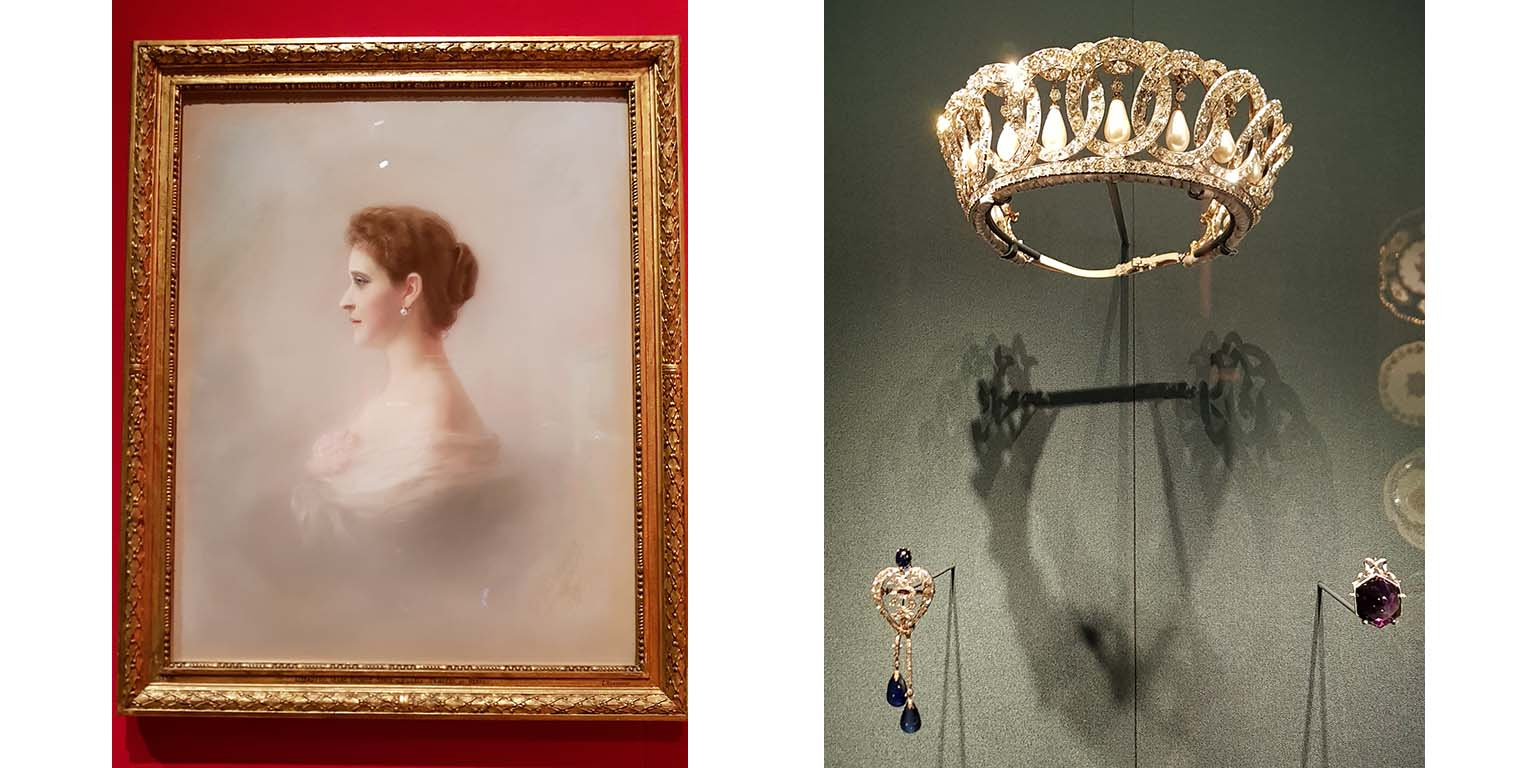Winter 2018 - 2019
CHANEL - Metiers des Arts in New York 2019
Images shot below at CHANEL by Snr. Alessandro Lucioni all (C).
The ancient world is something of a touch point for Karl Lagerfeld across the seasons, something I may have in common with him, and for his Metiers des Arts 2020 collection his sights were firmly set on the ancient halls, sunshine and life of Egypt reflected into the modern world of Chanel's international woman. The scene was set in front of the temple of Dendur (anciently Tuzis) housed in it's Manhattan refuge from the floods of the Aswan, The Met Museum of Manhattan, New York.
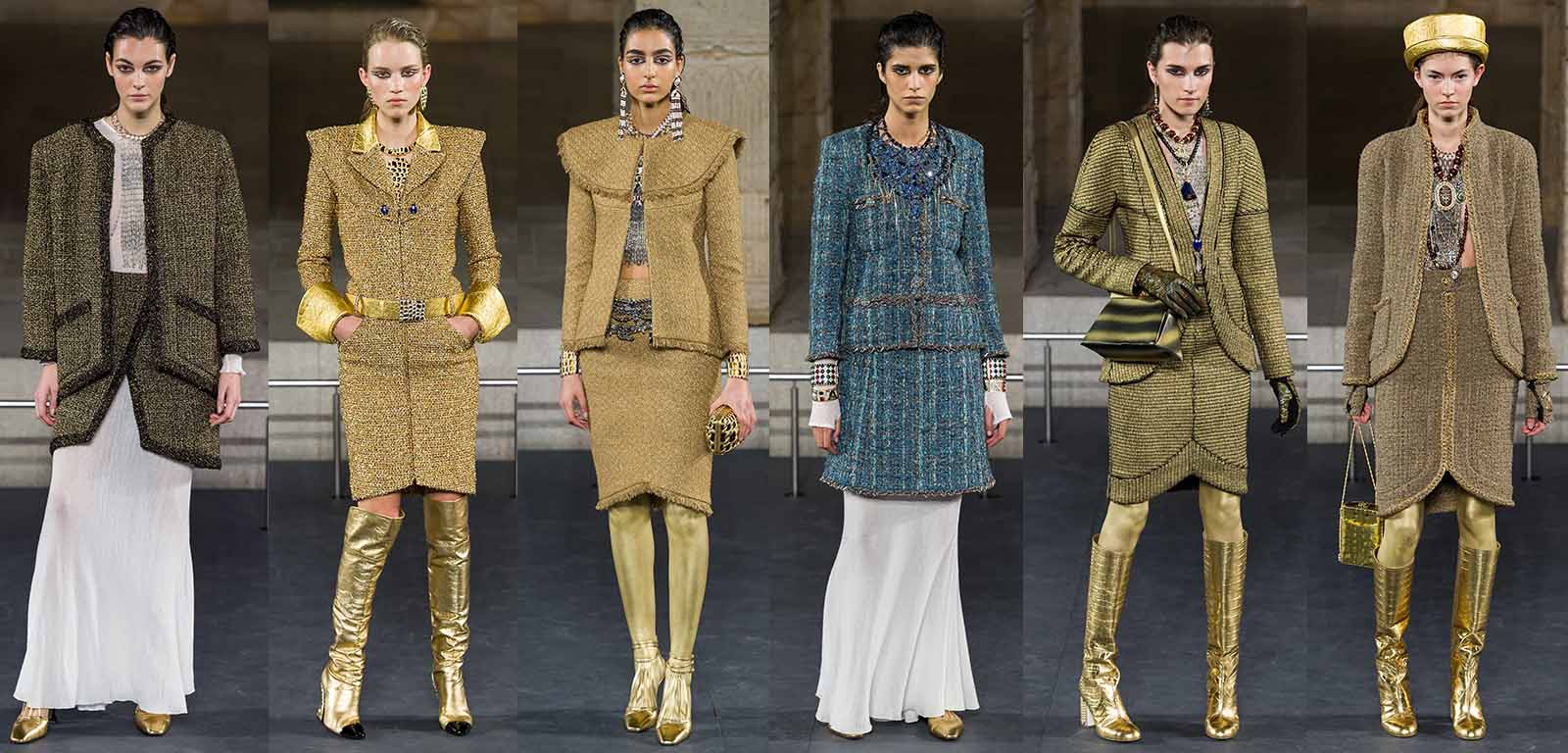
The collection opened with an earth toned woven tweed bordered at the pocket line, cuffs and seam, complimented with a wrap-around skirt that echoed the short style skirt of male Egyptian priests. Beneath a long White dress of semi sheer silk revives the appearance of the traditional Egyptian women's fine White linen dress, tightly folded in pleats that is recognisable from many Egyptian illustrations. A neckline that features a flourish of woven light coloured beads moves gently with the wearer as she walks. The magical light of the ancient country is reflected in the golden shoes worn across this range of colours. Gold was an elemental power to the ancient Egyptian and they had an understanding of the conductivity of the metal as well as it's ability to protect joints it was worn around as jewellery. To the right, a coat dress is woven with Golden thread iridescently reflecting the light. Cuffs, collar and belt shine in the brightest sunlit Yellow-Gold border a column line garment. Also featuring the rounded neckline of formal men's and women's garments and collar plates, the double layer neckline is accented by two scarab brooches that seal the look.
The circular broad collar of a tweed jacket is reminiscent of the neckline plates worn by kings and aristocracy, Woven in a rich sand it's complimented by a matching tweed skirt that rises to a small peak at a perfect perpendicular angle down the centre of the figure. This pays homage to the relationship that the Egyptians had and felt deeply with alignments and architectural precision that they applied to clothes, make-up and jewellery. The skirt is banded below the waist by hues of Lapis that are woven in jewel-like form. Beneath the jacket a bodice of Lapis like Blues are fitted to the figure like jewels woven into a breast plate. It shows the importance that Egyptians placed on the colour Blue and features in the drop earrings reaching the shoulder line that would probably be admired by many Egyptian women. A box clutch purse twinned with bracelets at the cuffs captures the pure sense of jewelled stone work that Egyptians took to heart. Blue Lapis translates into a skirt suit along classic Chanel lines with a long White under dress reaching ankle length. To the right Golden metallic threads return in force with two jackets cut in long frock coat style lines with pockets dropped below the waist. Above the knee skirts feature a central line drawn descending to the inverted central peak of the skirt. It echoes the skirts worn by priests, farmers, lords, princes and the king alike. Two blouses are composed of jewelled bead work emulating the jewellery created in Egypt and other ancient cultures long the before the dynastic period.
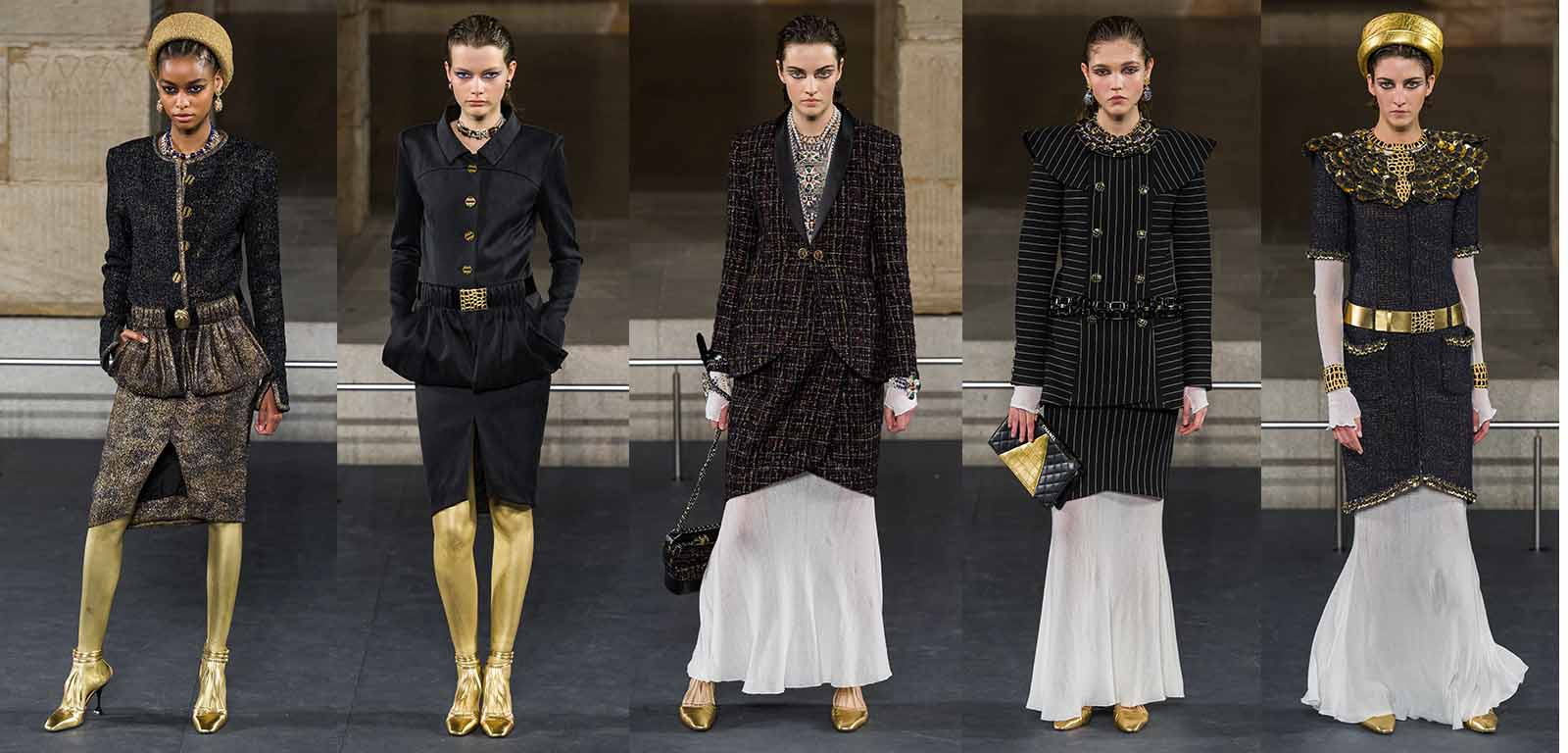
Kohl Black and Gold form a powerful aesthetic combination and the Egyptians where aware of this. Above to the left a suit jacket and skirt combination play with traditional Chanel forms with pockets featuring thick border trim descending to vintage pouch-like bags. Chevron waves of Silver and Gold metallic weave around the figure in a skirt cut open at the centre to mid-thigh. A circular pill box hat combines with the lines of the jacket to Chanel the 1930’s era when Gabrielle Chanel first began to style her classic women’s skirt suit. To the right Black silk is tailored into a beautiful shirt dress with defined collar and Gold square cut buttons and belt buckle. It hints at the importance that metal work had for the ancient Egyptians in common with other ancient cultures in Europe and Asia at the same time as an expression of both creativity and art. A wrap fold in front of the waist allows for muff-like concealment of hands during cool late summer to autumn days. Resplendent like a Goddess, her legs are seemingly liquid Gold stems like those of a statue.
The wrap skirt which Egyptologists have sometimes referred to as a kilt appears again in woven tweed with matching curved frockcoat-cut jacket and a long tissue-thin White linen skirt. Bold jewellery at the neckline signals the devotion to applied crafts of both the ancient culture and the Chanel Atelier. To the right broad pin stripes echo the traditional technique of using strips of metal found across continents in the ancient Bronze Age world and closely associated with Egypt, mirrored also in their fine pleating of textiles. The caped shoulder panel and re-think of the double breasted style to suit the alignments of this look, add to the subtle strength of the garment. Again the White linen long line under dress is present to give a string statement of identity and could perhaps be split from the suit to create two separate looks. The rounded neckline collar comes into it’s own in a jewelled addition to a dark Charcoal knitted sweater dress. Fringed with Gold boucle at the above elbow sleeves, hip pocket and peaked hemline a sheet Gold belt seals the look. An under dress of White linen reaching through the lengths of the arms to the fingers flows into billowing lengths in the skirt in tissue-White semi sheer silk. Perfect for the hot days of Egyptian sun by itself and shielding from the cool early autumn breeze in combination with the suit.
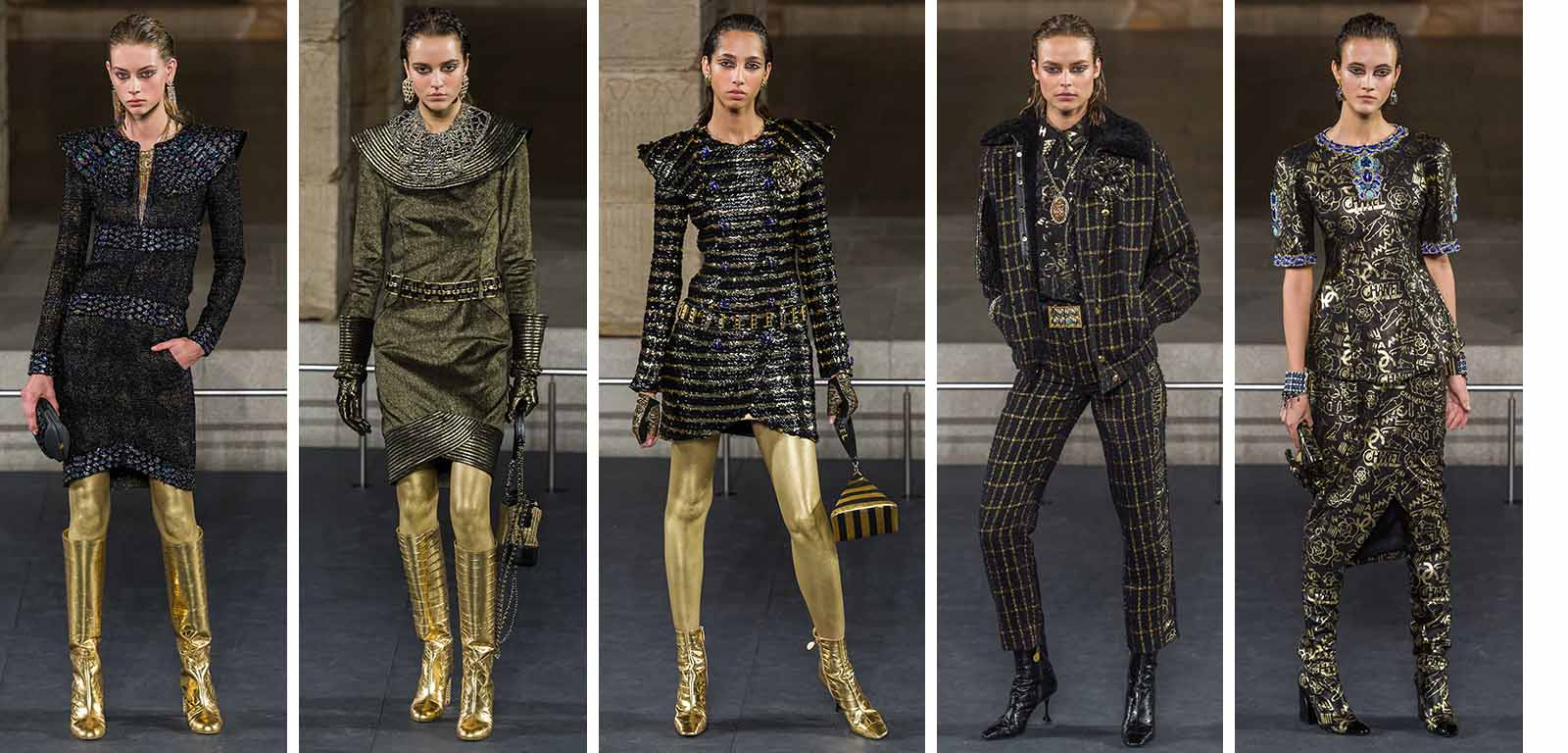
For this collection Chanel look to have created a template form of a blend of Ancient Egyptian and Art Deco style. A tunic dress created along these lines nods to Sobek the ancient crocodile god of the Nile with it’s broad ring collar and three bands in descent to the hemline and cuffs patterned with the textile print of a Crocodile’s skin. The wearer possesses it’s strength and dominance of the ancient river. Sitting lightly on the figure with a gentle give in the finely woven fabric, it partially conceals a breast-plate of Blue and Red stone jewels that reference back to the colours of jewels and paintings. To the right a Teal coloured dress nods to the rich life that is found on growing from the banks of the Nile. An out-sized dark Grey metallic collar shows the similarity between the ancient Egyptian and Celtic metal works of the second millennium bce and the strip banded technique is applied to the hand sized hem at the base of the skirt. A belt is in fact sewn into the fabric of the dress defining the waist whilst gauntlet gloves shield the wearer from chill days.
The striped lines of the famous Lapis and Gold head dress worn by eighteenth dynasty King Tutankhamen offer a starting point for the next dress with the Lapis capturing the light as the wearer walks. The wrap kilted style with gentle peak is subtly noticeable with Lapis stones and Golden metal work creating a unique special belt feature. A fascinating pyramid shaped clutch hangs from the hands of the wearer in synchronicity with the dress themes. To the right a trouser suit features a chequerboard pattern, perhaps evoking the slim-line chequer board used in Senet. It’s aviator style jacket with side angled pockets caps the outfit with a medallion necklace and richly embroidered blouse again evoking pastoral scenes of the Nile riverside. To the far right, a plethora of hieroglyphic inspired designs are written in Gold across the surface of the outfit with a border of Lapis Blue lozenges encircling the neckline, cuffs and wrists. With trousers underneath the dress it follows the recent Chanel fashion of double layering a look.
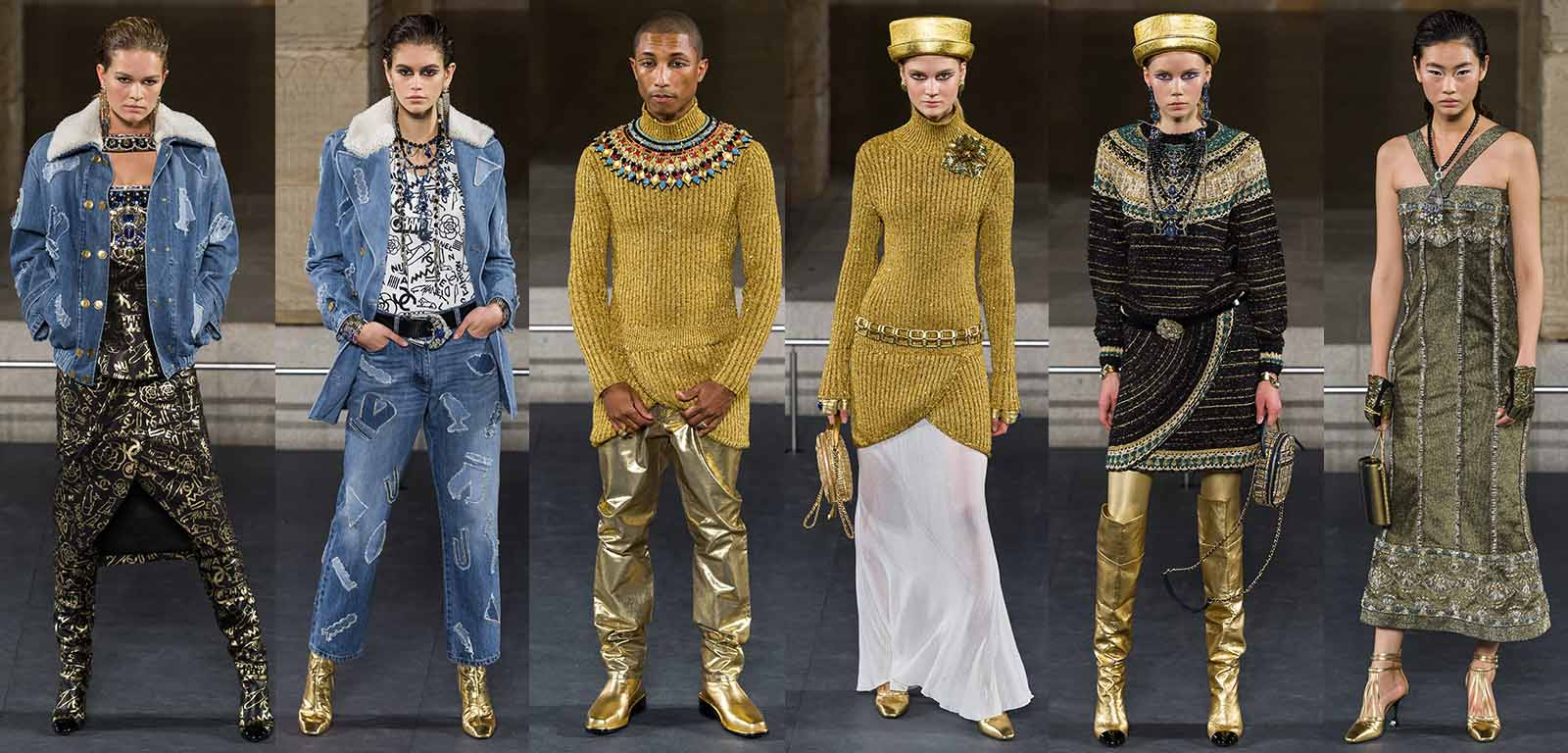
Moving the collection forward to a casual day wear segment the montage of hieroglyphs on a silk Black background of trousers and dress are teamed with a denim jacket cut in aviator style complete with a broad lapel collar. The surface of the jacket is adorned with denim hieroglyphs quilted on to the surface of that garment. This wearer is part of a cool gang, a thinking gang with a taste for cultural exploration. To the right a blend of jeans and a White print blouse match hieroglyphs with the symbolic language of Chanel created in it’s own glyphs. A longer jacket shields the wearer from the warmth a little more fully. Clothed in Gold Pharrel and a female model walking after him bring the tunic dress and cut away wrap skirt together each combining with trousers or a long White linen skirt. The shimmer of Gold is slightly muted to give an earthy feel to this heavenly element. A necklace banded in layers of semi precious stones surrounds Pharrel in the stratified style and this narrative is echoed in the Black sweater and wrap skirt combination to the right that also has faint hints of ancient Celtic dress. The linear styling of the cape again reflects the iconic Bronze Age jewellery design worn by men and sometimes women, as far as recorded history lets us see. Chains of amulets and earring featuring scarabs carved from pure Lapis Lazuli hang in perfect symmetry. The wraparound kilt skirt in matching fabric sits over Golden leggings and boots. A teal coloured dress shines with metallic lustre framed in precise geometric alignment capture the elegant feel of Art Deco. It’s an elegant choice for a late Summer, early Autumn party or press call
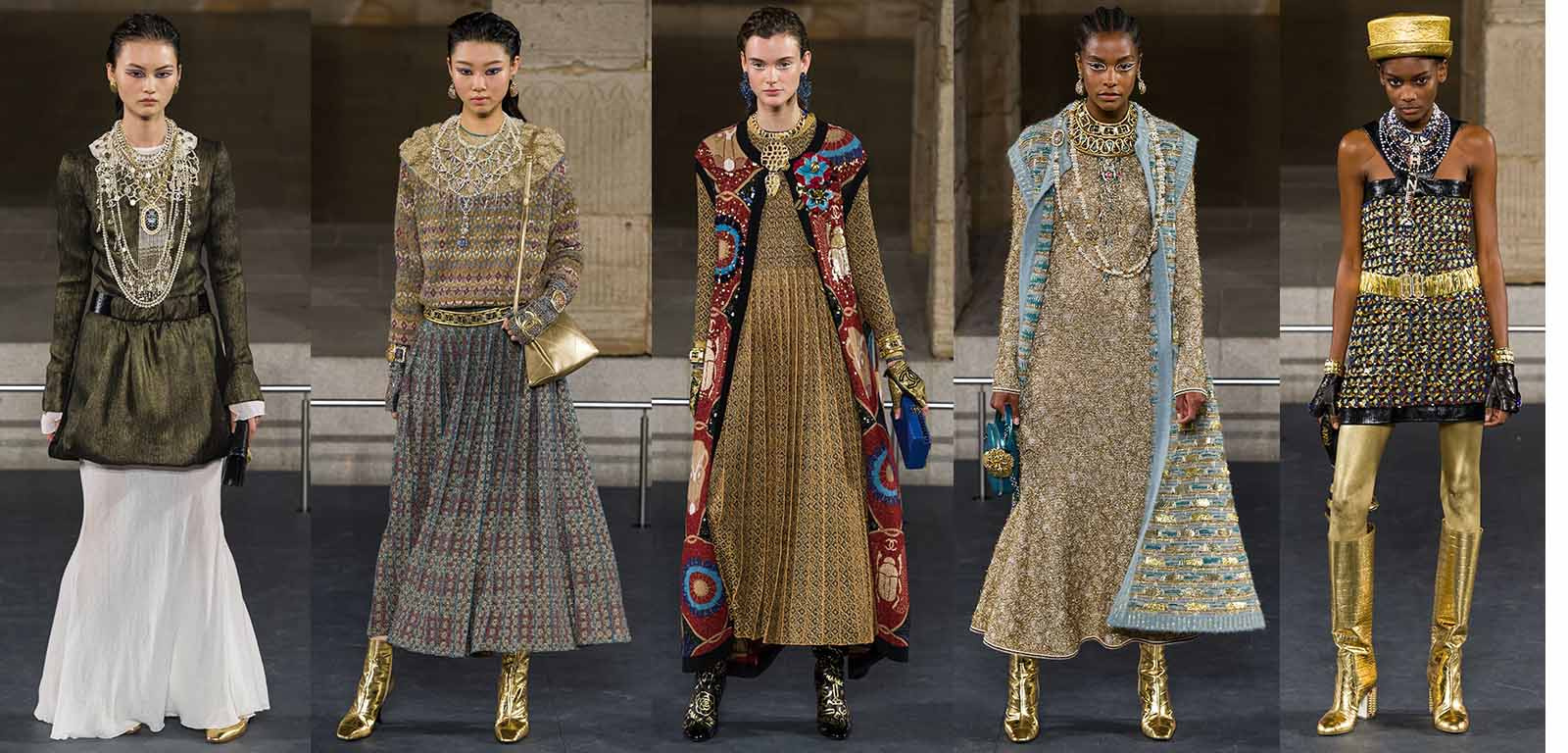
A Metallic tunic dress with long sleeves and White linen cuff I paired with a loose long flowing White shift dress. It brings echoes of ancient Egypt before your eyes with a re-worked twist. Chains in Silver and Gold decorated with coins are off-set by a large scarab amulet. The key theme of ancient jewellery is transposed onto layers of delicate fabric as tessellated shapes in soft metallic colours run down through the lengths of a blouse and a skirt. The sense of the Egyptian relationship to geometry was carried further by a triangular shaped handbag in fabric with the appearance of sheeted Gold and the familiar quilting of Chanel.
Intricate woven thread in Gold forms the structure of a beautiful dress woven like sheet metal referencing the skill, craft and care of people of the ancient world. In contrast it is overlain by a sleeveless dress coat that sees the colours of heaven and earth as depicted in Ancient Egyptian art translated to fabric with Scarabs siting alongside interlocking Chanel C’s, Lions heads and the ever moving wheel of heaven. The ripples of the Crocodile skin are etched into double circles of Gold hanging from the neckline in a piece of jewellery that simultaneously speaks to the themes of the ancient and modern world. Hieroglyphs of Gold, that intriguing early writing wind their enchantment across the surface of Black boots. Blue and Gold where familiar colour combinations across the history of ancient Egypt and Chanel combine them once again in an above ankle dress. Shapes of flowers weave across the surface of the piece that features a fluted hemline cut in length also in the sleeve to ensure warmth for the wearer. The lozenges in Gold and Light Blue adorning a long line knitted jacket bring the light flecks of colour of the Egyptian early morning. The theme of traditional woven textiles appears once again in a mini dress to the right above showing the simple elegance of the millennia old weaving technique that the Ancient Egyptians inherited from more ancient trans-continental ancestors.
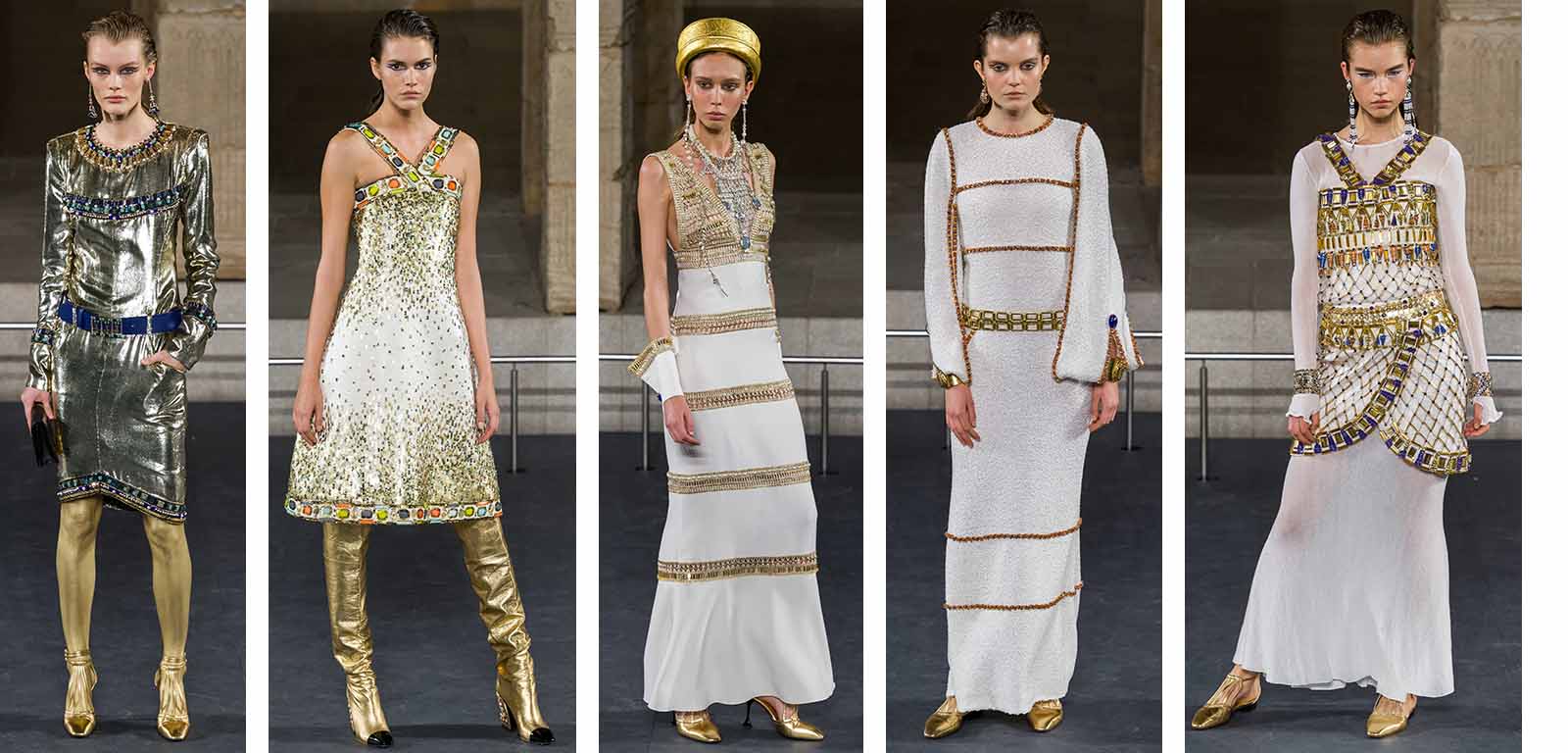
Metallic lustre shines from the surface of the next dress with a Platinum garment banded with Lapis Blue and Yellow, Aqua and Light Blue stones. It captures the traditional aesthetic of Egyptian colour expression for a look to hit the town in. A beautiful White mini-dress flecked with Gold adapts the aesthetic of Chanel classics and the ever so slightly rough cut stones lozenges bordering the straps, neckline and hem. It’s a dance floor or drinks party ready look that sits just below the knees in an easy to wear style. Gold above the knee boots give it an extra sense of gilded glamour but the dress could easily be worn without with fine tights or stockings.
The ever present White linen of dresses remembered in Egyptian art is present in spirit in the next three dresses. Jewellery and design combine into one as a bodice a framed from Golden spindle sewn together just as a necklace would be. A necklace itself is actually worn by the wearer in a contrasting Silver tone to the Gold that adorns the dress. The lines of the metal hint at the coded elegance and decorum of being that both ancient Egypt and Chanel have in common. The necklace falls to three points highlighted with beautiful aquamarine stones. Tiers of pristine White fabric are defined by Gold borders, sewn and jointed in the style of jewellery descend through the garment. A long line tunic dress with sleeves is banded with Gold brocade briefly breaking the line of the fabric. A dual layer of White porcelain oblong cut stones circle the waist in a belt and two scarab Beetles mark the high point of the cuff at the upper wrist. To the right enamel and Gold work feature strongly in the detail of a bodiced dress that descends to a kilt-style skirt around the waist. Oblong block of Gold and Lapis Lazuli cut with a slight imprecision to honour the memory of ancient crafts people. A sheer White muslin dress runs the length of the figure as an under-dress to the jewelled outer garment.
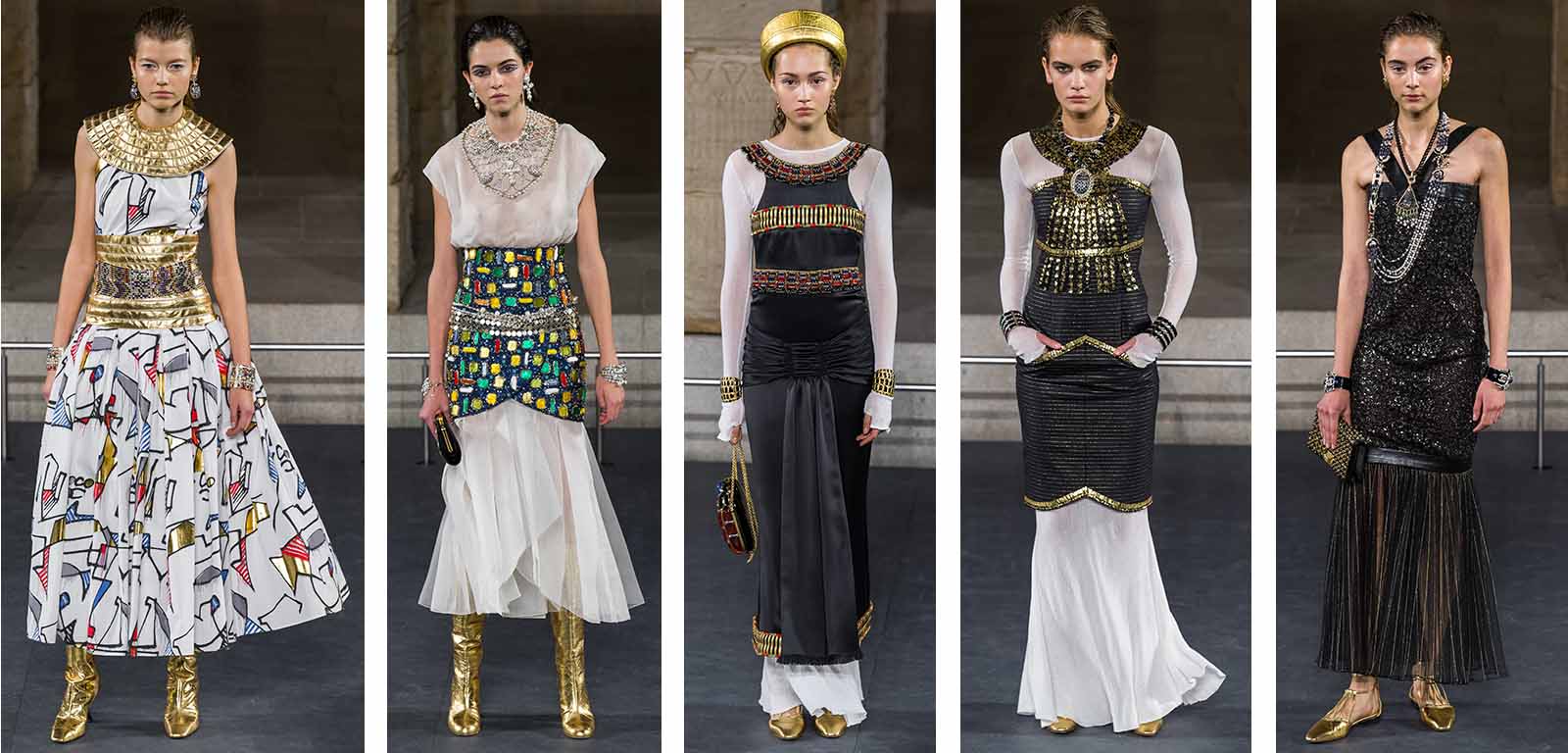
It’s an interesting game to play in childhood, to try and invent your own language, your own hieroglyphs and above to the left, an abstract interpretation of the ancient Egyptian script. The coloured shapes rush across the surface of the dress in a swirl of incantation. A broad collar is formed in quilted Gold fabric and a waist band in composed of tightly banded beads bordered by quilted golden silk above and below. The next look features another play on the classic sheer linen shift and I can’t help thinking that the bold multi-tonal colours of the fitted outer corset would have held strong appeal for the ancient Egyptians themselves who loved the brightness of colour set against the earthy neutrals of their land. The sheerness of the dress itself although daring to our eyes, is something that would have felt familiar to the ancients in both Egypt and neighbouring Crete. A jewelled metallic necklace hangs gently from the neckline echoing the circular form of traditional neck plates.
The wrap of the traditional priestly skirt also worn by Egyptian Lords and Kings is incorporated into the several skirt lengths in the frieze above. A Black silk dress is banded through the bodice with jewelled borders of Black, Red and Gold with metal work that would win the heart of the ancients. They admired skill and craft, for the Egyptians, several Gods including Ptah felt that work ‘was the balm of the heart’. It was good for people. A sheer White under dress makes the perfect match the Black outer layer and the statement Scarab clutch purse could be the surprise accessory hit of the season. A knee length panel sewn garment works with the strength of geometry as it’s guide. Another Egyptian principle much in tune with the decorum of the house of Chanel. To the right a Black dress leans more towards the Art Deco movement of the early 20th century with hints of the 1920’s party girl. Again the pleats and sheer fabric reference the fine linen of treasured by Ancient Egyptians across thousands of years.
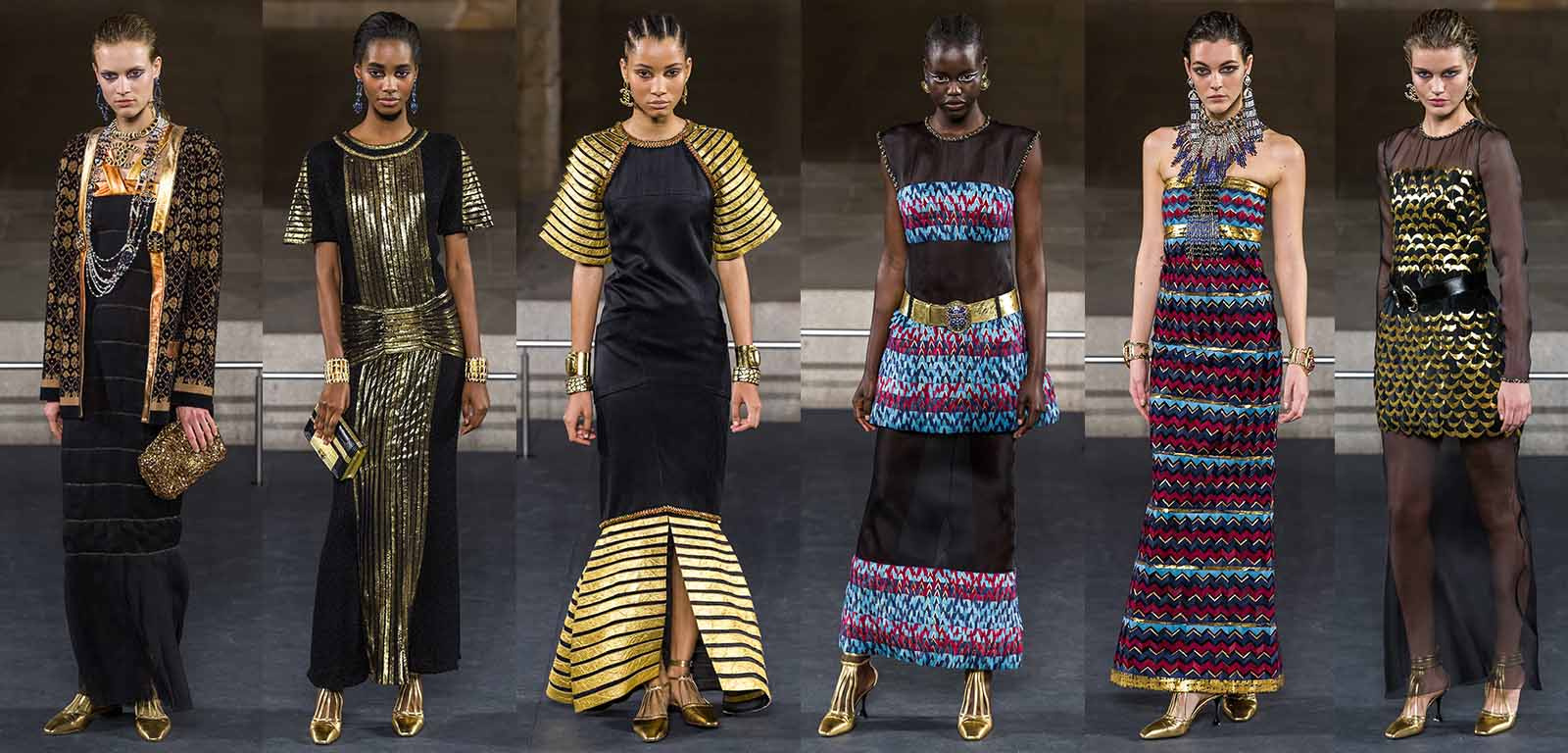
A jacket and dress a far from conventional with a Black column line style enhanced by a boldly patterned cardigan jacket. An out-sized Golden box clutch takes the look to the next level with a bold contemporary twist. Lineal thin strips of gold descend the figure from neckline to hem down the centre of an outfit and encircle the waist in a bisecting contrast. The sense of order and precision enhanced by placing Black on top of Gold is achieved in a subtle sweep of harmony. The Gold banding used in statuary of Ebony carved figure is transposed into the next outfit with sleeves and an open split fishtail skirt echoing an earlier shown kilt skirt split.
A fresh take on the bold colour ways (as we call them today) of ancient Egyptian art, itself strictly controlled by priests over millennia, appears in a sheer Black dress with bold colour formed in three broad bands from bodice to hemline. A bold Golden belt with a Scarab buckle roots the piece firmly in the traditions of the past. To the right the same bold geometric zigzag print in Light and Navy Blue, Purple and Red off set with ribbons of Gold encircling the figure. Beadwork is present in the necklace and earrings again nodding to 40,000 years of ancient Eurasian culture, adornment and expression of personality. To the far right to close with a piece of sheer brilliance that channels both the magic of simplicity of Chanel. A Black sheer shift is overlaid with a mini-dress with Golden waves of the fish scale. The ancient Egyptians believed that life had risen out of the primeval ocean-like darkness and from here they raise their goddess to walk confidently in the world for pre-fall 2019-20.
Alexander McQueen Museum
All images shot by me (C)
Atop the beautiful Alexander McQueen boutique sits a museum that anyone can visit as they explore the store, in fact they are very happy for you to visit solely for the purpose of seeing the museum and the behind the scenes life of the atelier. This was something that I dreamed of and hoped for when I first began writing about fashion 8 or 9 years ago. I wanted the creative process to be unveiled, for people to think more about craft and appreciate and see the work that was created and bring the glamorous dresses and outfits shown before the camera to be brought into context with hours of work in design and finite attention to detail required to make something that would be truly superb.
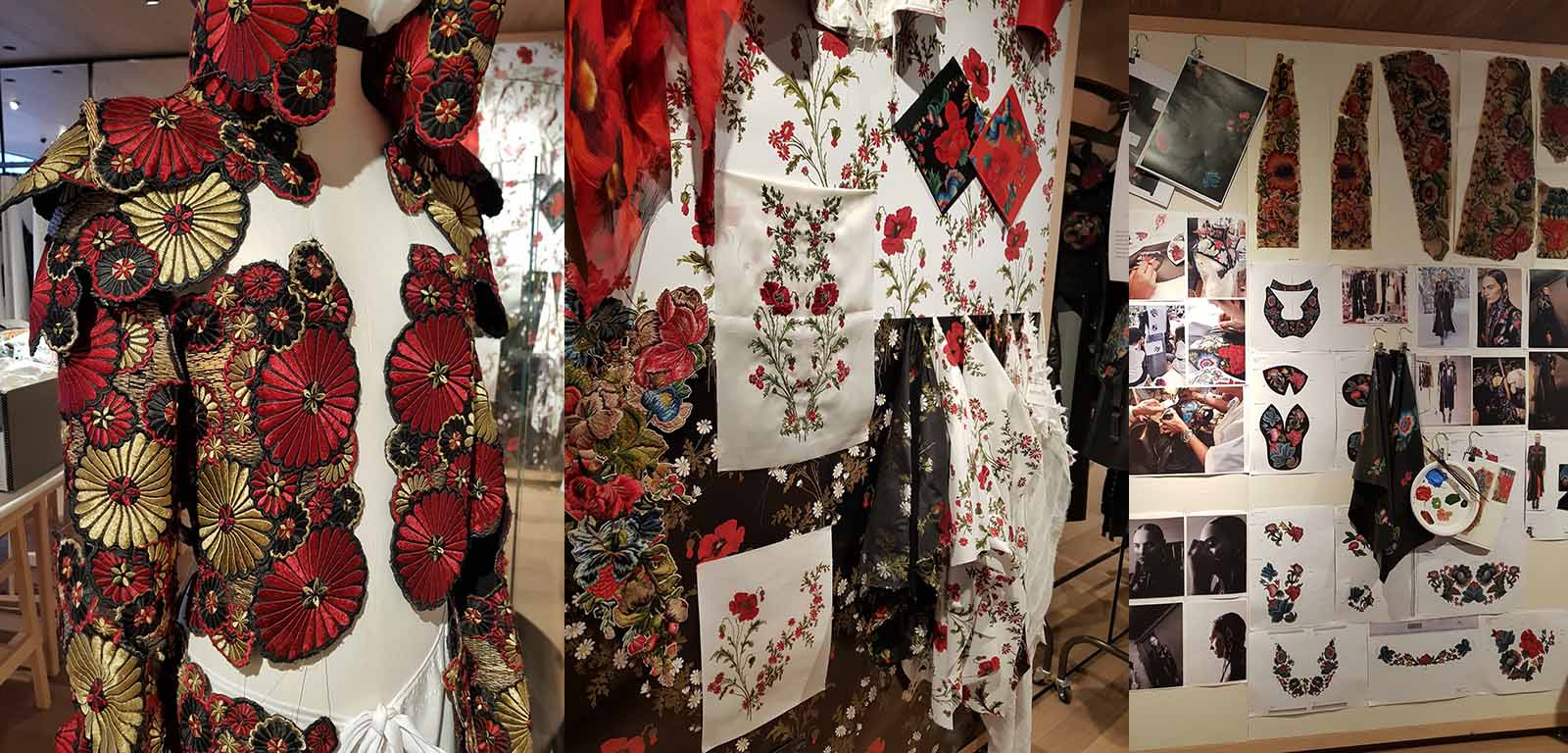
It’s an Aladdin’s Cave of creativity and what’s even more engaging is that the display changes every 3 months to show more work that is relevant to current and recent collections. It’s a moving, living breathing museum of life. A jacket is emblazoned with rosette wheels echoing the form and shape of ancient Indus flower wheels in carvings. The contrasting Red and Saffron draw the eye and a high collar and a double tiered shoulder provides a convenient way to show more detail in the garment and this piece could be worn with a chemise and trousers perhaps to create a suit effect. The ability to get close-up enables you to see the detail and work that is involved in creating these pieces. Centre above a mood board displays numerous bespoke fabrics in brilliant colours alongside the original water colour prints designed with the minutest detail taken into consideration. The fabric samples are highly desirable in their own right. Strong colours enhance a confident feeling beauty. A mood board to the right hints at the research behind the designs and includes both early design drafts and looks from back stage at the collection shows.
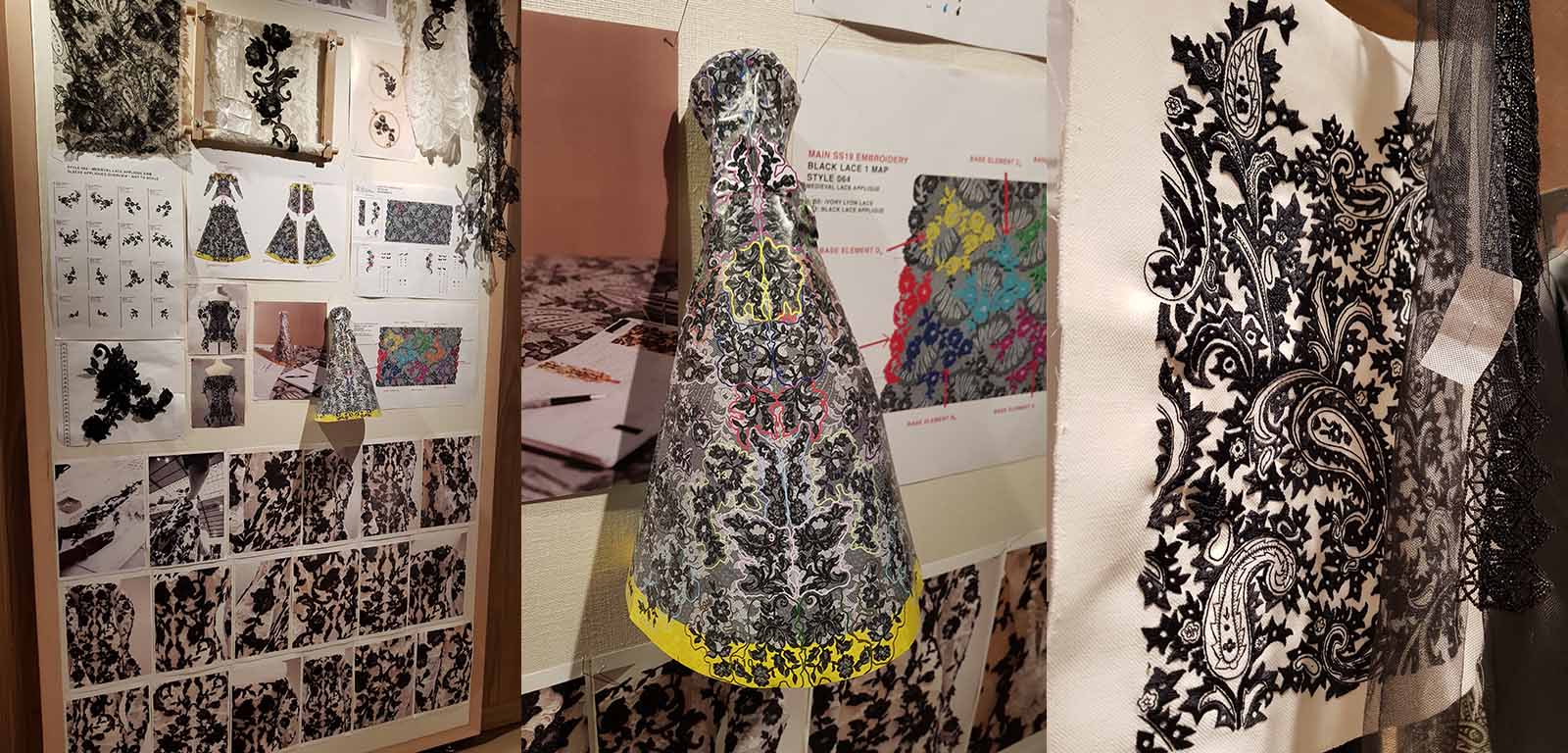
A series above shows the stages of realisation for a fabric design. First digital designs are modelled into paper-card cut out shapes and from here the designs are mapped using coloured segments to illustrate difference in form and style. The full piece will be in Black but it guides the eye of the artisans so that they can clearly see the individual detail of the component parts. Small pieces of lace are created and then one by one panels are sewn that will eventually be cut and formed into the lengths of the dress. For anyone with more than a passing interest in design it’s fascinating to see the lace embroidery in close up. They still sew onto the traditional hoops that allow the fabric room to breathe and stretch. To the right below the final dress is shown front and reverse and giving the chance to appreciate the full completed piece. It’s a delicate look that would be accessorise easily with a wrap or jacket to fend off cold breezes.
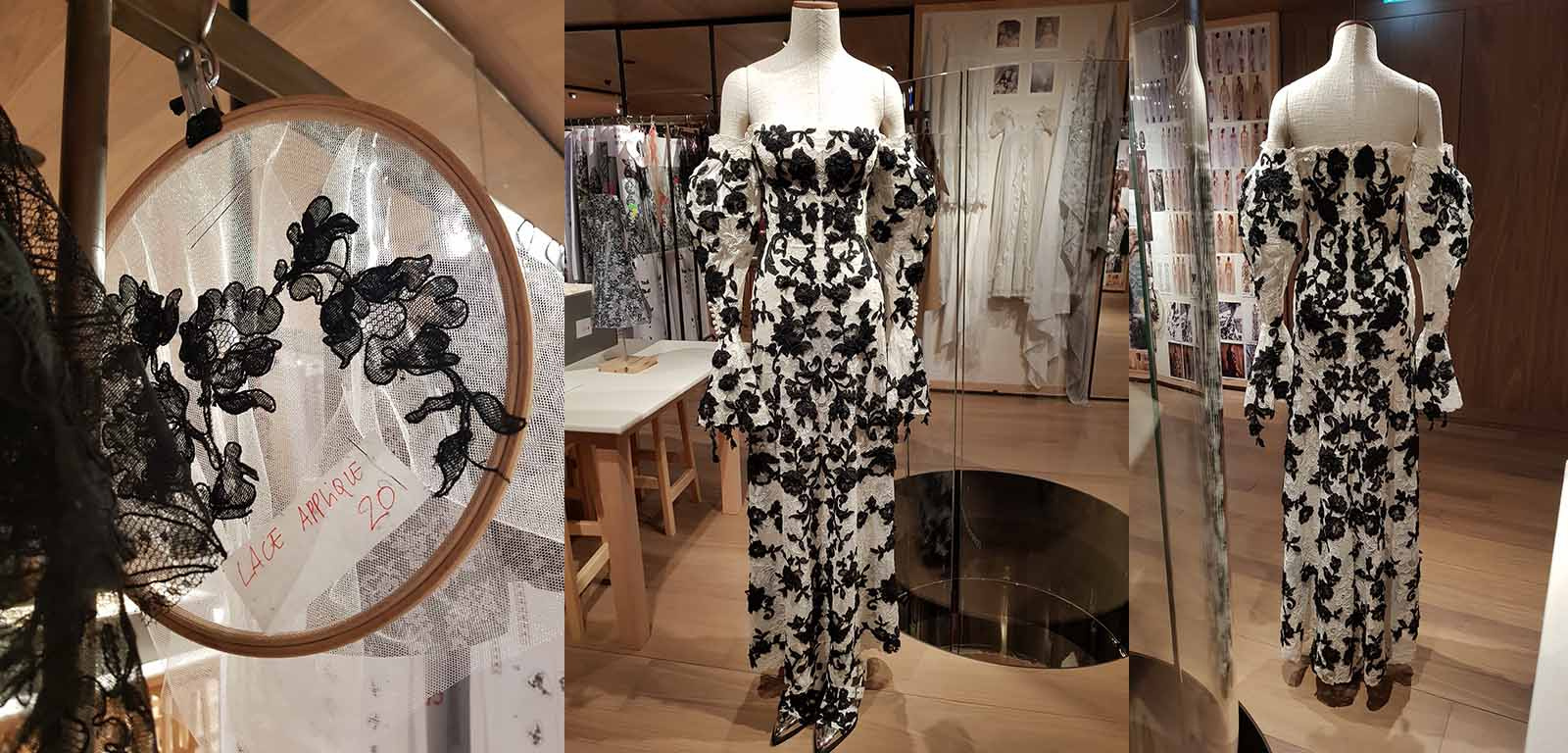
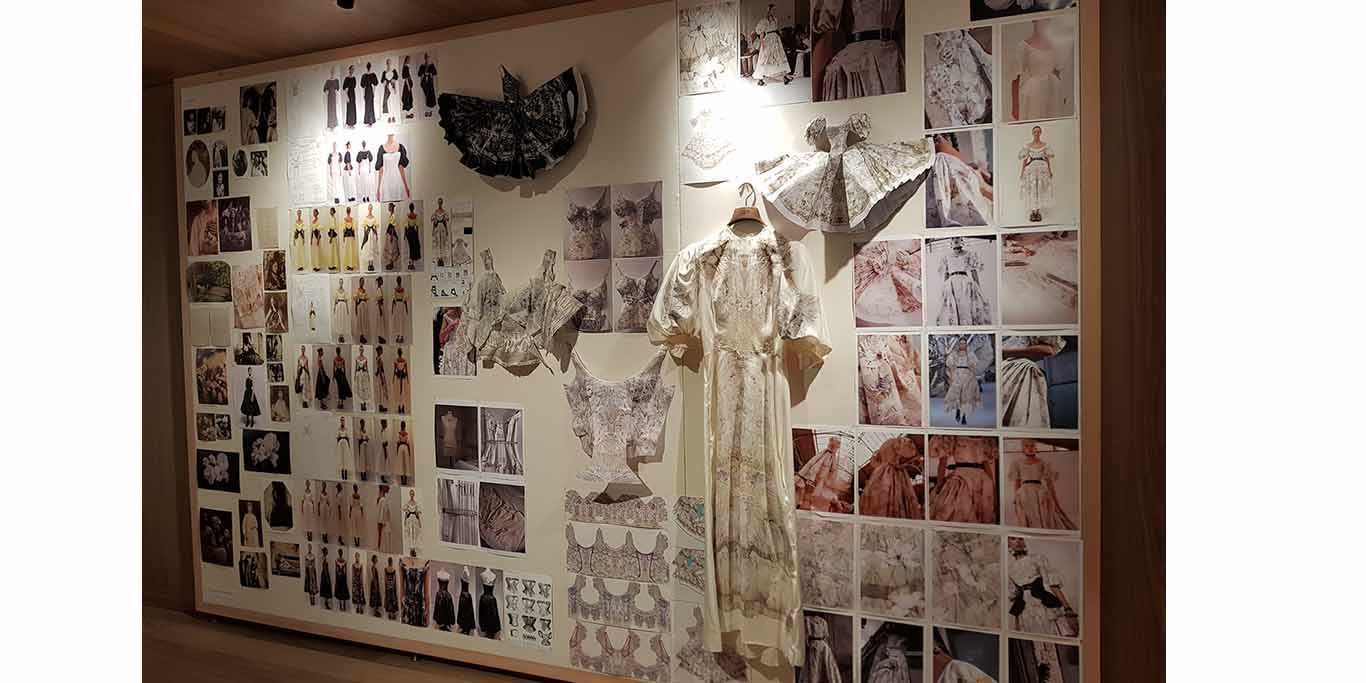
A broad angle look at the mood board shows further design output with a full length tableau showing the layers of garment preparation that take place before a final piece is completed. The work of the atelier is never simple and the dresses that are bought by clients take many hours and a lot of care to construct. The result is a piece that is as much high fashion as a work of high art. Several contrasting designs are featured. A Black lace dress, a fitted corset piece to be part of a dress and an intriguing piece featuring a very complex house print show the eclectic array of designs and commissions that the McQueen atelier could be working on at any one time under the watchful gaze of Sarah Burton. From 3D working model to completed final dress it’s an irresistible draw for anyone with more than a passing interest in fashion. The upper part of the dress can be seen in close up to the left below. On first look I even wondered if the designs may be composed of antique maps such was the complexity of the faintly traced lines. Centre below a dress is illustrated on a wall screen in a fanned out moth like appearance. In front of it a dress cut into deconstructed lines of the 18th century mantua dress telescopes the broad frame of the hips to a narrower silhouette. The complexity of the design detail is contrasted with the broad White hem of the dress to provide a break and a balance from the design. To the right below a rail-shot includes both dresses and fabric giving an impression of the varied stages of ‘work in progress’ that run through the life of the atelier.
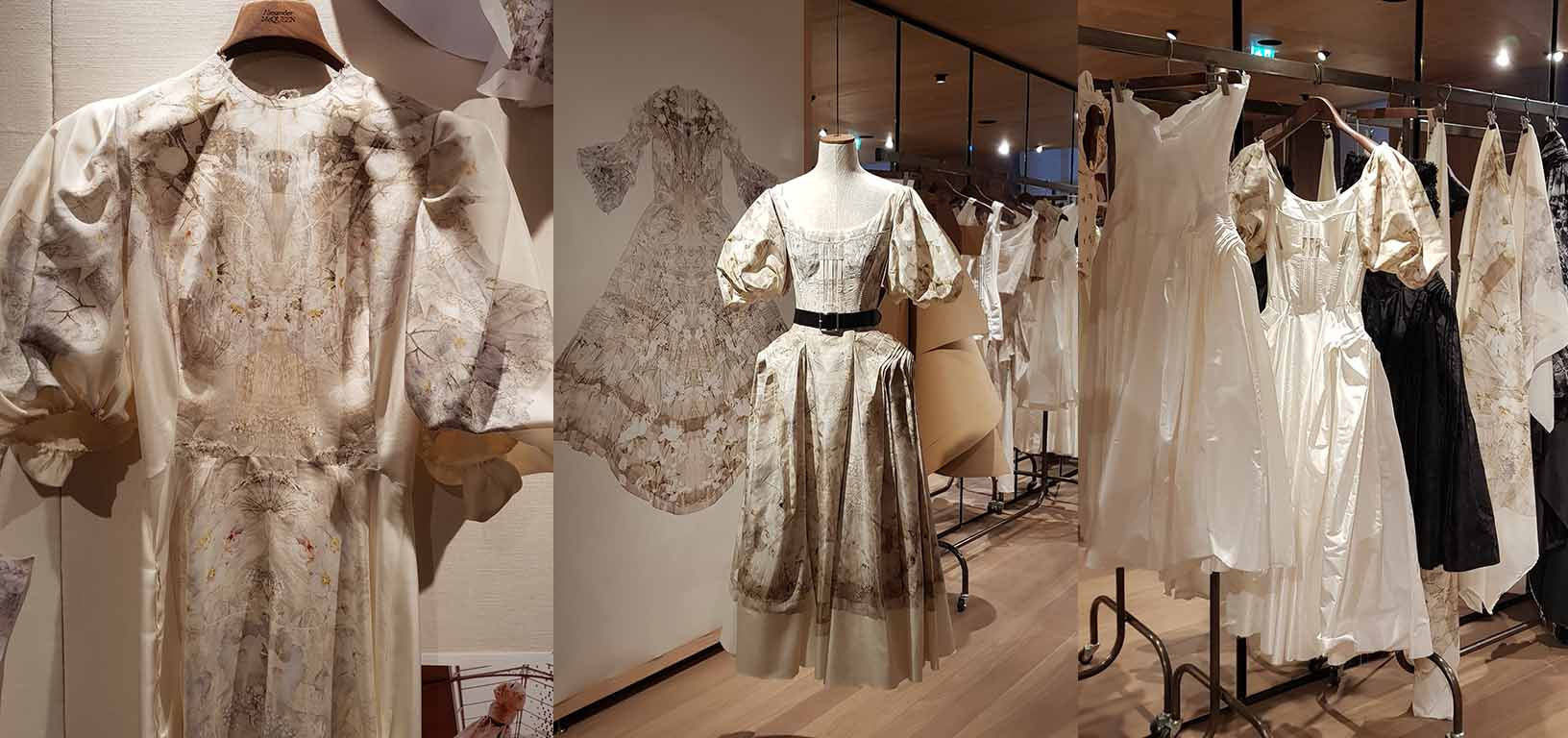
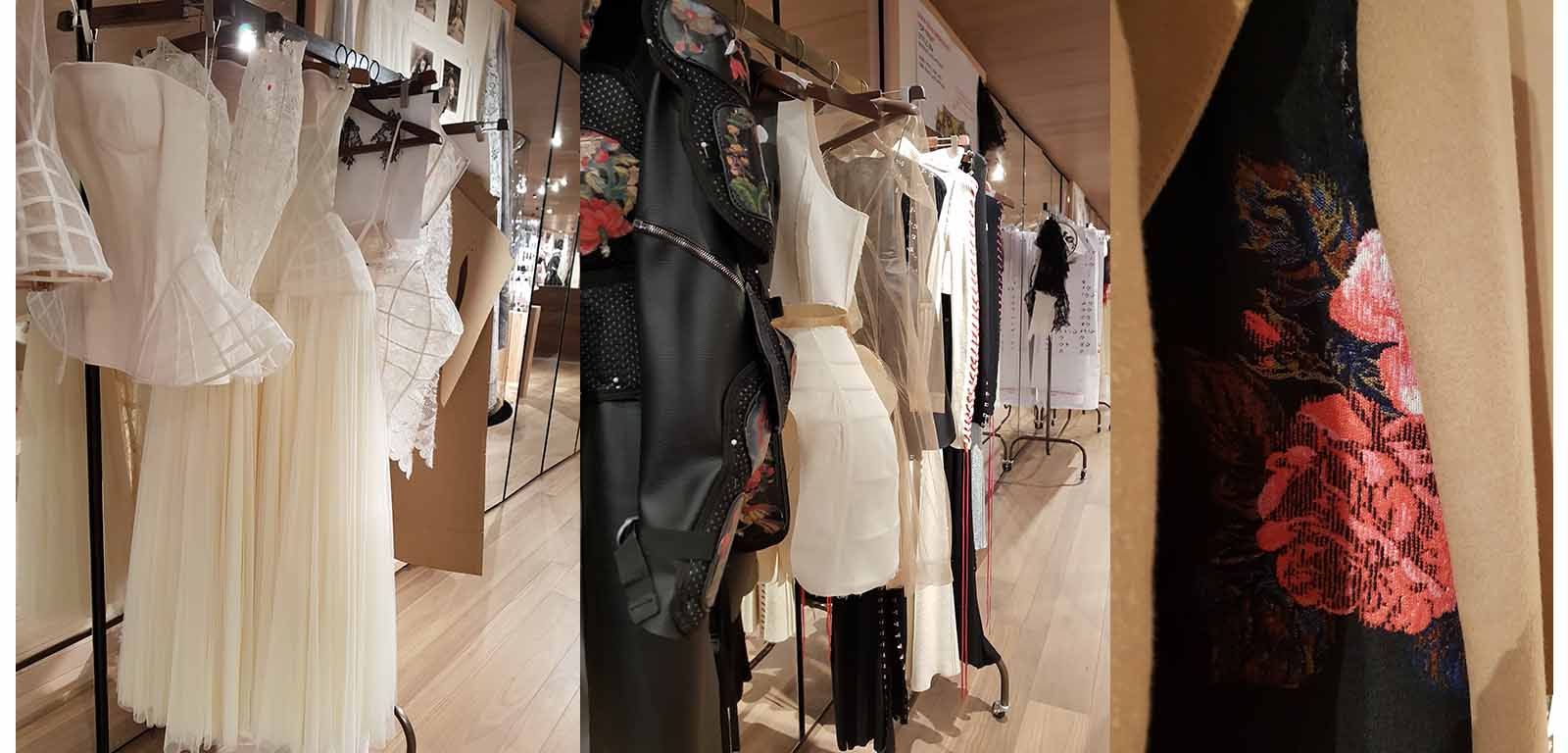
It’s fascinating to stroll through the long gallery seeing the rows of partly made garment sitting, perhaps a little ghostly on the rails waiting for the caring hands of their creators and the eventual distribution to shop floor or direct to end client. Seeing the fabrics hanging and the toiles, I’m a fan of toiles and think everyone should have the chance to see more if they’re curious. There’s a quiet beauty to these pieces and some brave individuals may choose to wear them as a finished garment. It’s the precision of the structure that is so appealing. To the right a close up of the embroidery detail as would be intended for a garment. There’s something precious and endearing about this simple style of stitch embroidery that people have added to clothing and accessories since at least the Tudor era.
Below a further close up of a mood board shows the referencing to the late 19th and early 20th century era of sepia family photography that where drawn on for inspiration. Studio fitting are shown alongside drawing the past and present together into a sewn whole. Centre above a life sized paper construction of a garment signals the time and meticulous care to detail that is behind the creation of works that come out of the McQueen atelier. It’s the unseen that shows the need for artisan skills and, I pray that we can re-establish a base of home grown design talent that we had in this country in the past. A charming circle of paper cut-out designs, which I think would be collectable objects in their own right amongst the artisan admiring crowd, illustrate the sharp attention to detail.
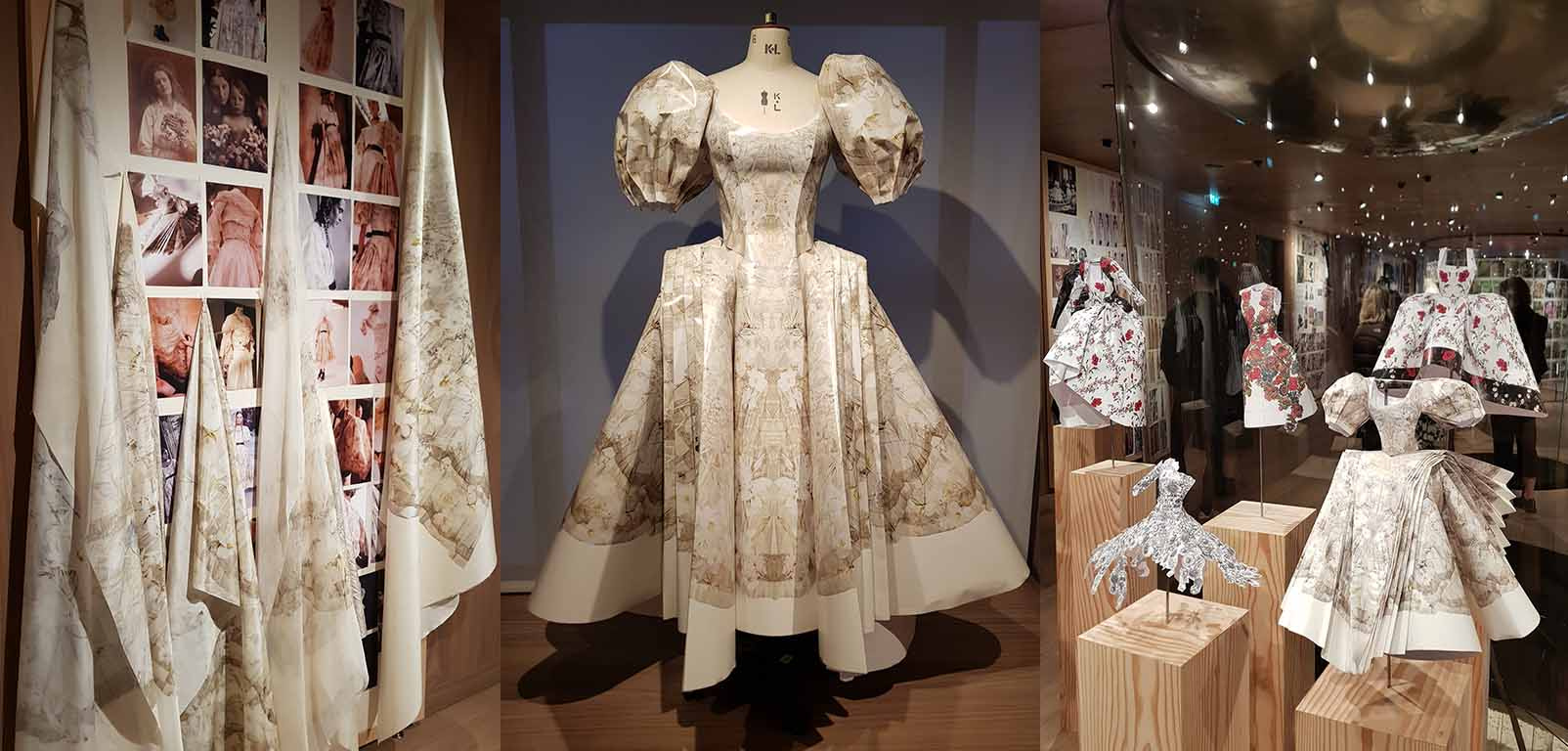
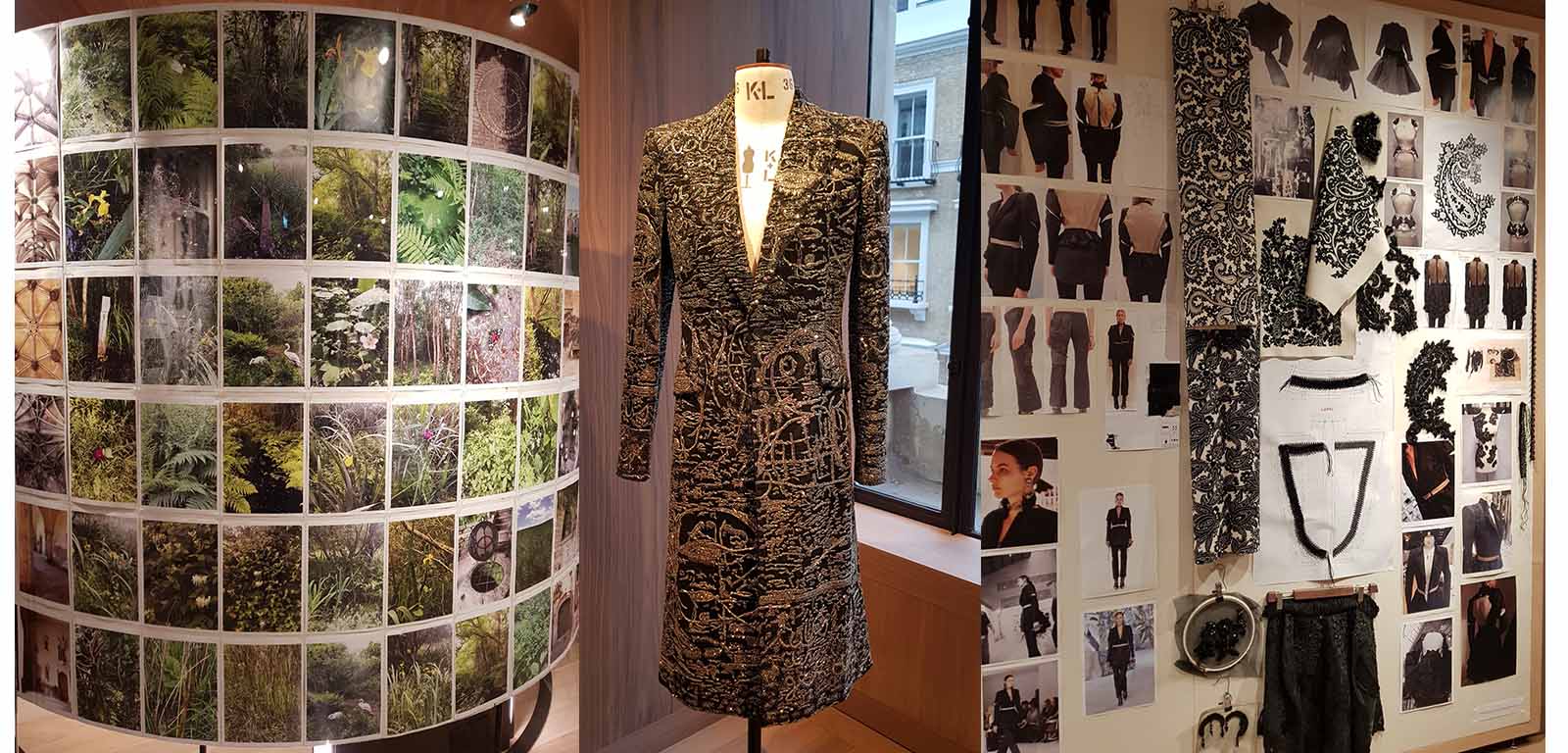
Nature elements form a key area of inspiration in many of the collections lead by Sarah Burton. Rural scenes of ferns and leaves capture a sense of fresh new life but the past must never be forgotten. Complex nature-inspired patterns in Gold thread are woven in close style across the surface of a Black slim line jacket that could easily be paired with trousers or a dress. Mood boards are at the heart of the design process alongside the hands on draping, cutting and sewing. The repertoire is extensive and fascinating. To the right below a lace covered Charcoal blouse is pared to Midnight Black trousers to create a contemporary lounge suit. It’s a perfect Red Carpet look.
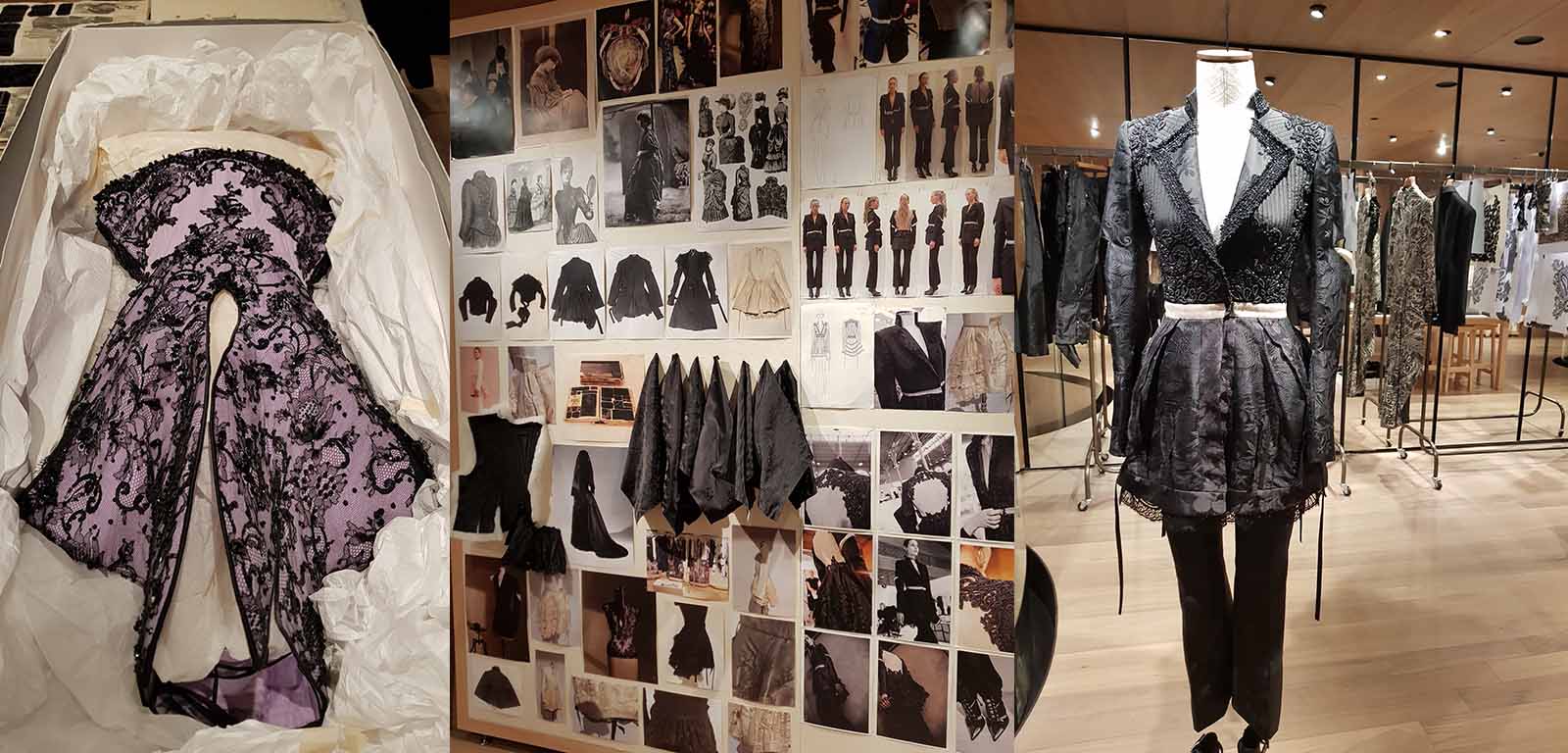
Placed in the heart of the luxury shopping district the House of McQueen has it’s doors open to all and it’s making a conscious decision to let the world know that anyone can come and see the clothes and learn about what they do to create them. The price point may not be for everyone but the detail shown of the work of the atelier tells you why this is. With VAT and countless commercial pressures faced by all businesses they need to compensate a highly skilled workforce and ensure that the quality of their output is second to none. The McQueen aesthetic is complex and unique and outlines the traditional commitment that this country has always been known for in skilled, careful quality workmanship.
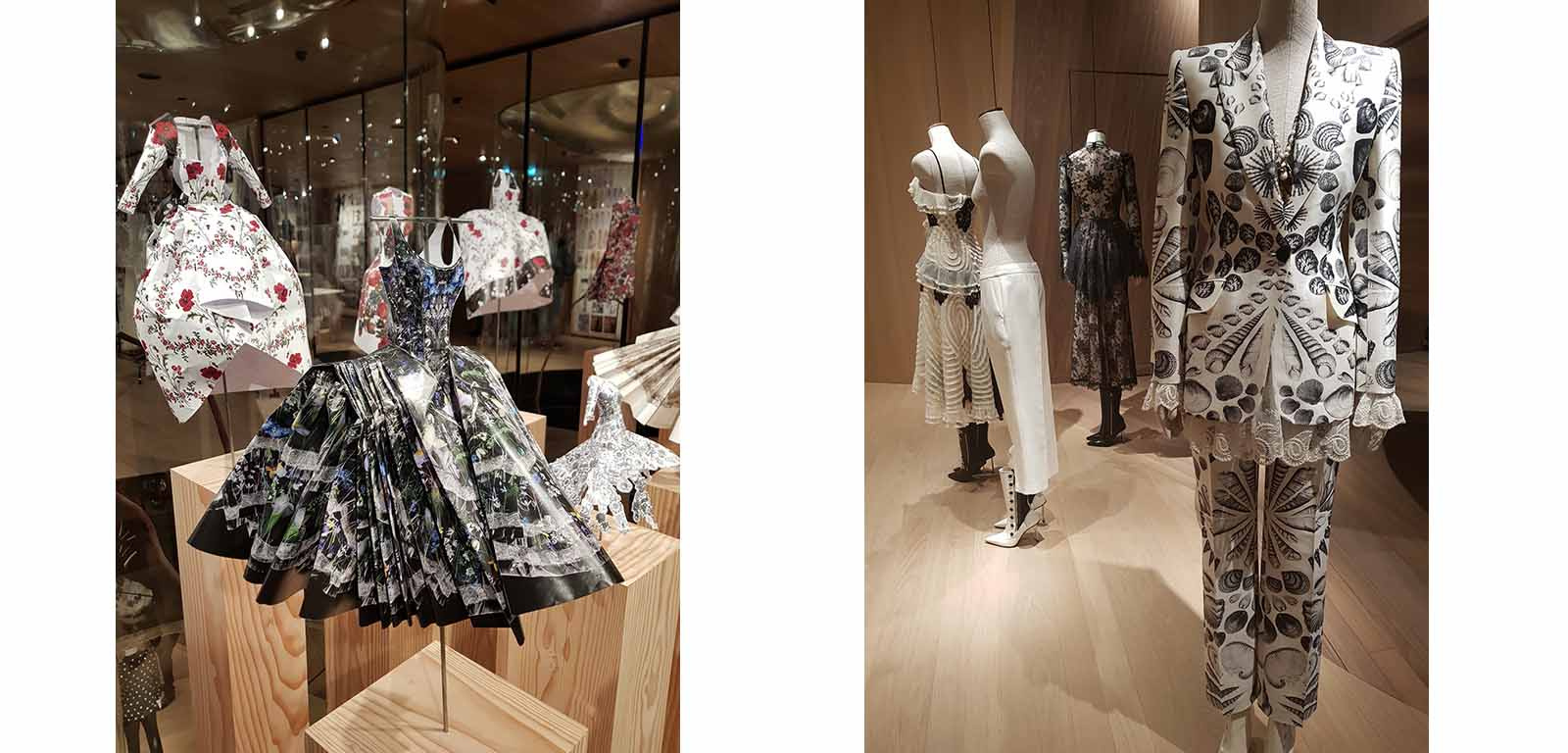
Christian Dior: Designer of Dreams at the V&A
All images shot by me (C) with permission of the V&A press team.
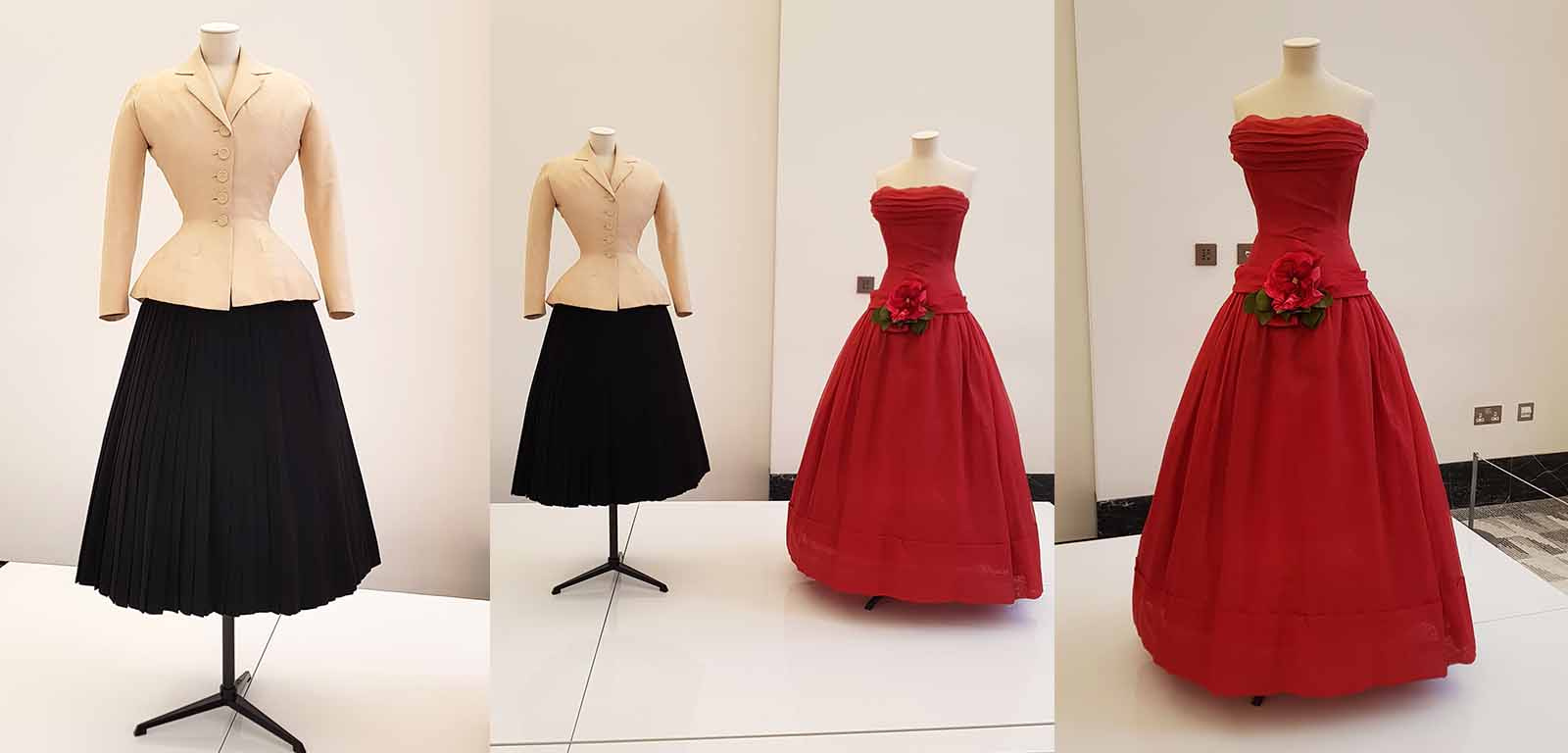
To herald the new exhibition, the classic lines of the Bar suit where brought to us in an original piece form the house of Dior displayed in contrast with a Scarlet dress tied with a Rose sash at the waist creates a harmonious duality. Dior had very traditional ideas for the dress of women and the tiny fitted waist would have required alteration for many clients. Christian Dior however, was determined to make his mark in the post-war high fashion world and this style soon became a template for post war glamour in a desolate post-war creative landscape. Bringing Dior to the halls of the V&A seems very long overdue and the museums palatial beauty offers a natural sympathetic backdrop to the collection.
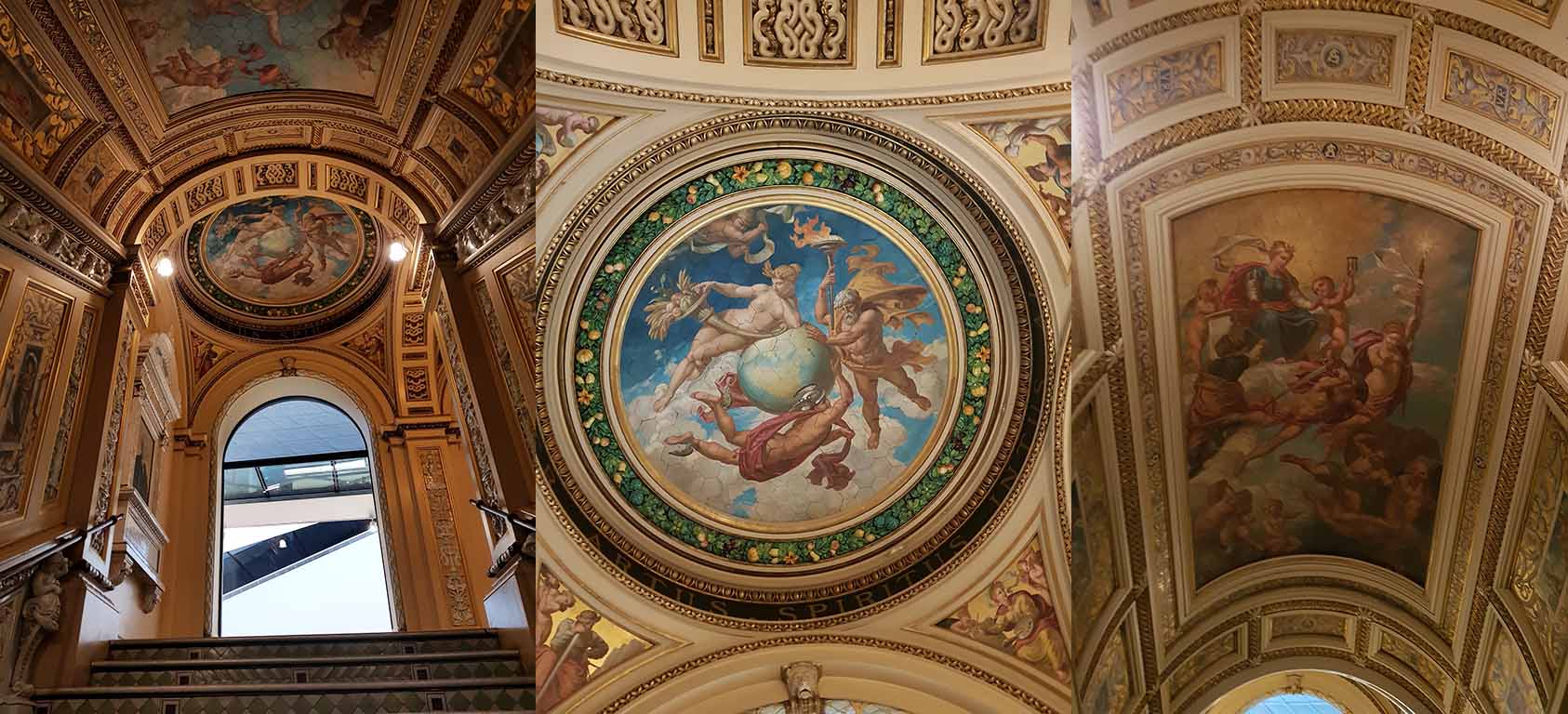
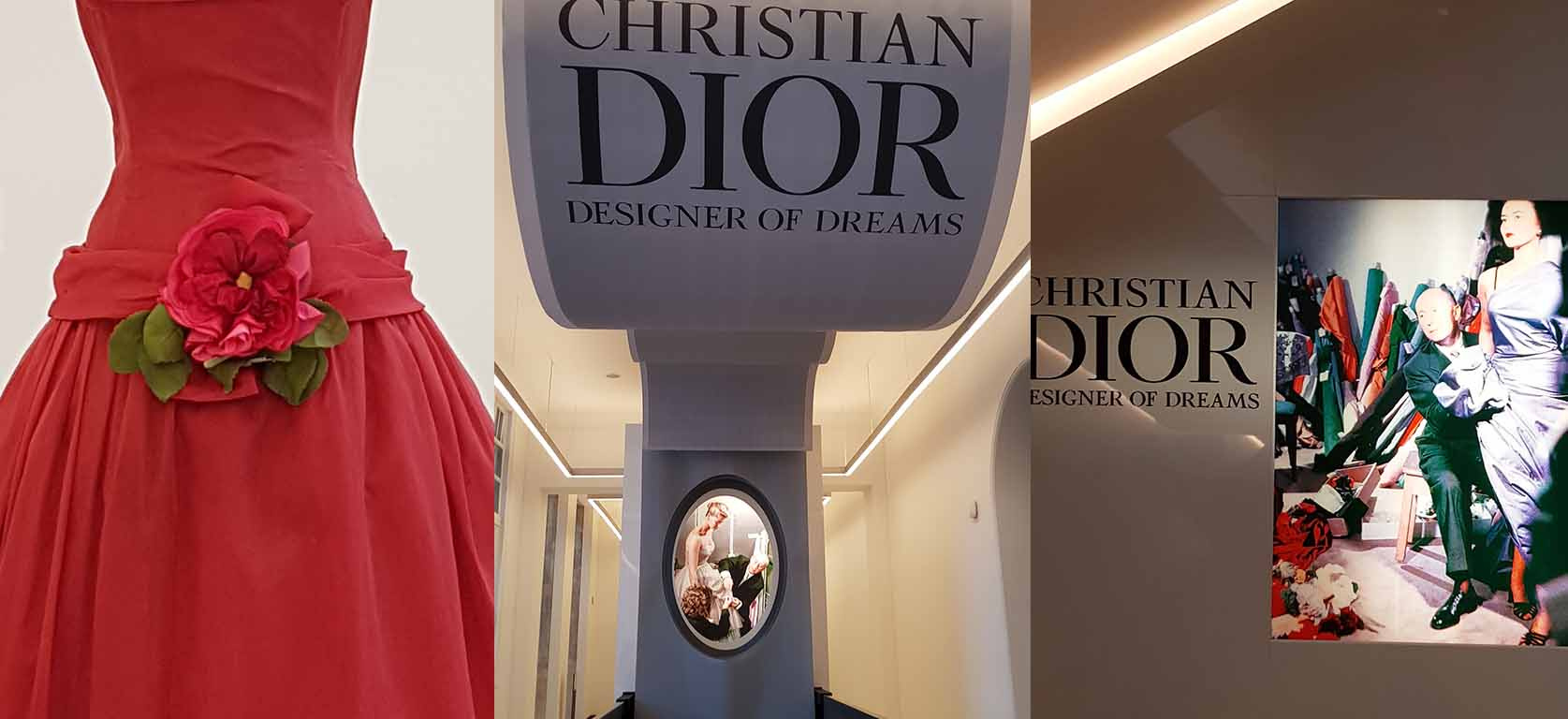
A tableau of images greet the visitor upon entering both the moving form and still photography. Many illustrate life behind the scenes in the atelier, Msr. Dior is seen draping silks around the figure, asking models how they feel in garment, talking to seamstresses and showing the work of the ‘petit mains’. Sketching and visualising the ideas is pretty crucial for a designer to feel the life growing in the new garment as it takes shape. For each designer the process is a little different but always a theme is the good communication and fluid dynamic between the designer and Atelier Studio team. It’s a partnership and the fortunes of the business, the hopes and dreams of clients always depend upon this.
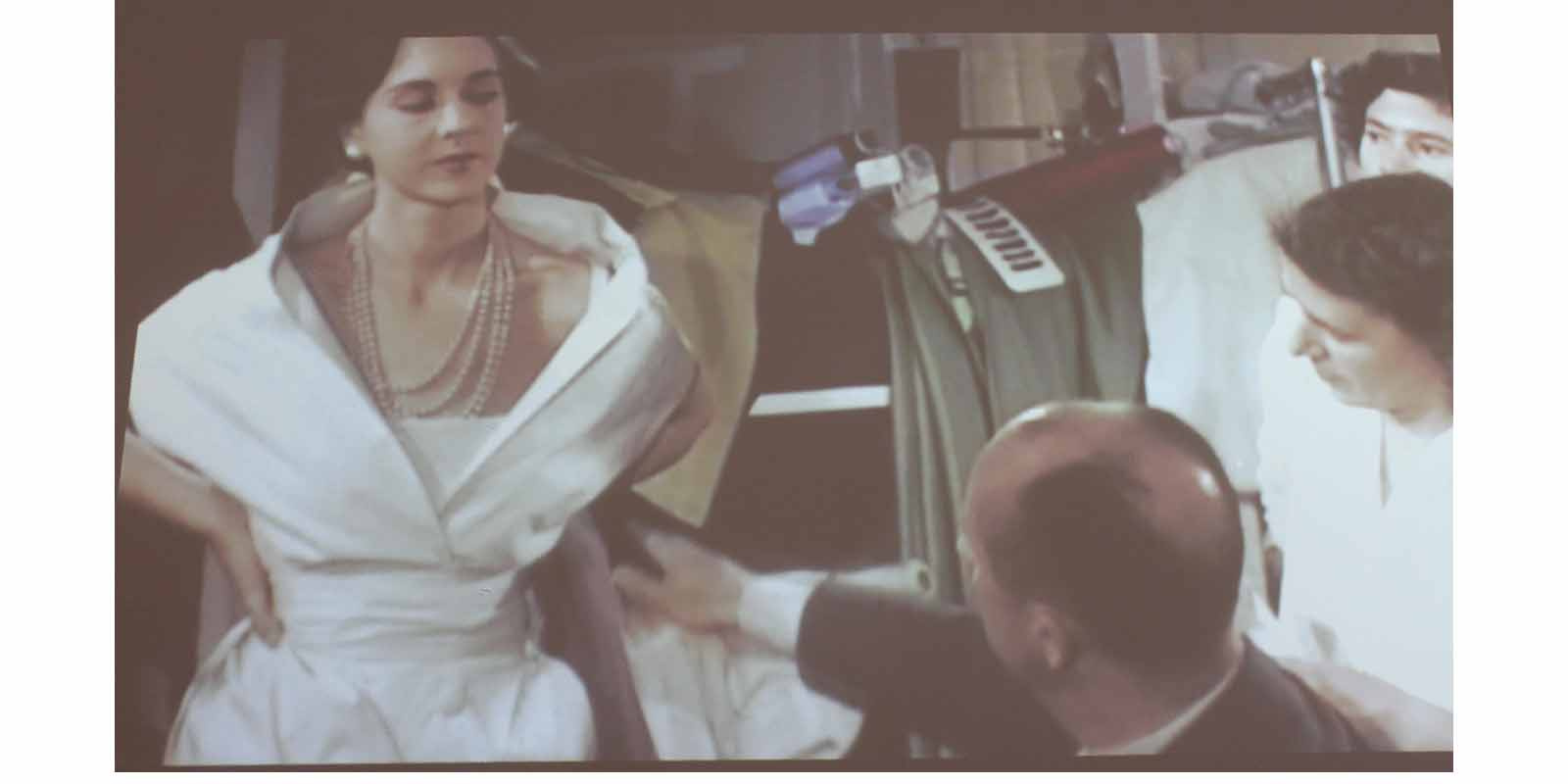
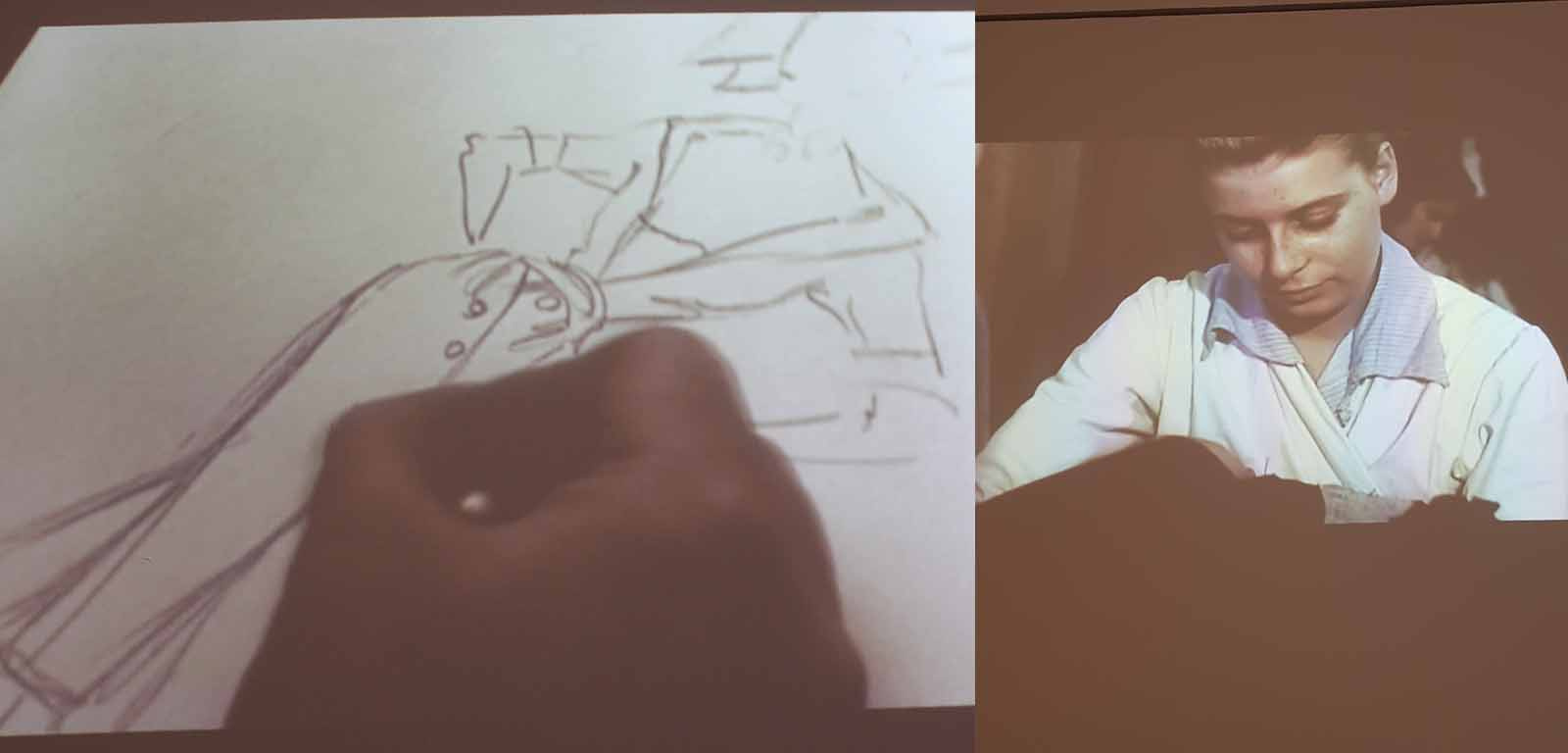
Christian Dior background as a student of architectural design comes to the fore in the sketches and designs that take shape. The tailored lines of the coat moulded round the figure but choosing lines of his own conformity rather than softly sitting on the figure, showed an eye for idealisation of style and with the nipped in waist, just on my opinion, an eye for control of the form and detail.
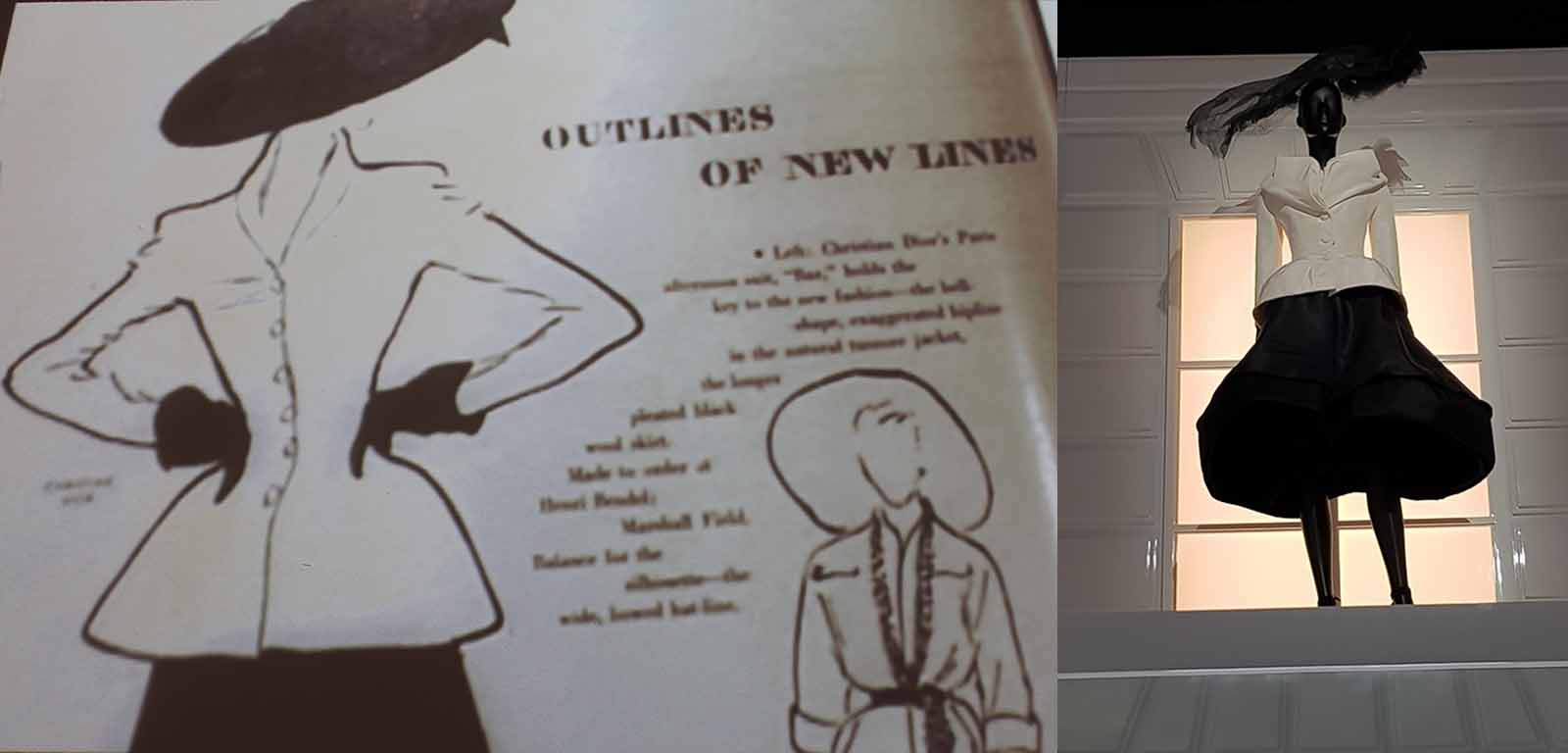
The first room of the exhibition opened into a central gallery that showcased the era of the Bar jacket, the suit that brought Maison Dior into being in the late 1940’s when rationing was still in place in Europe and the American continent and the first faint echoes of a desire for post-war glamour where being heard. Miss or Madam Dior steps out of the house and into the wider world Front and centre is the famous Bar suit itself, the women’s waist styled into almost Victorian proportions of slender waifness. However the Dior Woman’s suit allowed a freedom of expression never permitted to women of the 19th century. Christian Dior adored women, he’d watched his mother and her friends encased in corsets amongst the bourgeoisie of Normandy but he saw the future of women to be something different. The Bar suit has lived on in innumerable permutations through Dior collection since then and below to the left one of my favourite looks a John Galliano jacket, skirt and hat in the classic bar shapes brings the look into the Supermodel era.
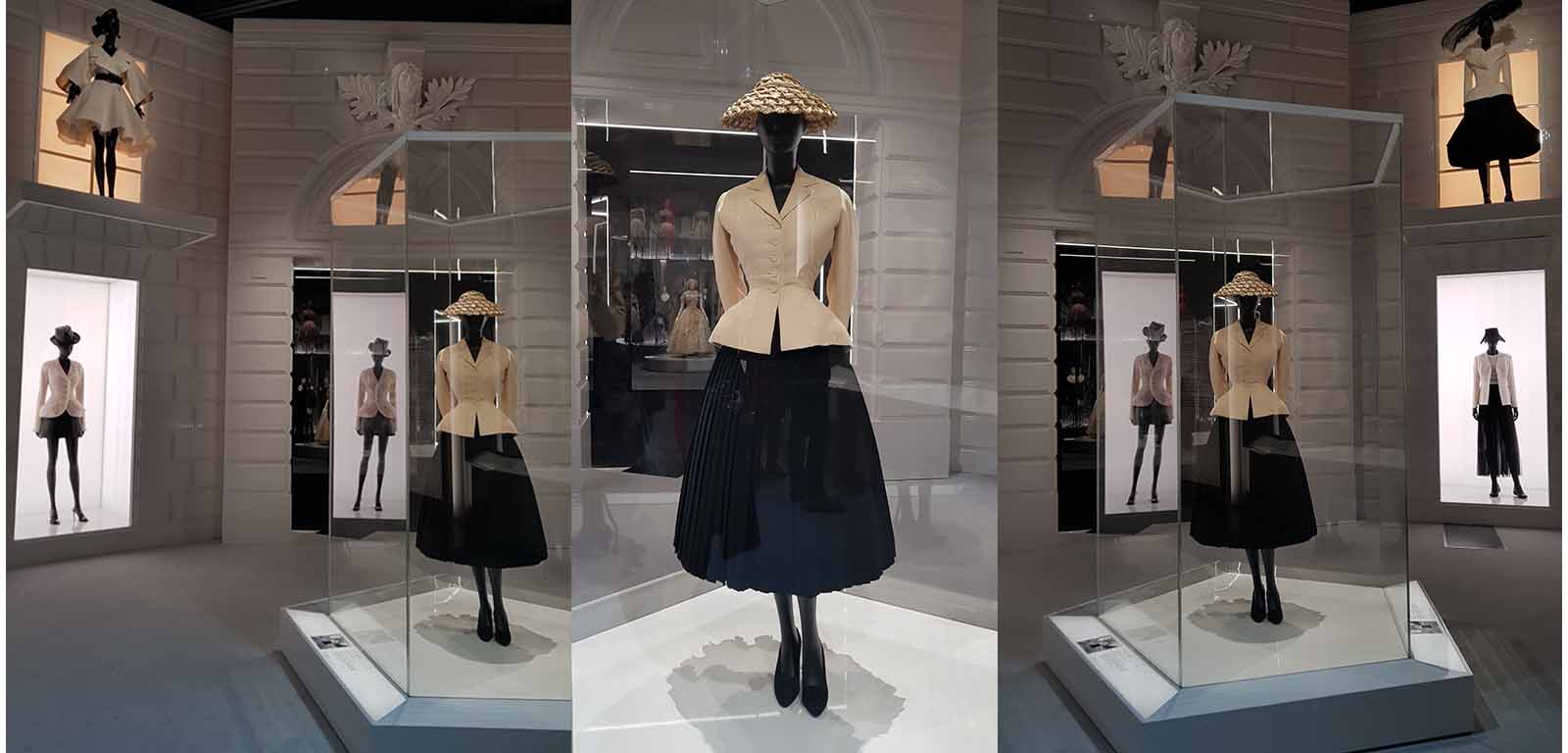
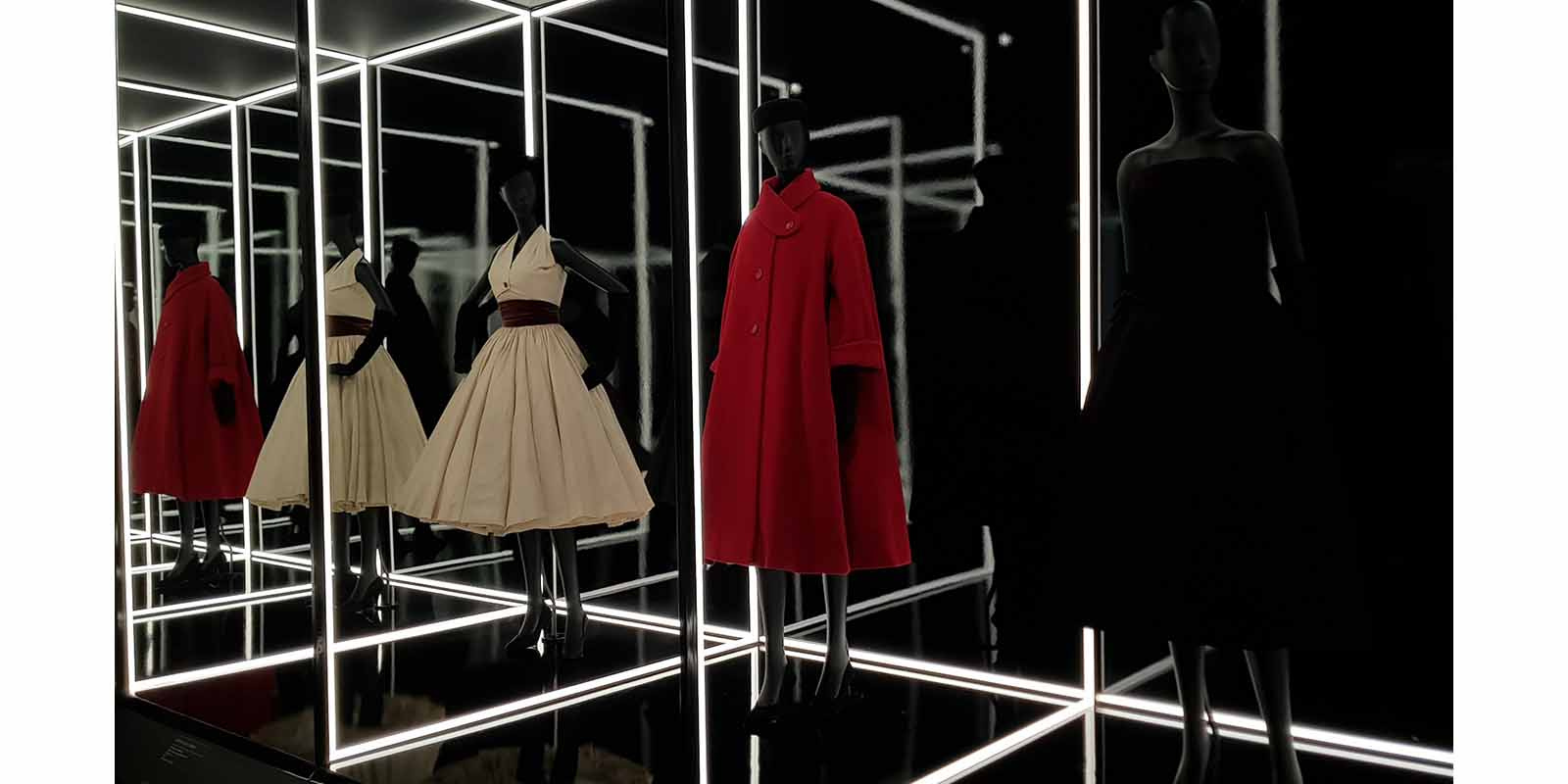
Mirrors, the heart of the dressing world are a handy presentation tool whether it’s bringing the outdoor light indoors, in a trick from the ancient world (it’s all about the angles you take) or creating palatial expanse as at Versailles in France and countless other homes across the UK and the European continent. Above three floral day wear pieces are backed and bordered by mirrors creating a stylish infinity. With his nose for architecture, I think that Monsieur Dior would certainly have approved of this. Some of the garment are a little hard to define against the Black setting but if you can see them in person, the detail comes to the fore. A Scarlet swing coat channels the epitome of 1950’s and early 60’s style that continued to dominate the codes of elegance for the rest of the century. Hanging loosely on the figure it resembles a look worn by Jackie Kennedy during her later stages of pregnancy and nods to modest style, keeping the unborn safely concealed rather than using as a focus of the gaze on the public eye. Comfort and elegance are the watch words and it’s an easy trans-generational piece. An elegant Cream-White Summer dress has the call of Dolce Vita and timeless summer elegance about it. With it’s shirt style collar, nipped in waist with broad sash descending to the waist and full skirt, it’s a very versatile glamour statement. Add a warp or jacket on cooler days and nights and you have a perfect multi-season staple that people would fight to get hold of for Summer vintage. Having said that, just about everything in the proceeding rooms would be too.
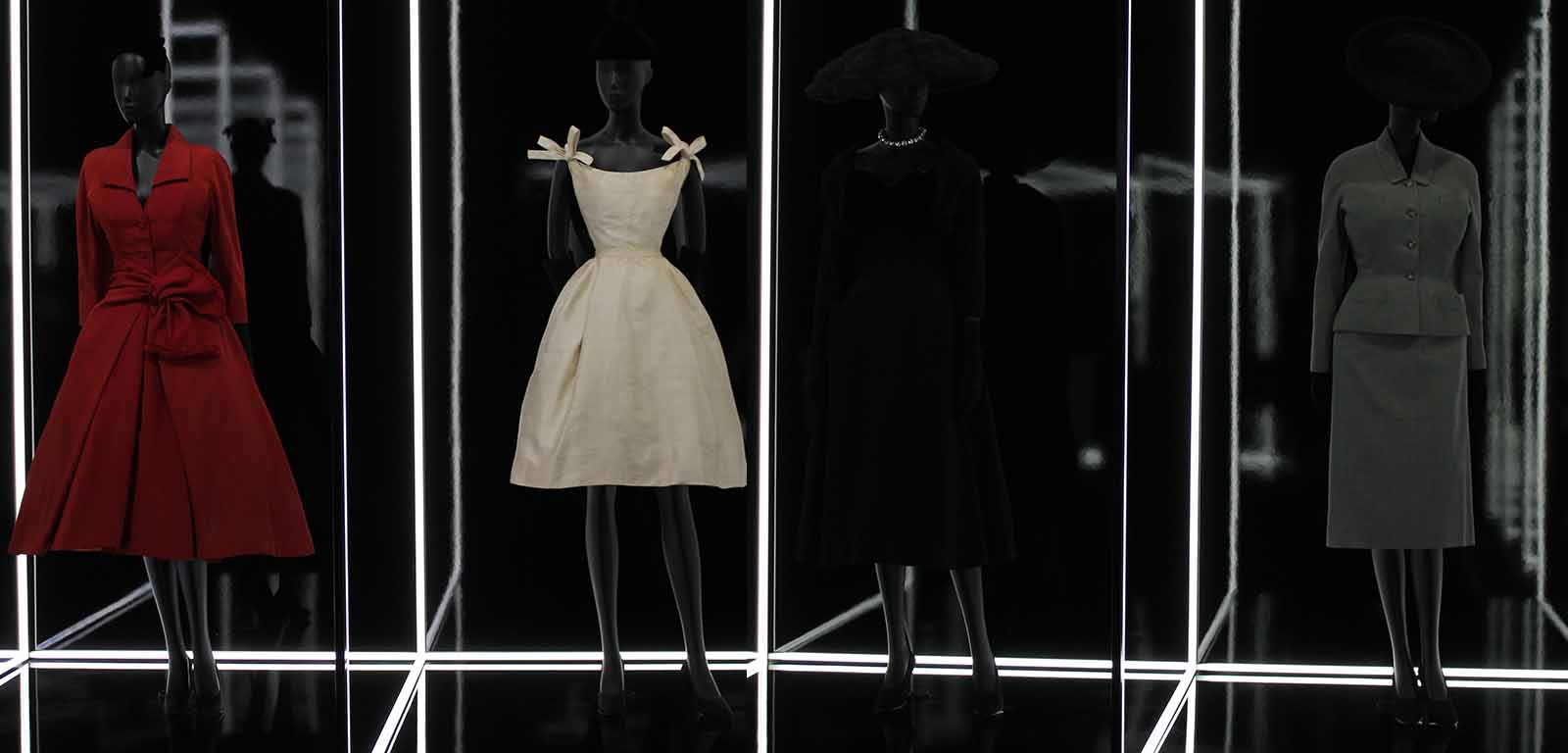
An Haute Couture dress coat creates a flourish across the waist hanging across the left hand hip makes a graceful nod to the mid twentieth century minimalist sense of romance. A jacket of sewn close to the figure bringing good posture if you didn’t already have it and the fit and flare architype of the mid twentieth century style line creates the silhouette that so many clients would find flattering on them. Skirt folds in geometric alignment fall at the front of the figure showing how Dior never lost sight, very literally of his roots in architectural design. A White Cocktail dress is cut into a triangular bodice reaching to a tiny waist. A tulip skirt circles the figure to the knees and is accented with pretty loops at the shoulders could easily be worn to an event now. Perfect for Summer drinks parties, it could also find a pace in the winter wardrobe with a Black jacket or cloak. A Black midi-length dress with broad brimmed hat channels classic mid 20th century ‘Diorifique’ glamour. Be you 21 or 87, this look could still hit the spot for adding to your wardrobe for formal occasions across seasons. A Grey skirt suit typifies the simplified styles that dominated, taste driven by necessity after the Second World War. Simple and defined a woman could go out to private appointments or a role of employment in it and be confidently styled.
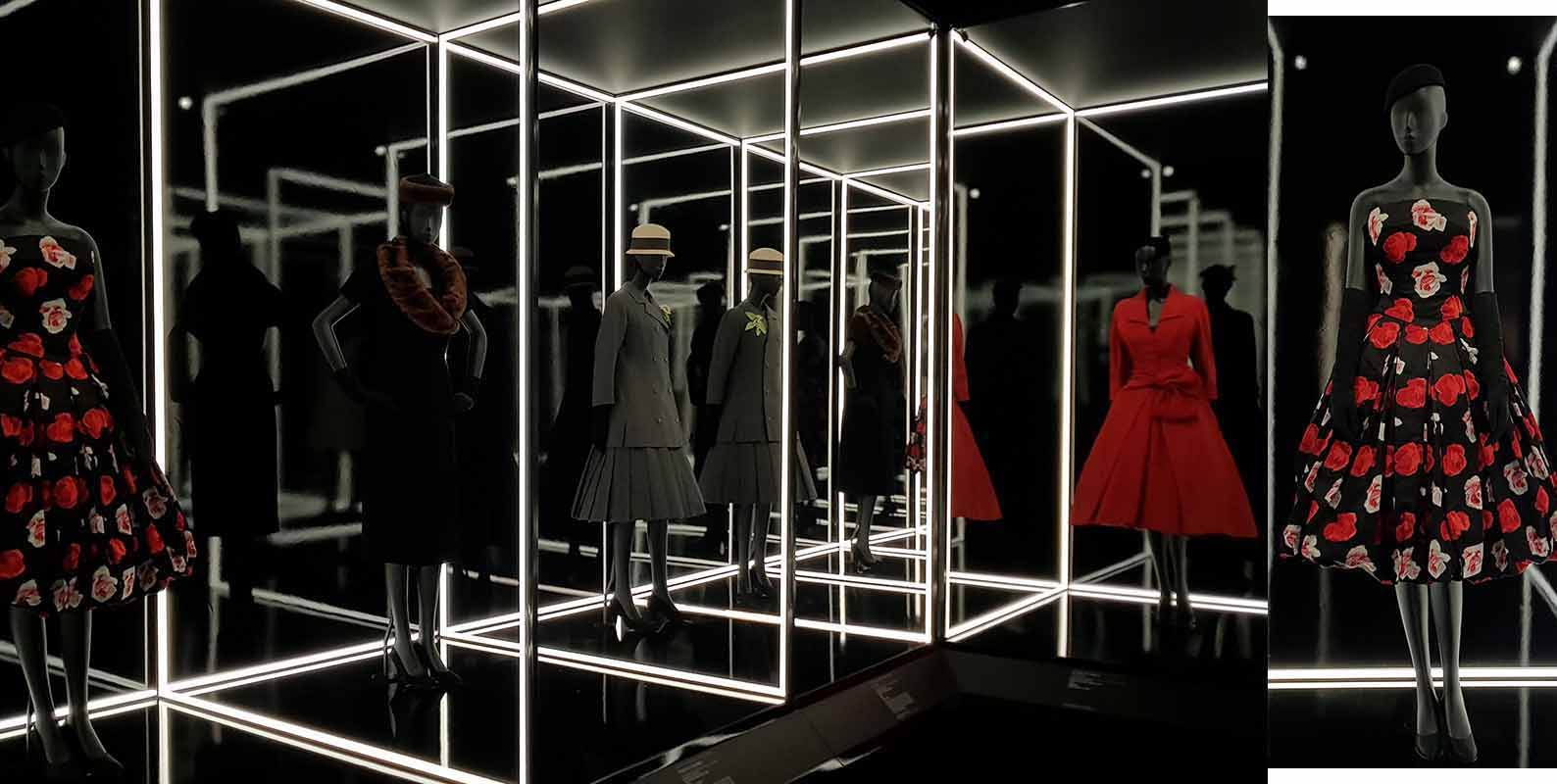
A dress composed of Rose print fabric is gathered into the full knee length double layer skirt part way between puffball and tulip (a style that Galliano later emulated). Again many women visiting the exhibition will have this in mind as a piece that they can wear and would happily be guardian of in their wardrobes. Worn with or without a jacket it’s a key look. A little antiquated perhaps is the use of fur to line the collar of a Black skirt suit featured along the line of dresses. A matching hat on top is also something that you would not see now but suited the less sensitive and synthetically accommodated fabric technologies of the early years of the House of Dior. A Grey Suit with a pleated skirt has the look of a grown-up uniform style so favoured for it’s simplicity by previous generations of women. Hints of the male military uniform showing the adoption of conformity in the woman’s wardrobe as the 20th century progressed.
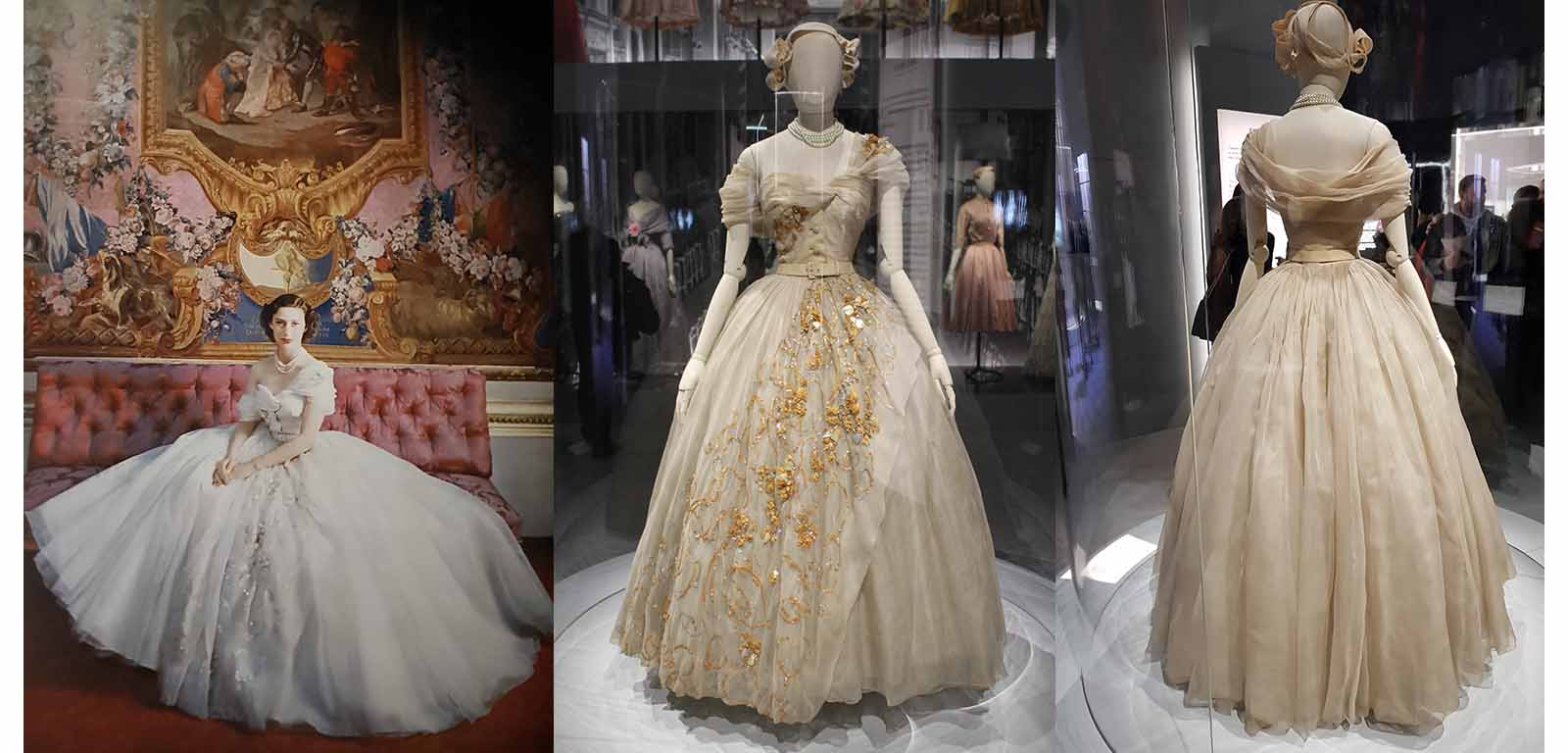
One of Dior’s most well-known clients to date was the late Princess Margaret. The Queens sister attended both hall mark shows held by Christian Dior at Blenheim Palace and this presentation case features the 21st Birthday dress that she commissioned from Dior. Its picture perfect and no doubt she had some input into the design to meet her expectations. Whilst you may reflect on the impression of what life must be like for a princess, what is really significant here on the larger scale is the place that this relationship with the House of Dior would have had in strengthening and maintaining relationships between the UK and France. It also served as a powerful image making gift to Dior from the British Royal family and cementing its eminent style legacy. It looks doll-like in the glass case. Golden flowers run across the surface of the dress to emphasis the iridescence of youth and the sparkling allure fabled of Royalty. With her beauty spanning the range of Hollywood glamour meets traditional British aristocratic vibe, Princess Margaret had beauty, intelligence and a respected global presence. A casually dropped shoulder at the left of the dress hints at carefree times away from duty and responsibility working with hundreds of charitable groups and representing the Queen at home and abroad.
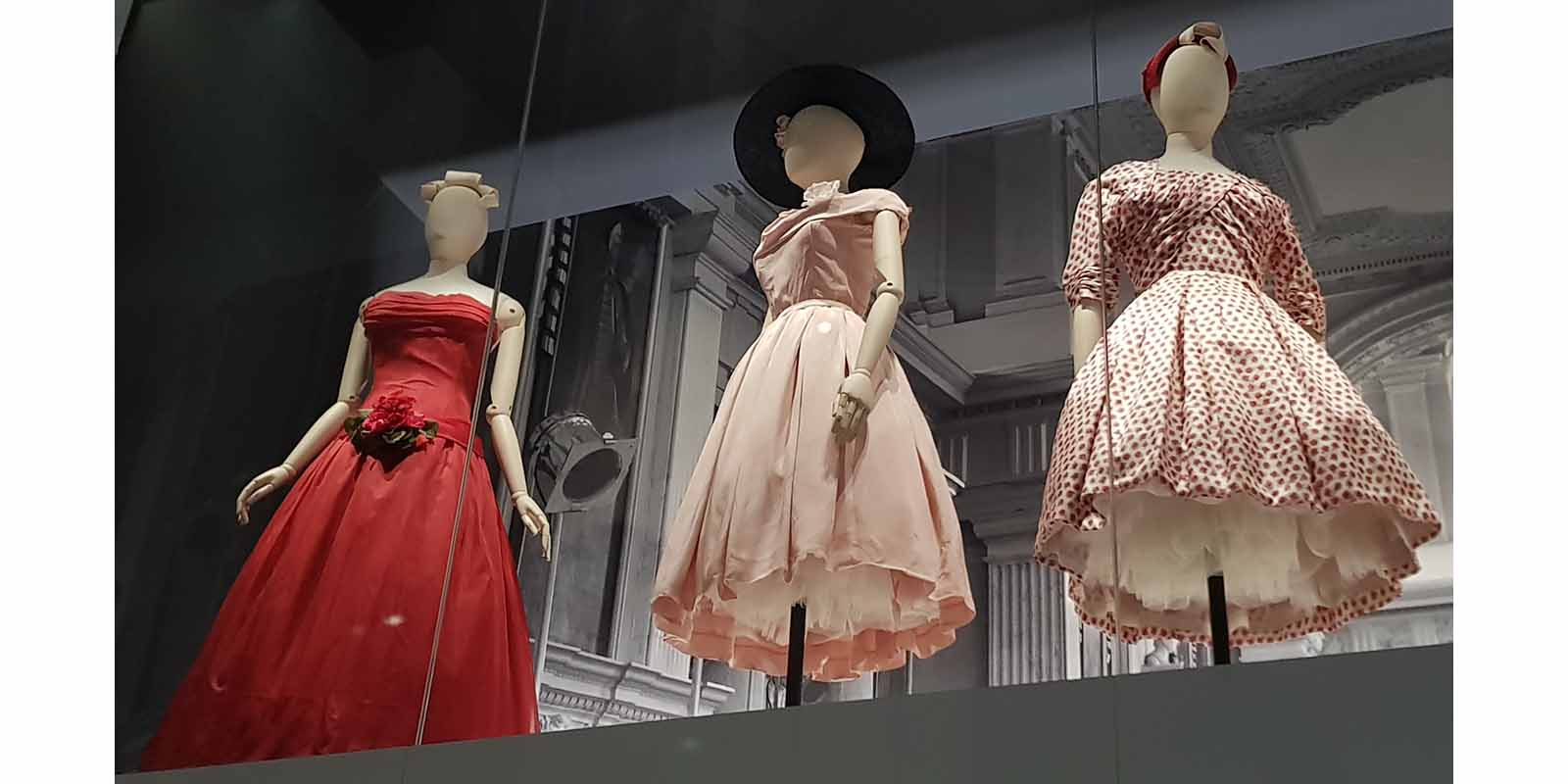
Above the celebrated dress worn by the Princess a high gallery shows garments with the classic 1950’s and 1960’s styling and shape that capture the pretty romance that Dior wanted to being to clients around the world. Above to the left a Rose-Red dress seen above at the preview day is cinched at the waist with a Rose flower and foliage emphasising strength and new life and imitating old paintings that used the flower motif to express the fertility of women, often Queens. A sugar Pink tea dress is a vintage find of a lifetime. You could wear it to the races or many Summer formals this year giving a vintage vibe to the look and a gentle volume that creates and elegant silhouette that floats between day and evening wear to the modern eye. To the far right a print fabric Tea dress is ready for the dance or summer adventures with fabric wrapped across the dress at the bodice neckline.
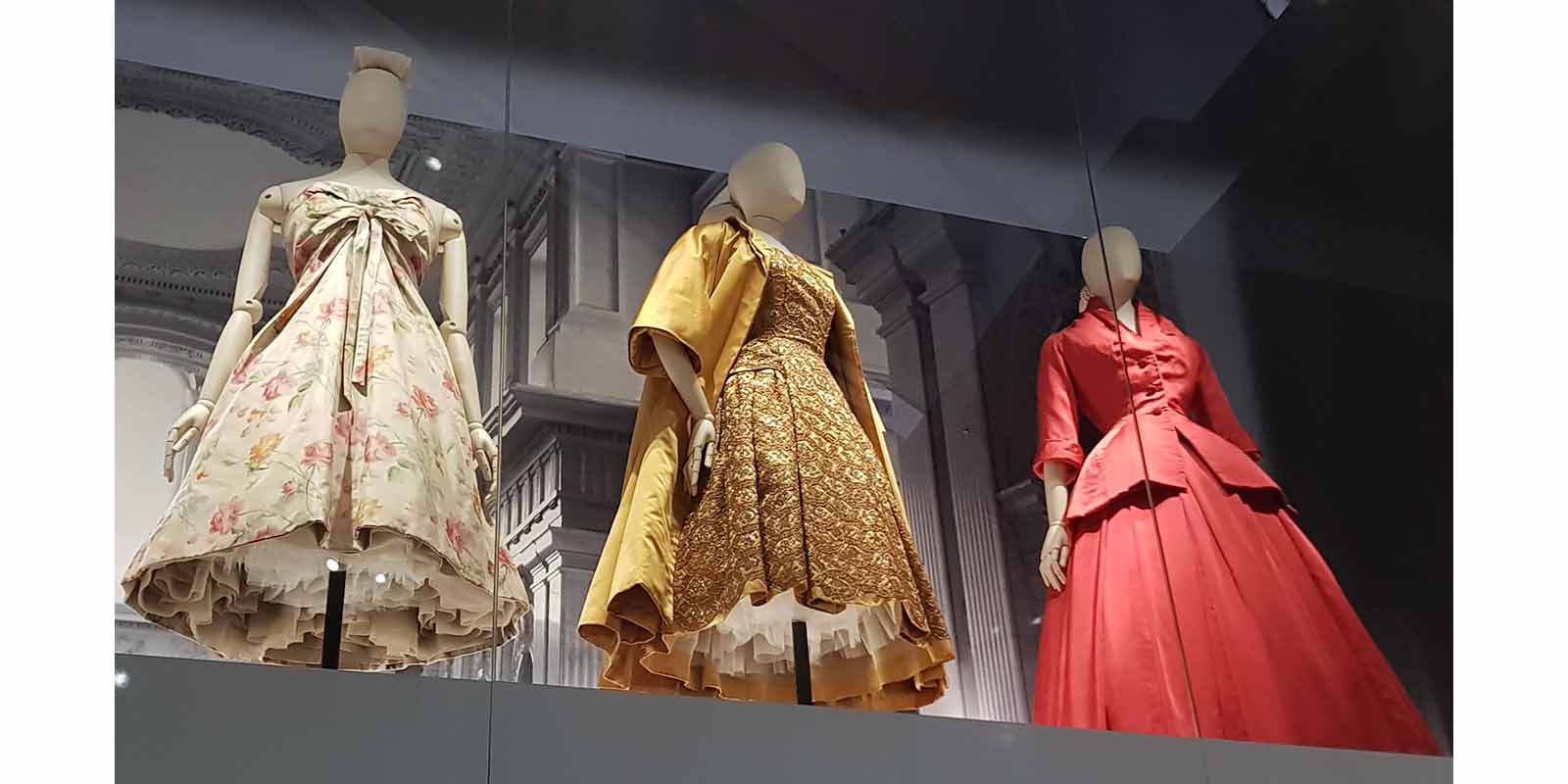
Floral prints with botanical detail cross the fabric of a dress below bringing the garden to life on the wearer as she walks tied with a bow ribbon a the bodice quietly set with angled precision. Centre, the lustre of Gold is captured with a hint of metal work in a dress and summer coat that sit lightly on the figure. Faint patterns resembling the hexagons of the Bee hive and chains of eternal metallic Gold symbolise enduring female strength. The name Dior itself originates in the phrase “D’or” in French with means Golden or originates perhaps in commerce. A Scarlet Rose dress and jacket cut to ‘Bar’ lines completes the upper range providing an enduring classic style for parties and Red Carpets from one season to the next.
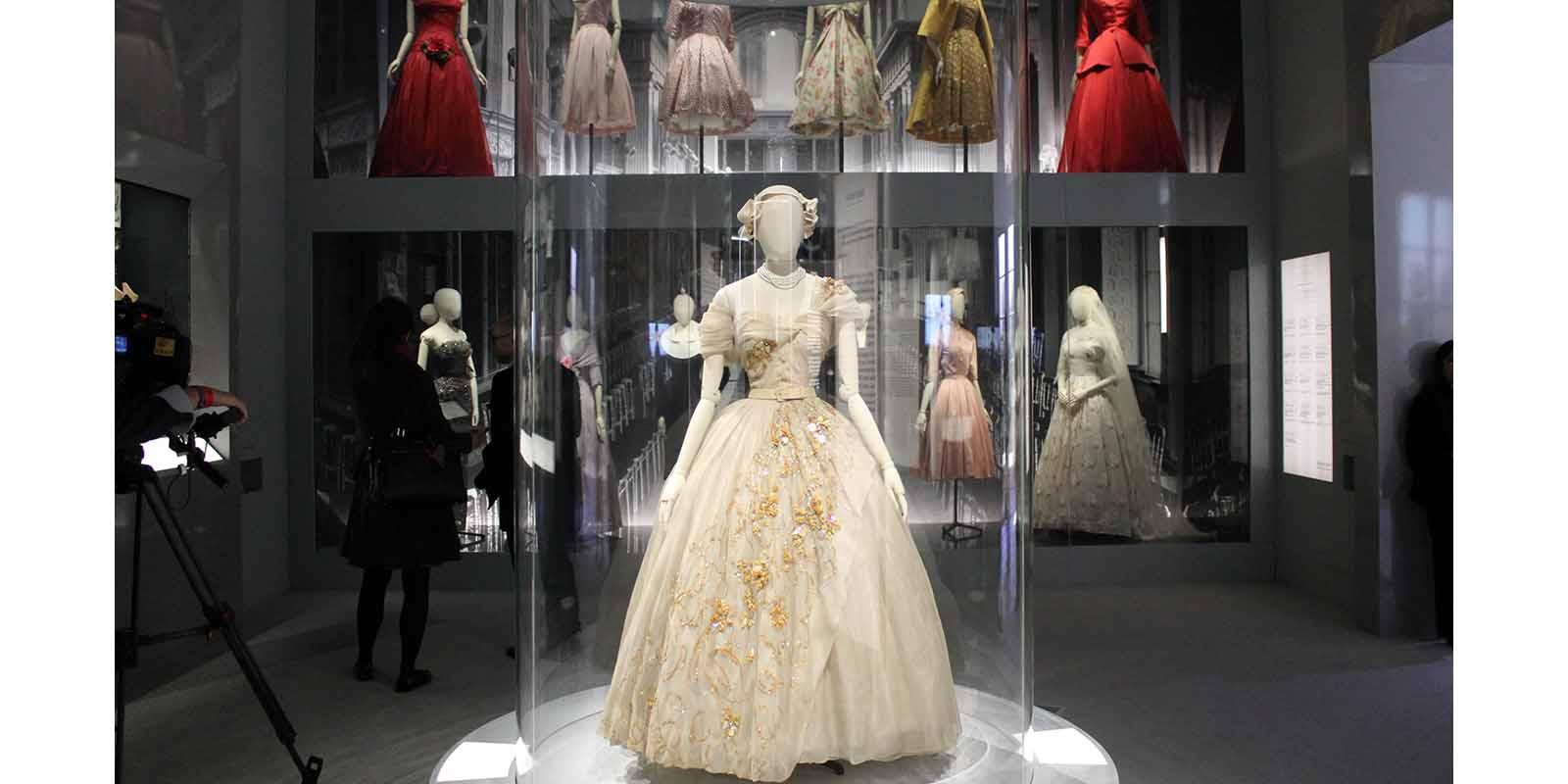
In a ground floor gallery a Blush satin dress is a perfect day wear look that could take you out to a lunch or reception in style. The free flowing fabric is draped to perfection across the figure and the piece appears to move like liquid as the wearer walks. A bridal design stands to the side with fabric embroidered with flowers showing that across the last two centuries when the White dress has dominated, many brides have enjoyed wearing dresses with a print or coloured embroidered design. A Silver sparkling dress carries hints of the late Belle Epoch era in the heavy embellishment of its fabric and the train created behind the wearer by gathering fabric. To the right a full length dress in the House Grey of Dior is centred by a Rose above the waist and below the V neckline of the dress. It’s an easy ball ensemble and will suit clients across the age spectrum.
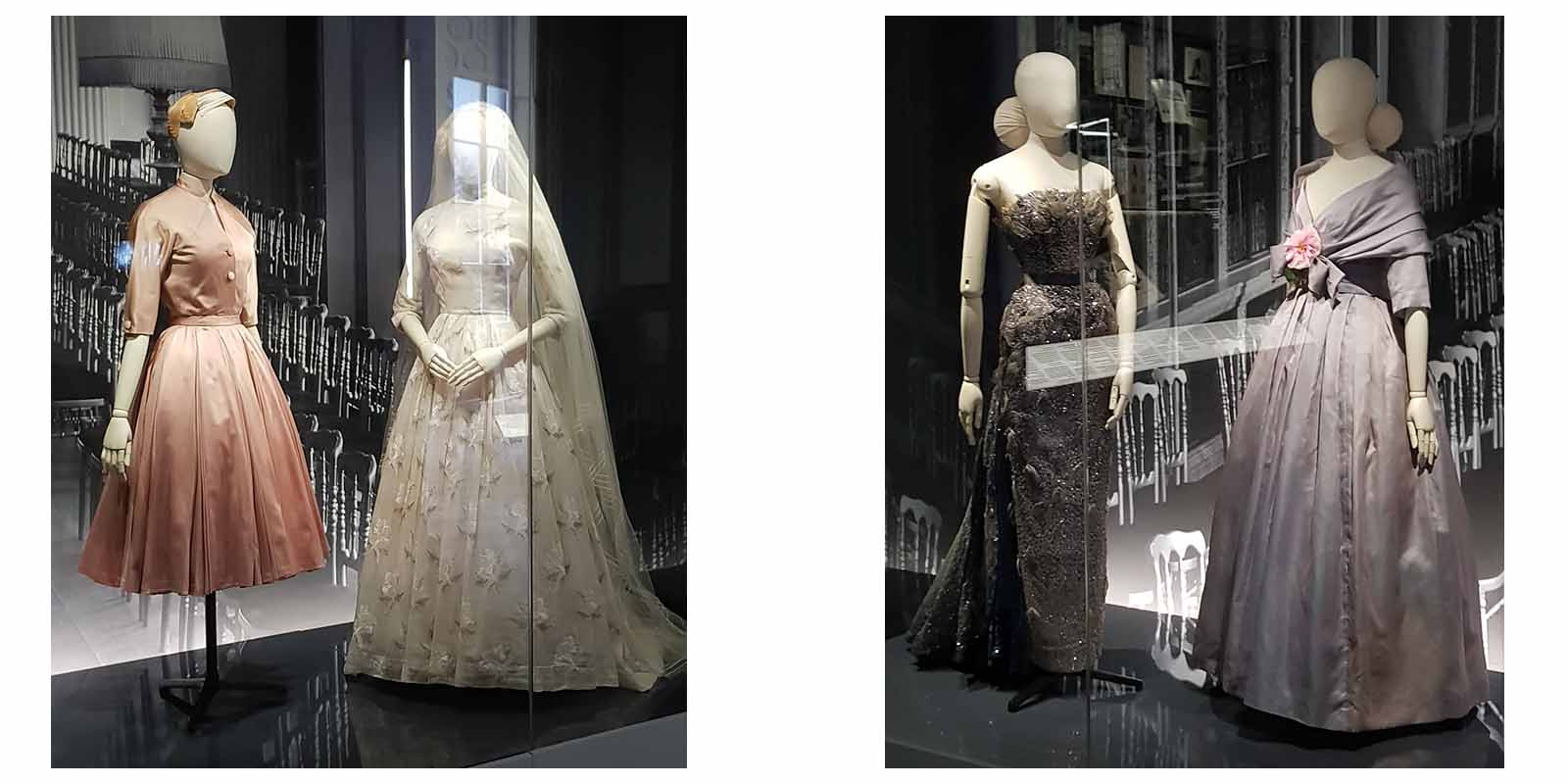
A tableau of illustrations from magazines, design books and artefacts from the atelier illustrate the multi-faceted life and output of a flourishing atelier.
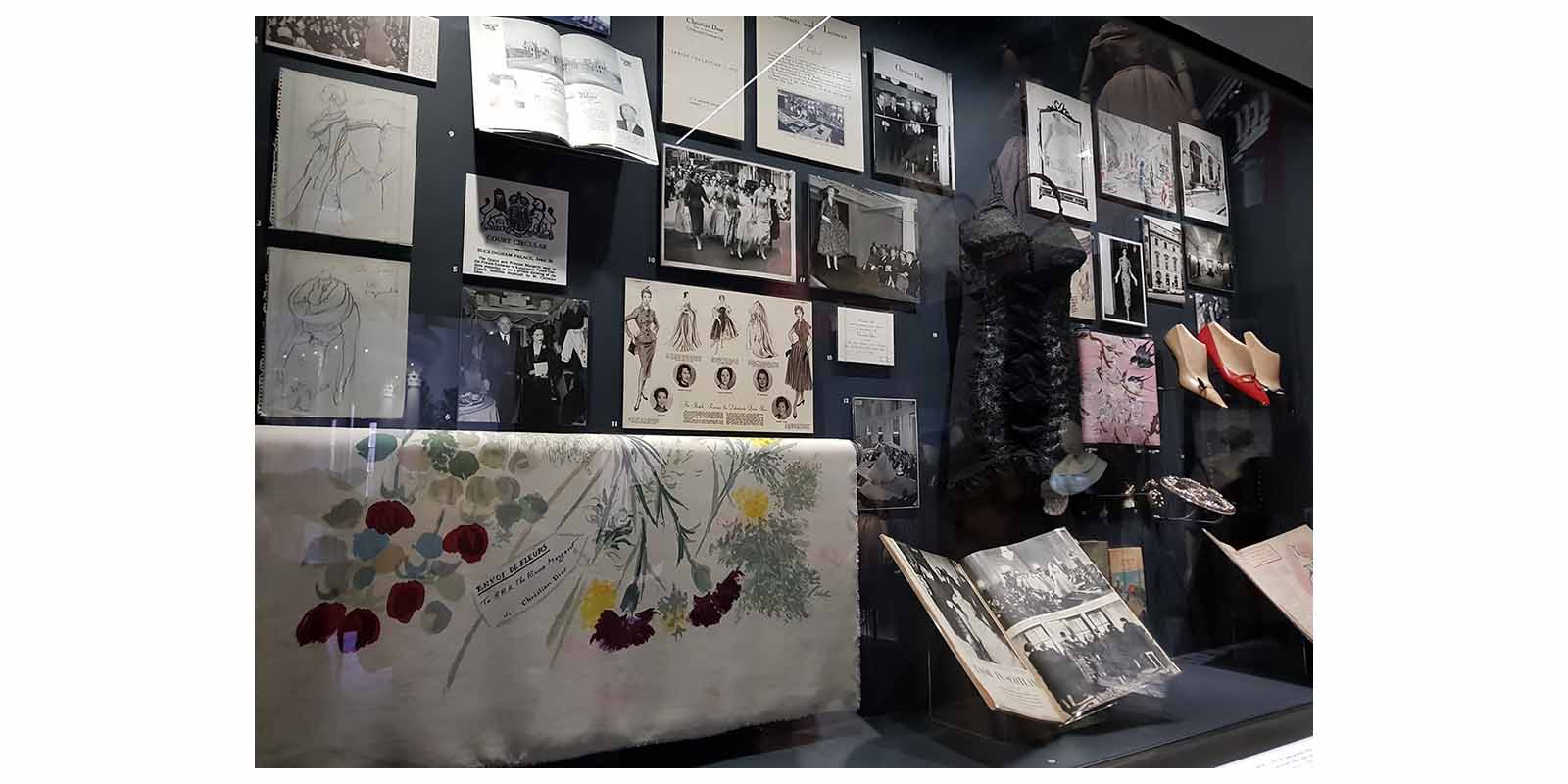
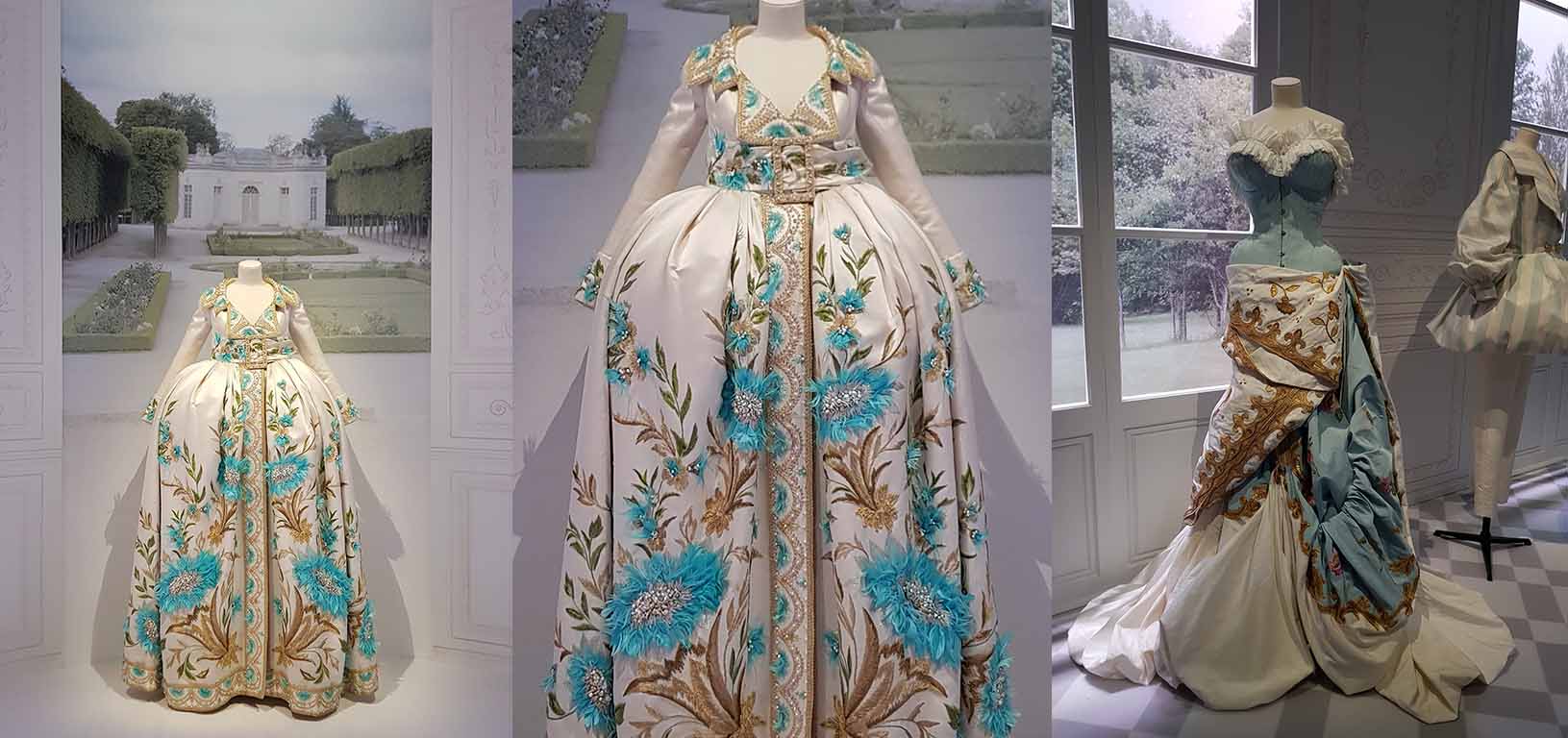
As you would expect from an Haute Couture House in France, the heritage of high French fashion and that that revolved around of old world of the Royal and Aristocratic courts of the 18th and 19th century provided a While Christian Dior undoubtedly relished the intricacies of French design history, it was his later successor Galliano who pushed it up into 7th gear and brought corsets into the daylight and played with the hemlines and lengths of yore to great degree. Above the 18th century mantua of Princesses and Ladies is imagined in its spiritual home of ornate gardens in another nod to the geometry that captures the landscape of Paris. A bold Aquamarine Blue dazzles in fluttering feathers across the surface of the dress. Elaborate embroidery of stems and leaves shine with their own iridescence in Golden, Oatmeal and Green tones. Embroidered bead-work running across the surface sewn in precise borders. A wide buckled belt at the waist references the utilitarian aspects of style that crept into design in that bygone era although we remember it as saccharine Froufrou. To the right above a corseted dress from the Galliano era of Dior is part of one of the most memorable collections that he ever brought out. Ready for a supermodel to wear striding forth like a conquering Britannia or Marianne, it’s Duck Egg Blue corset gives way to a skirt composed of draped folds of fabric. Formed in a seemingly careless abandoned style as if a model picked it up and wrapped it around herself the Fleur de Lis embroidered symbol nods to the heritage of the French crown while Golden flowers.
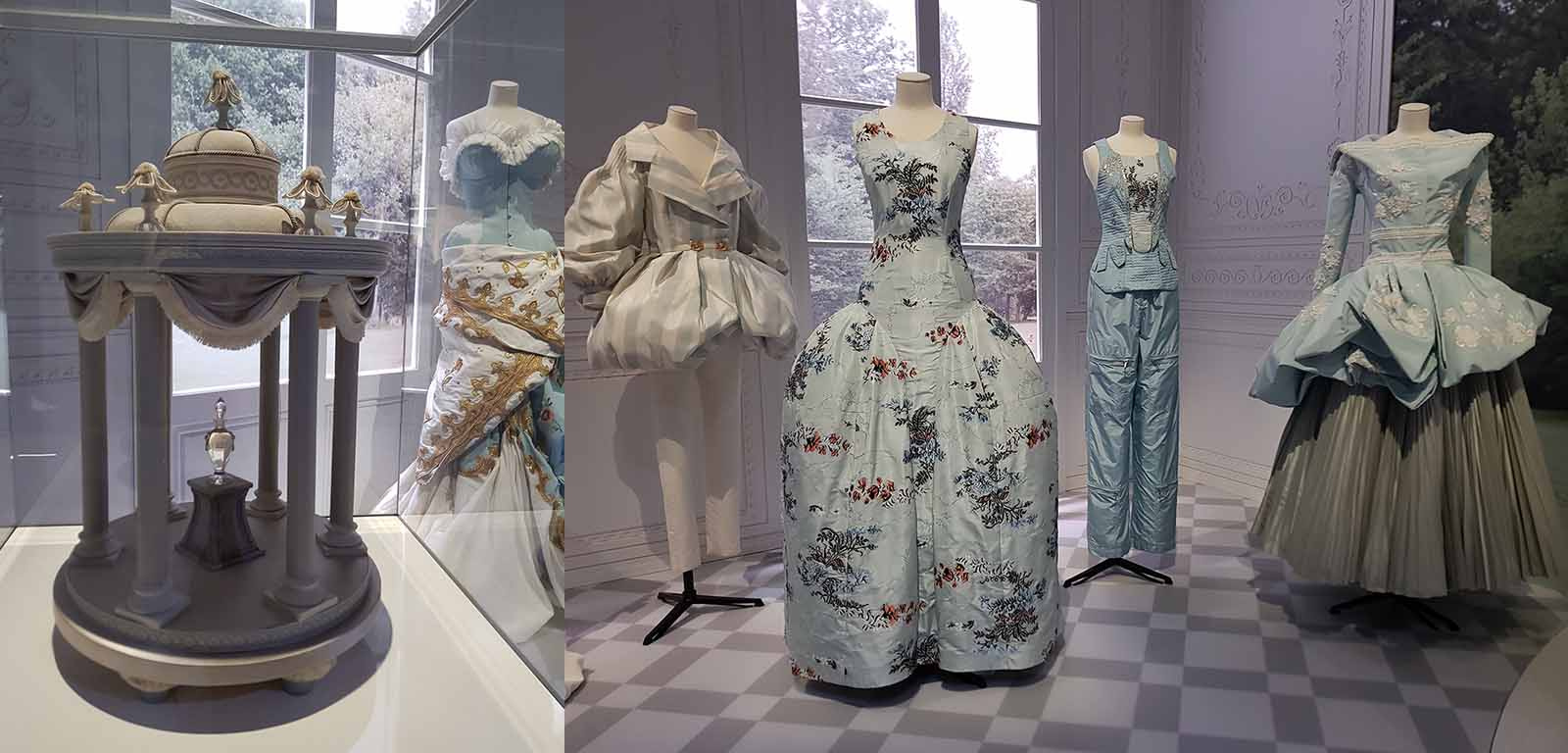
A phial of Christian Dior perfume sits enthroned in it’s own house, a garden temple to the purest of parfum. Playing with heritage can take you in unexpected directions with the sailor inspired jackets of 19th century informal wear are dreamed up into a voluminous blouse-jacket in Dior Grey and White stripes tied at the waist with a brown buckle belt. Straight line trousers again hint at sailor style and perhaps a reminiscence of Dior childhood on the Normandy coast at Granville. Pristine embroidered fabric of an 18th century Mantua dress combines modern cut with fabric production possibilities. Straight legged trouser fastened with zips at the knee bring a hint of sport to the collection, which for me cuts against the grain of beauty that the house was born from somewhat. To the right, the 1950’s ballerina style tulle fine pleated skirt in oyster sits under a voluminous blouse jacket. Created in light Blue silk in a style reminiscent of look of English Blue Clay China flowers are embroidered onto the surface of the garment in a subtle contrast.
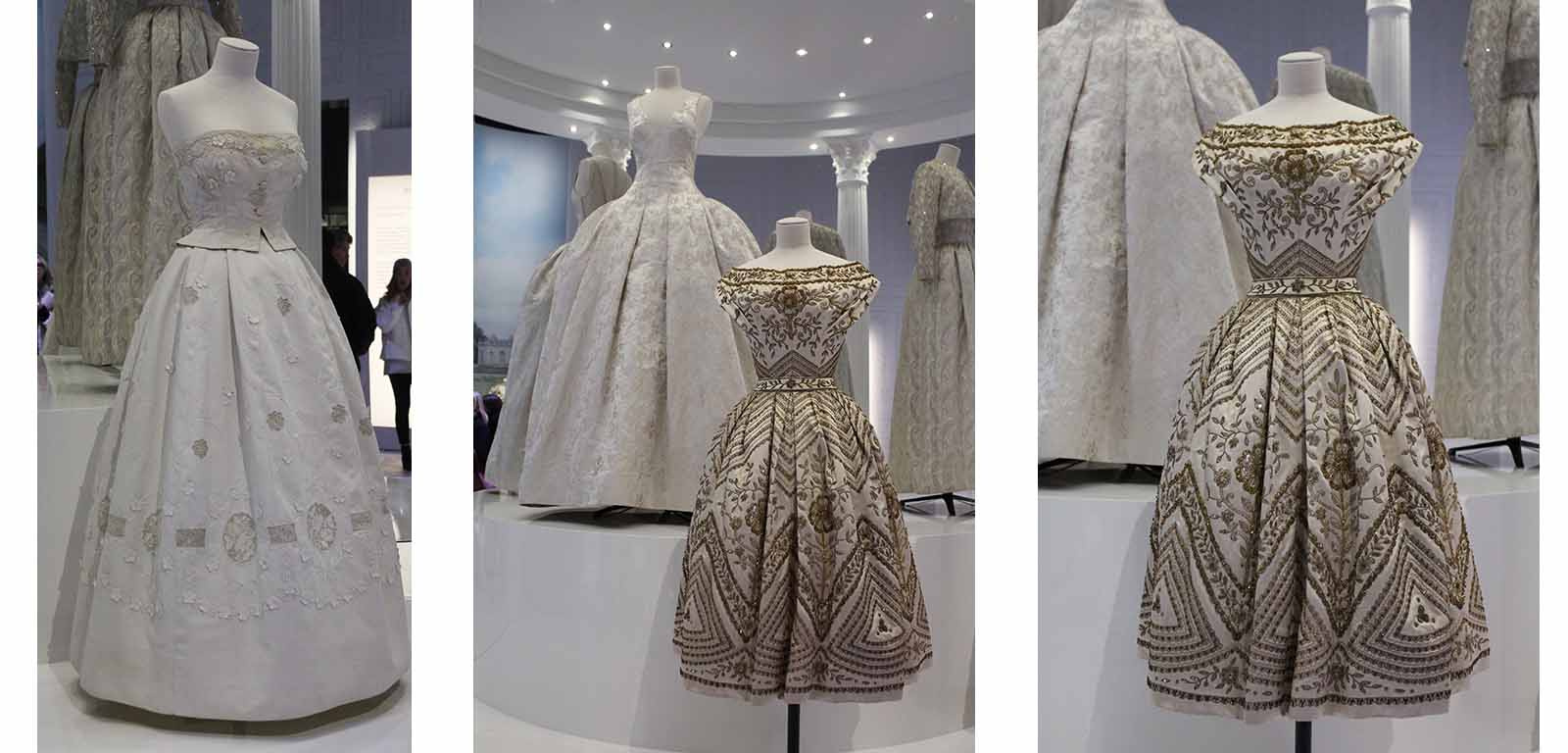
The elaboration of White linen simplicity produces a stella two piece dress composed of bodice and skirt that opens up into a beautiful full length composition. It has the potential to be both a bridal outfit as well as worn as evening-wear. The glint of Golden thread worked through the cocktail dress above is sewn into tessellated geometry showing the strength of women. This is illustrated in a dual opposed symbolism through both the natural unique patterns of the flower as it grows and the fixed lines of the human-made geometry. The rose sits perfectly centre of the upper bodice close to the heart and illustrates the perfection of the female form that Dior sought to promote his belief in.
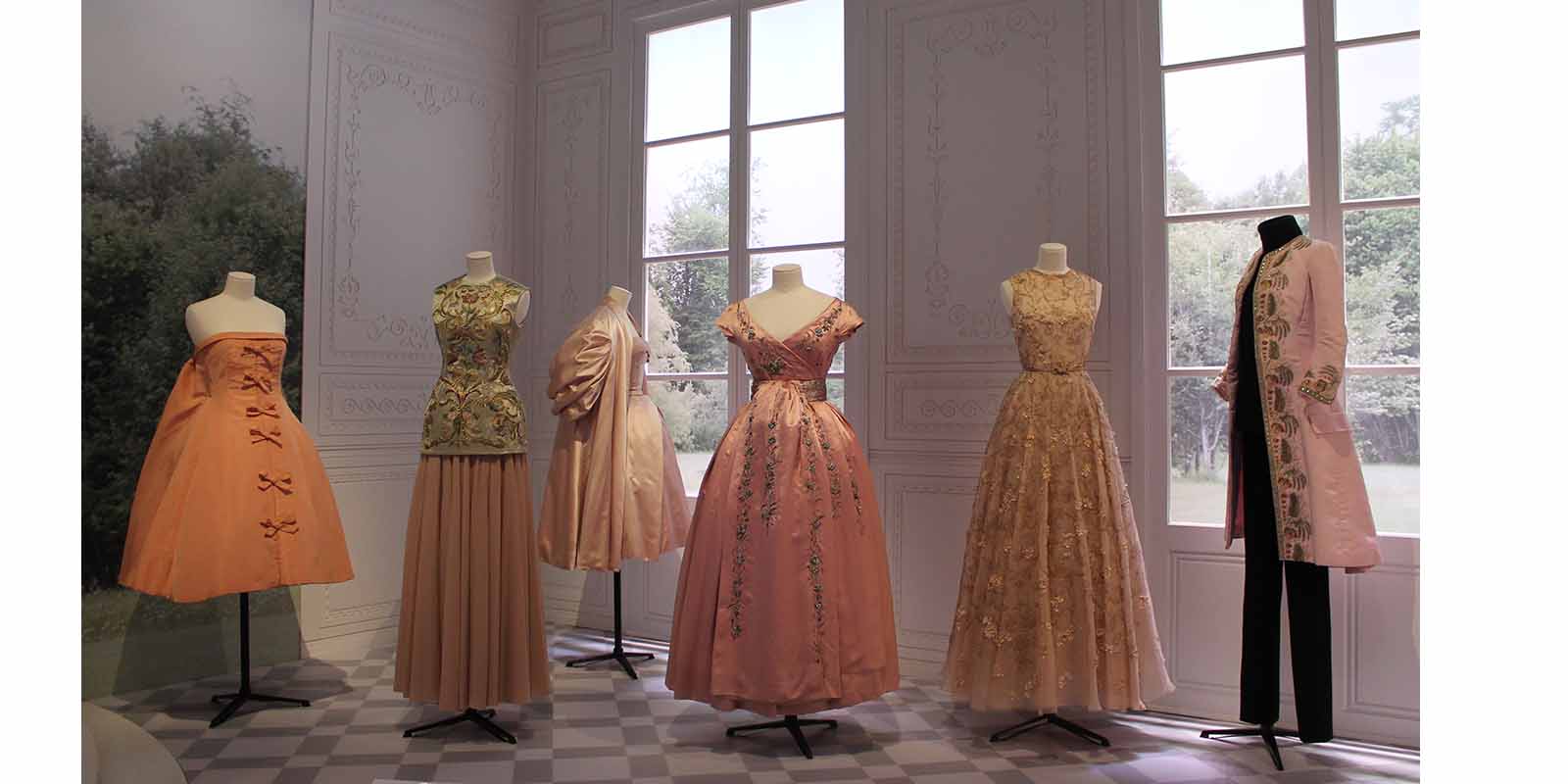
A room of cocktail dresses and a courtly trouser suit welcome the visitor into a room that feels like a party scene where time has been paused. A peach cocktail dress is lined down through the centre with a series of bows creates a sugar-sweet look. A train taking its cue from the lines of the 18th century dress cuts to the heart of the essence of the modern aesthetic of chic as defined through the lens of the House of Dior. To its right, a look of contrasts is composed of a Golden cloth blouse with detailed embroidery and a Peach toned voluminous skirt. It’s an opposition of texture, cut and colour working crafted into one piece. It’s you’re looking for a bold sleeveless garment this could be a perfect choice for a client. A Sugar Pink cocktail gown and coat form a classic composition that could be requested by clients either 50 years in the past or 50 years from now. Perfectly folded ruched billowing sleeves lend a vintage touch to the piece. A Baby Pink silk dress with a waterfall of flowers descending through its length references the lines of ancient Chinese and Japanese garments in both the fabric and the front fold over the waist reaching to the hemline. It represents the feel of ease of Haute Couture that Dior are adept at creating for clients, dream dresses that you can pass on to your granddaughters. Cornflower Blue detail set on the Baby Pink backdrop feels like a universal colour harmony. A Blush tulle dress channelling the ever popular elongated ballerina form. Applique flowers growing across the bodice and down the skirt as if on a trellis bring the living spirit of life and nature to the dress growing and weaving around the figure of the wearer. Making a play on the 18th century frock coat and suit, a black sweater and trouser combination through a Baby Pink jacket featuring detailed applique into high relief. The jewel-work across the garment is exceptional and a piece to treasure as client, journalist or fashion historian. It takes the best of the past and continues its journey.
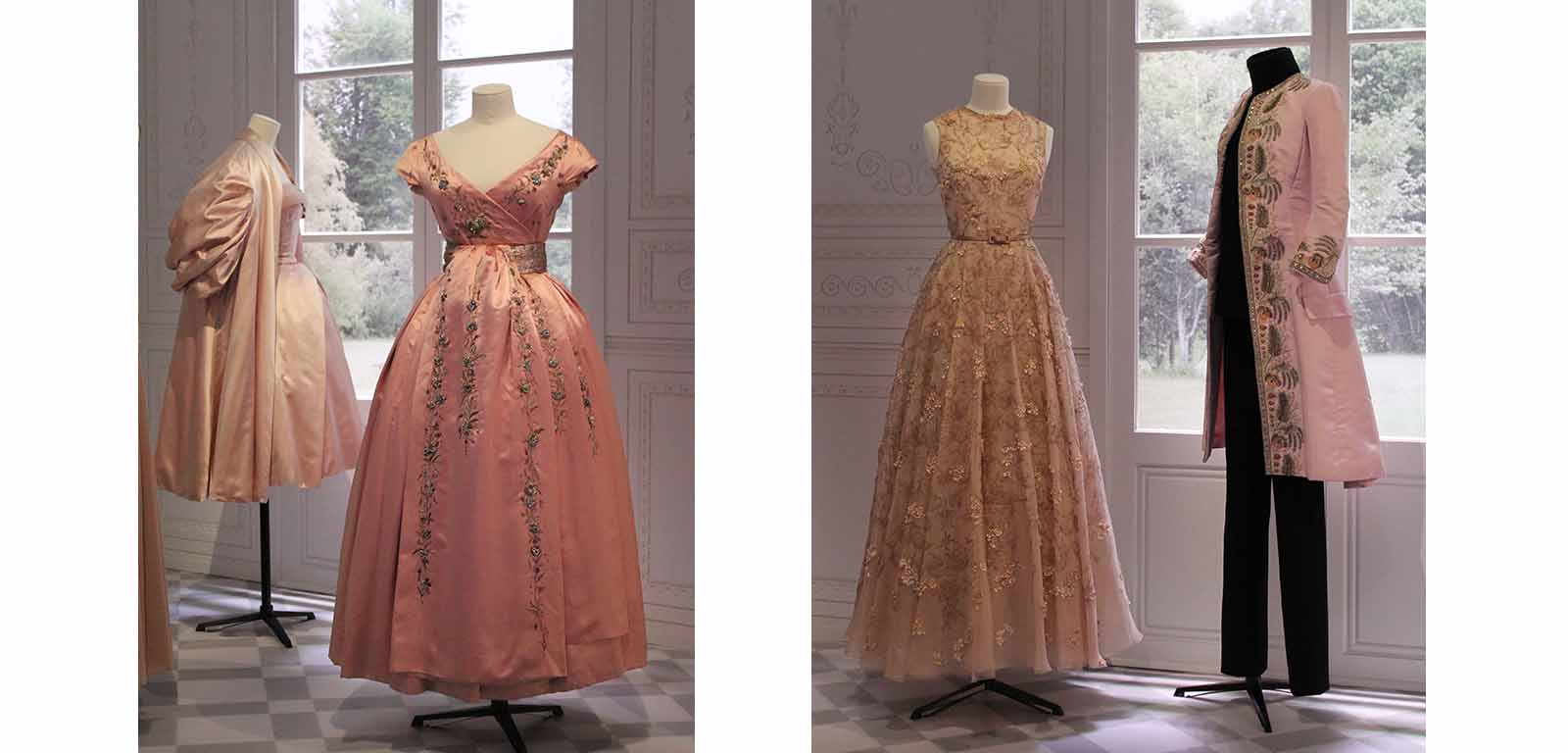
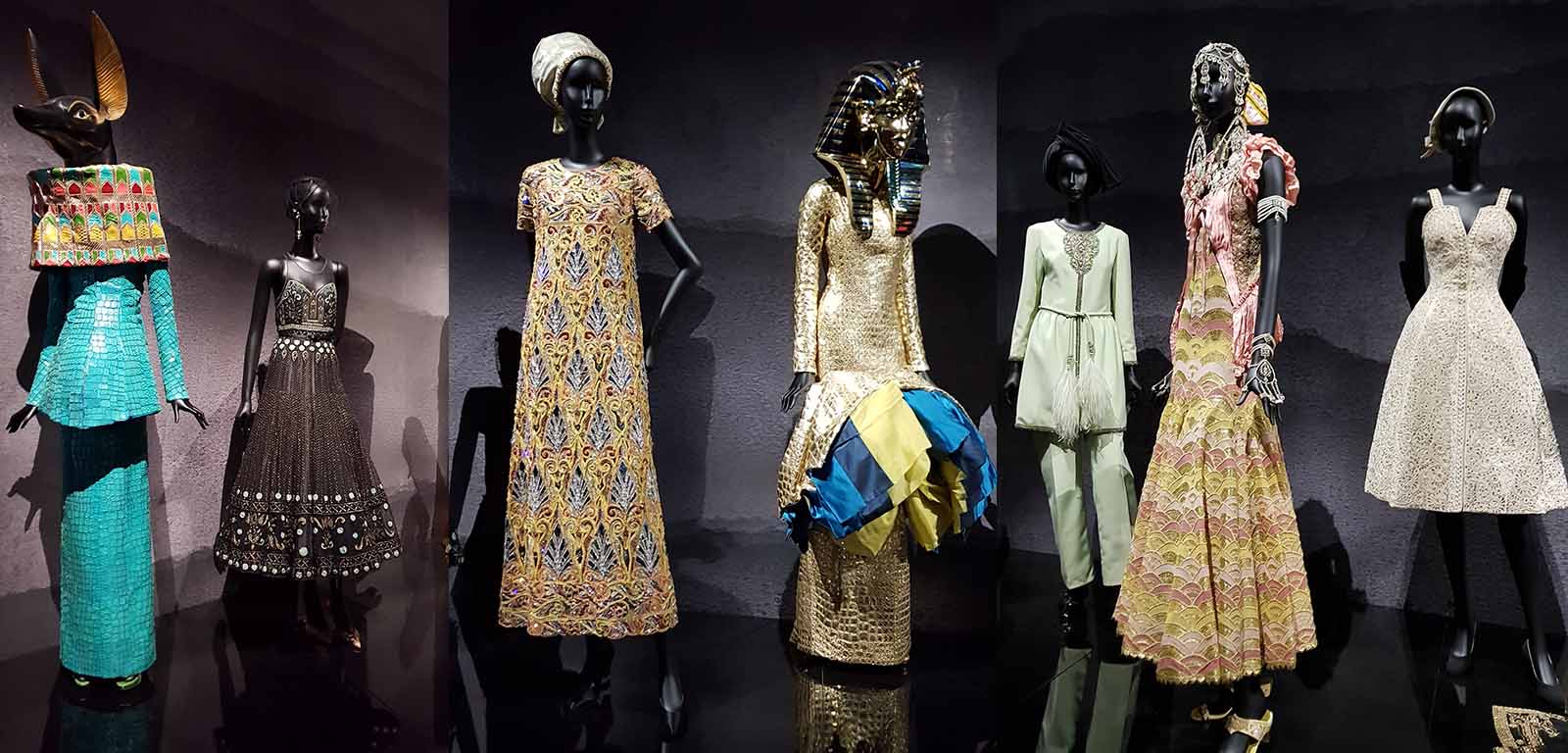
Some of the more experimental and extravagant pieces of the Galliano era are represented here, quite fittingly as he is a British designer and I don’t recall them being part of the Paris exhibition. Egyptiana featuring the head of Anubis and a likeness of the famous death mask of Tutankhamun blends the totemic animism of the ancient religion in sculpture and also the imitation of the scales of the crocodile god Sobek. They look like costumes placed amongst classic dresses for Summer and Winter seasons but perhaps this is Dior’s sense of humour in showing how just once in a while, the House likes to challenge convention. A crochet style weave is present in four dresses above, in a circular cut Black dress featuring White embroidered detail before two dresses work ice cream coloured pastels into Summer Holiday Couture heaven. Farthest to the right a White crystal sewn crochet weave looks like a regal ensemble with a plunge neckline off-setting the linear structured form of the garment. A Mint Green trouser suit carries overtones of Moroccan and Algerian inspired style of the mid 20th century no doubt with resonance for Yves Saint Laurent the second head of the House.
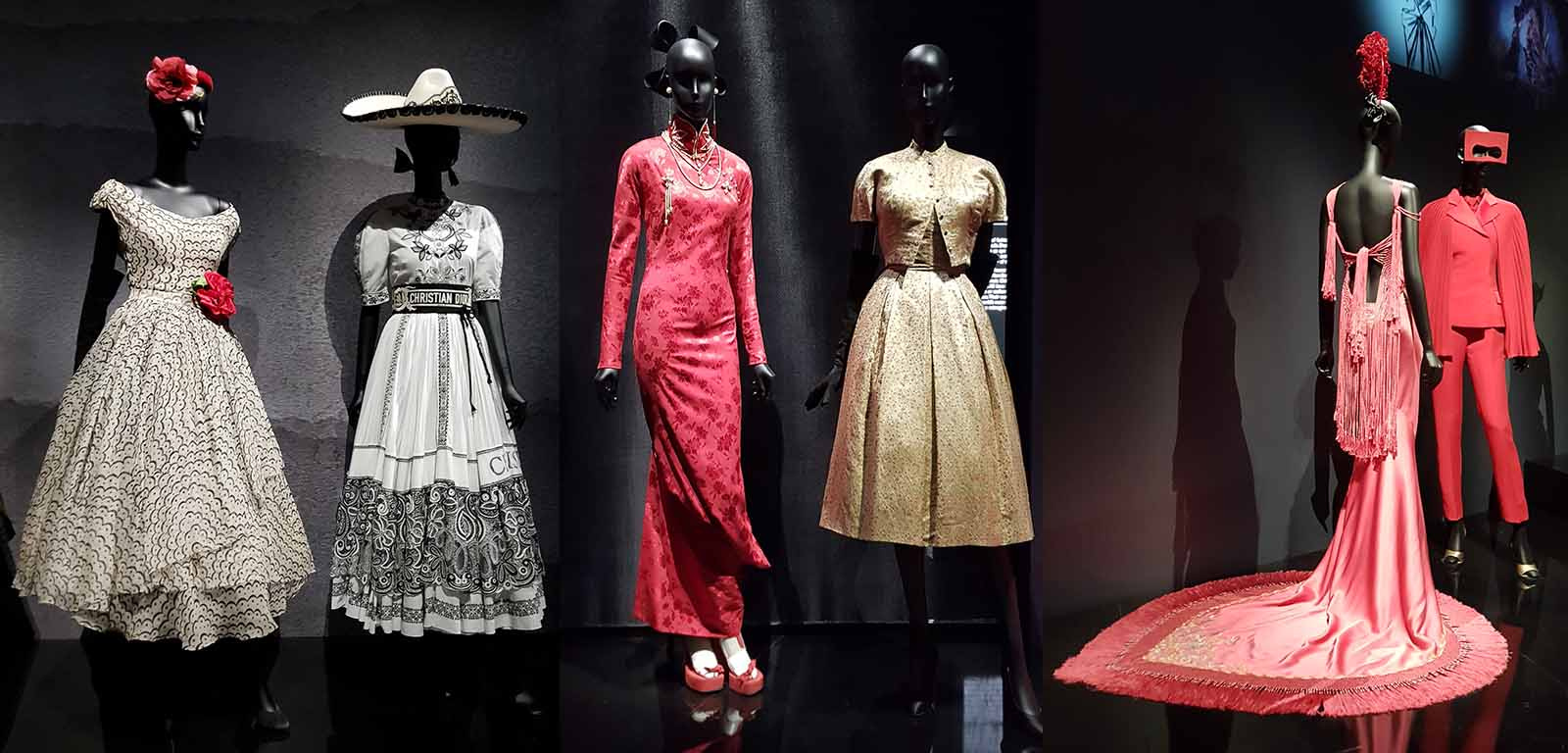
Dior like many fashion Houses covers the world looking for inspiration for designs and none of its designers where more well-travelled than John Galliano. Some of his pieces shown show the cultural eclecticism that he brought to the House of Dior. Mexican vibes walk through the room as the volumes of a Spanish style dresses skirt cloak the figure. A Rose at the high hair parting and left waist break the monochrome colour scheme with a dress paired to it with full Mexican ink drawings bordering a think hemline. Lady Dior, likes to travel and takes the codes of the House with her. Chinese Silks in Chinese style also appear in the presentation nodding to the cultural origin of so many ideas that have flowed from the East. A Magenta close fitting garment printed with florals contrasts the traditional 19th and early 20th century styles with the post war silhouette of jacket and tulip skirted dress. A taste for experimentation is never far away in much of the collection with a slim-line Magenta dress dropping to a dramatic low back and encircled by a deep fabric fringe. A trouser suit with bespectacled hat hints at contemporary art meeting classic design. As a designer having acres of silk to play with must be an enjoyable part of the job.
A Lilac print silk dress in tulip shapes nipped at the waist uses fabric with a confident decadence whilst producing a timeless garment. Imperial splendour emerges below as a suit fit for an Empress of modern times appears with a Regal Purple tunic dress embroidered with ancient symbols representing time on old Chinese script is twinned with a Mint jacket of voluminous sleeves sewn with lifelike flowers commands respect and attention. A headdress referencing traditional floral décor uses flowers found on the blossoms of the tress installed from an Imperial garden.
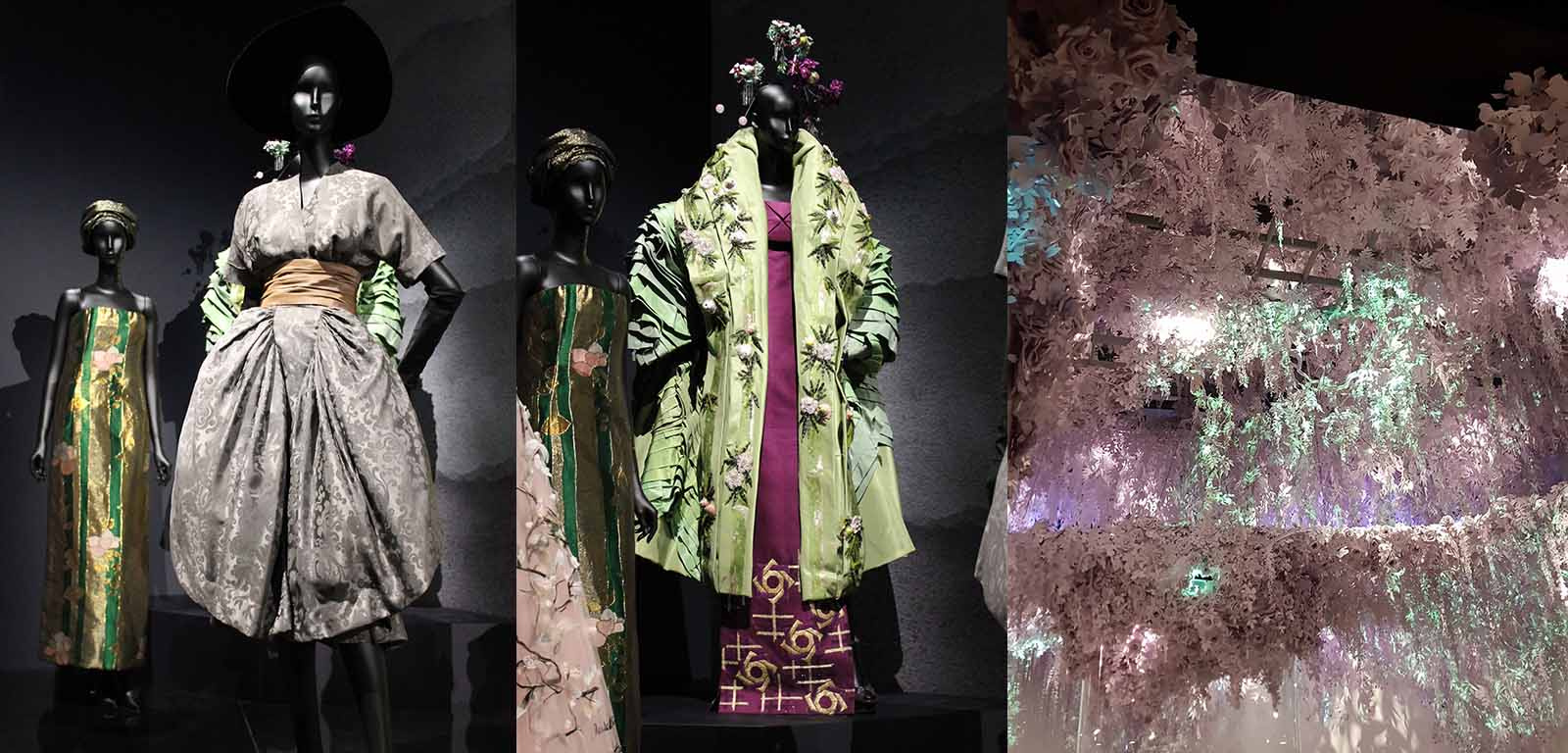
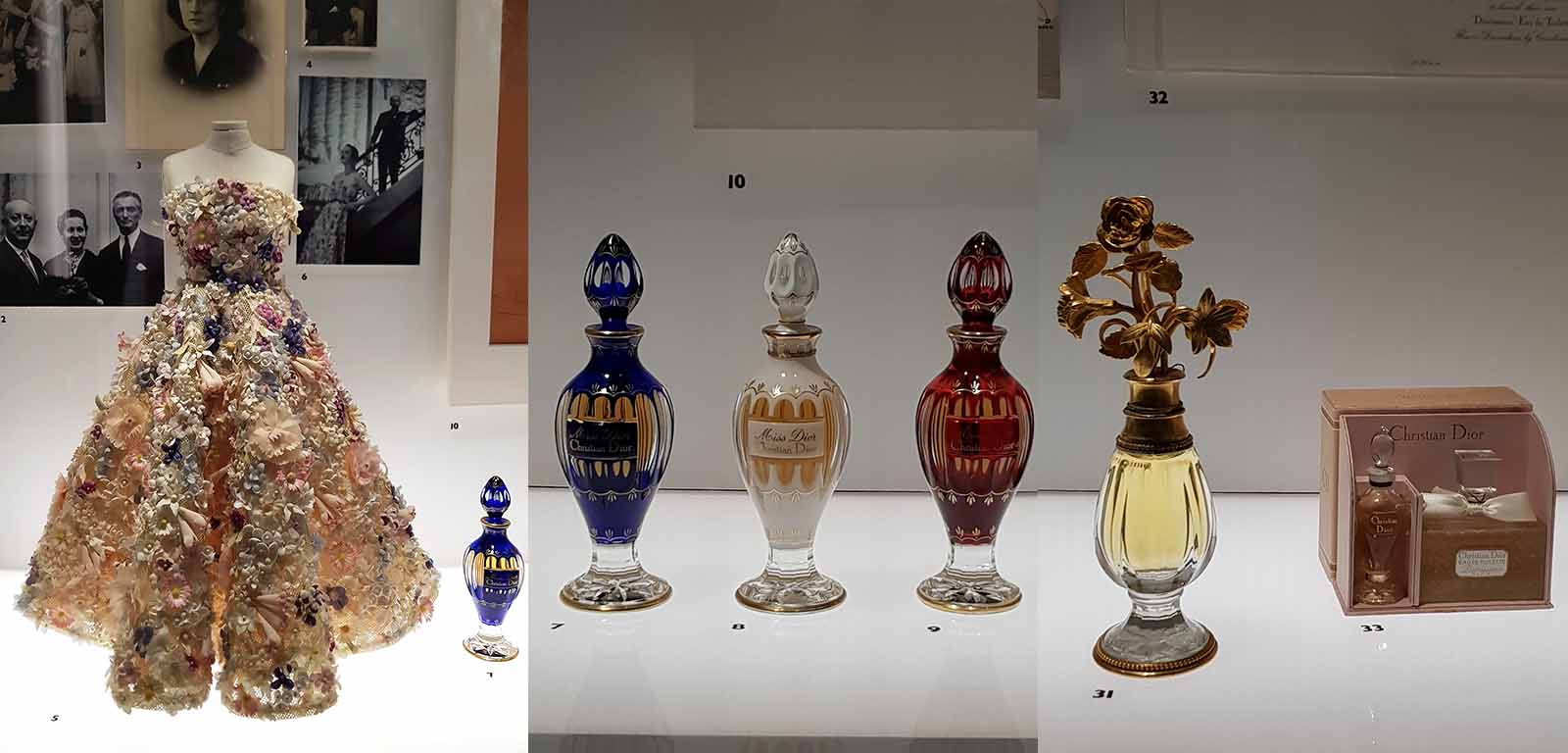
A plentiful display of the perfume bottles and trinkets collected by clients over the decades adorns a showcase weaves towards a circular display of dresses in a garden of delight. Worthy of being collected in their own right these ornaments help seal memories for clients and help the brand endure. Close to a series of bottles a floribunda of a dress echoes the glass colour scheme in the tricolour of modern France.
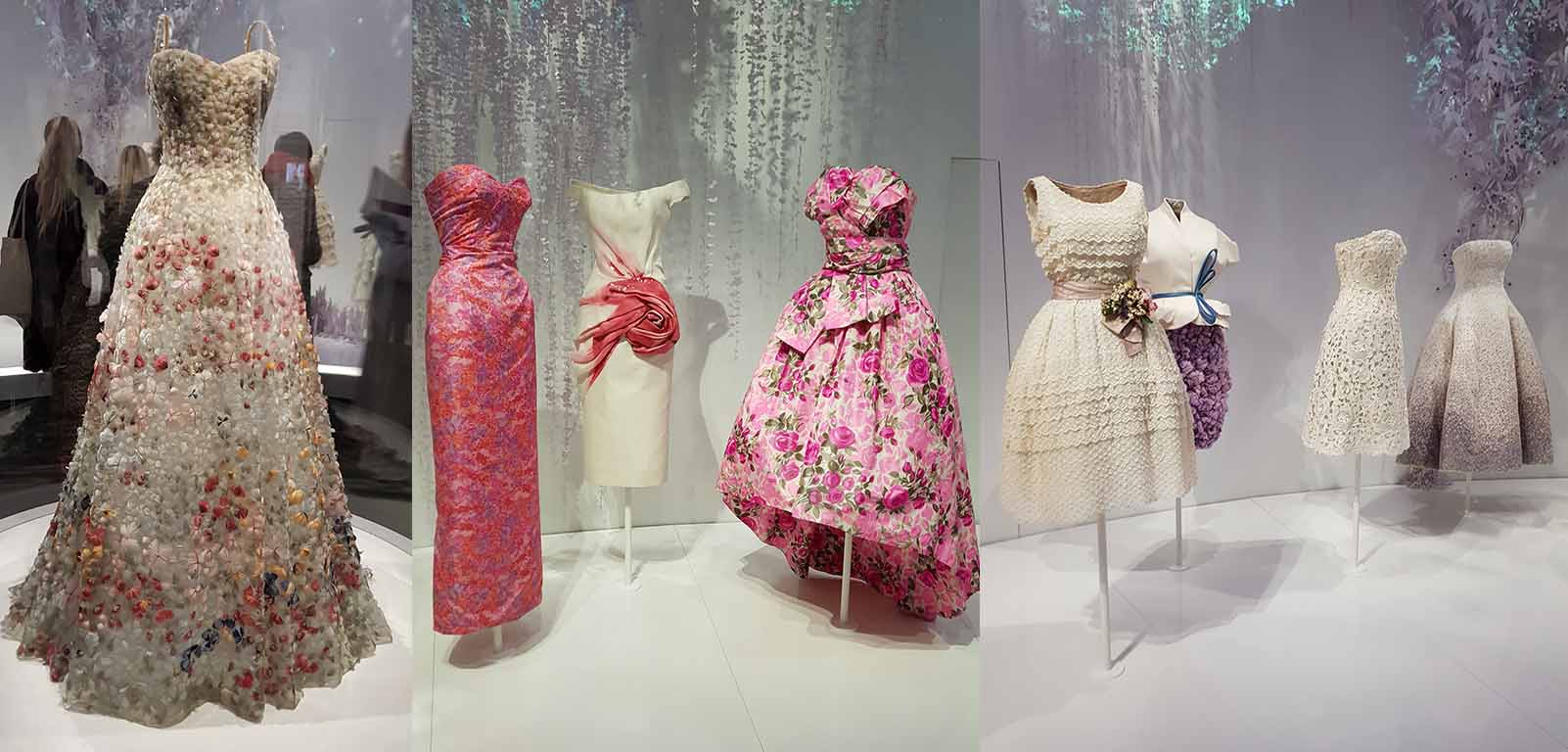
Walking through a garden scene dresses stand like flowers themselves and the inspirations that Dior took from his mother’s garden in Granville on Normandy is very evident in the designs legacy produced by the house beyond his lifetime. In a contemporary piece flower buds appear strewn across the surface of the dress gathered into waves of colour almost creating an image of larger flowers themselves in the style of dot-art. Sleeveless and shoulder-less dresses are a popular theme with an escalloped bodice descending to the slimmest of slim line dresses in shades of Magenta, Orange and Lilac. It should clash horribly but by keeping the colour tone just a little muted it’s simply a fun summer print. A dress appears to grow into a flower itself with the powerful contrast of a Bridal White cocktail look twisting into a blooming Red Rose at the left waist. Expanses of floral fabric printed with blooming roses brings the garden to life around the wearer. Broderie Anglaise, the cool heart of the Anglo-French Summer wardrobe whisks up a piece of perfection in the next look with a Tea dress taking inspo’ from the Edwardian era of women and little girls clothing. Tied at the waist with a platinum ribbon and a sweet nosegay. It looks like the archetypal bridesmaids dress with sweet understated innocence. The White crochet style frame of a mini dress is probably one of the easiest Summer pieces that you will find to wear. Accessorisable instantly with a jacket, wrap or cardigan, it’s a couture garment that could be a ready to wear hero. One of the early Galliano pieces that I saw come out representing the gardens of Granville is a Lilac floral skirt shaped like a flower head that the woman appears to emerge from. A White jacket and Chord tie resembling a bouquets string seals the look around the wearer.
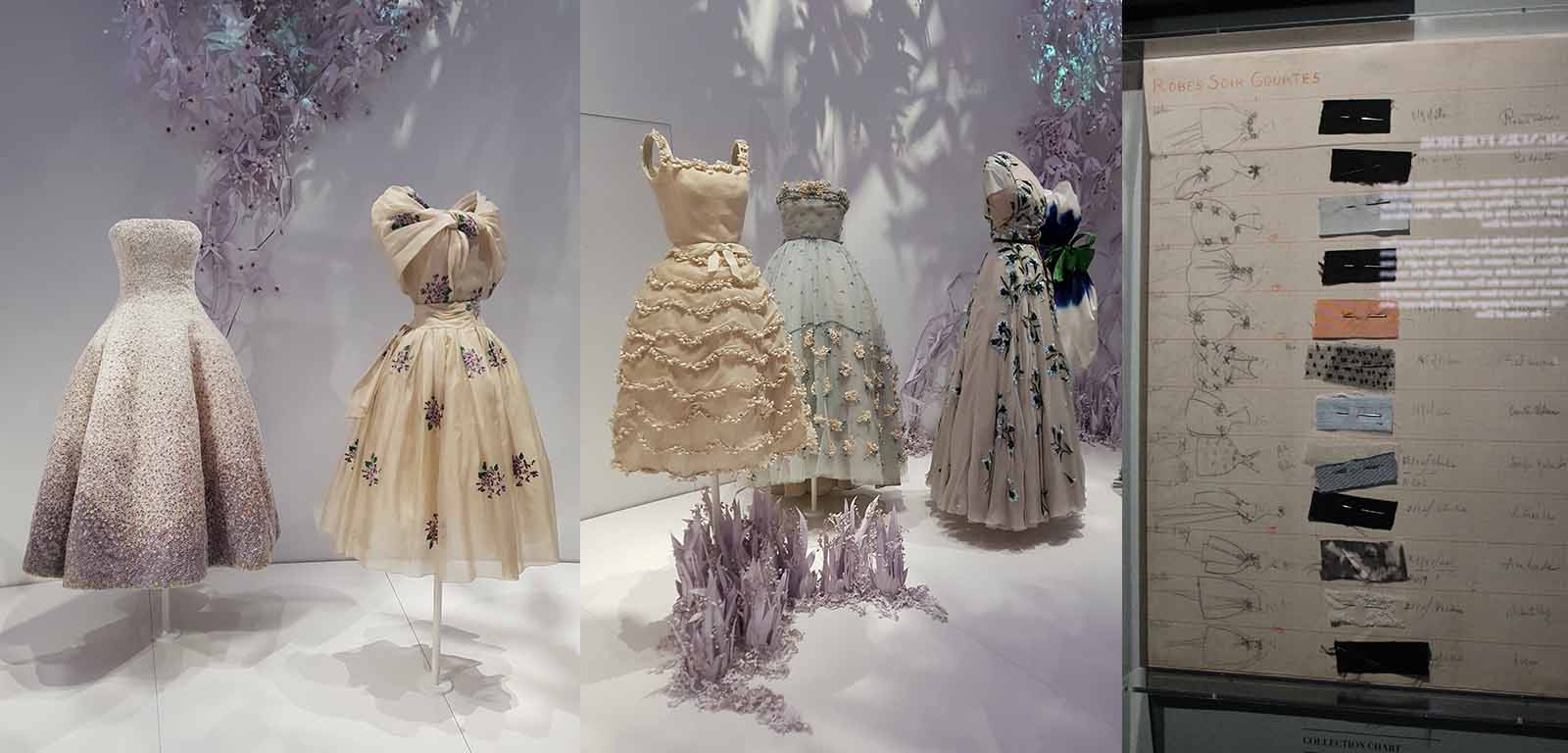
Degrede colour shifts are a subtle style statement and modern design technology enables designers to turn the most wonderful visions into reality and a late Galliano dress farthest to the right and below. A soft Lilac reaching towards the Dior Grey brings light into a muted garden. You can see through this range how Dior works through classic tried and tested styles. The knee length fit and flare dress, the twists in the fabric across the neckline and light floral patterns. Watercolour illustrations mapped onto the surface of the textile are a pretty and gentle on the eye for a Summers day or evening party. Rows of waved beading appear like icing on a cake in a design using the classic knee length sleeveless fit and flare style. In an Ivory silk the classic easy style looks like a dream Summer formal piece in any era and could be worn today for a contemporary bridal option. A bow tied around the waist off-sets the beadwork with a hint of gentle contrast. Two beautiful full length whisper light tulle dresses feature raised applique flowers across the surface almost creating a wearable raised flower bed. In lightest Blue and Lilac the simple colours would suit most wearers. To the right sketch and swatch chart shows the colour planning and preparation thoughts that go into the design of each garment. A piece of fashion history in itself to treasure.
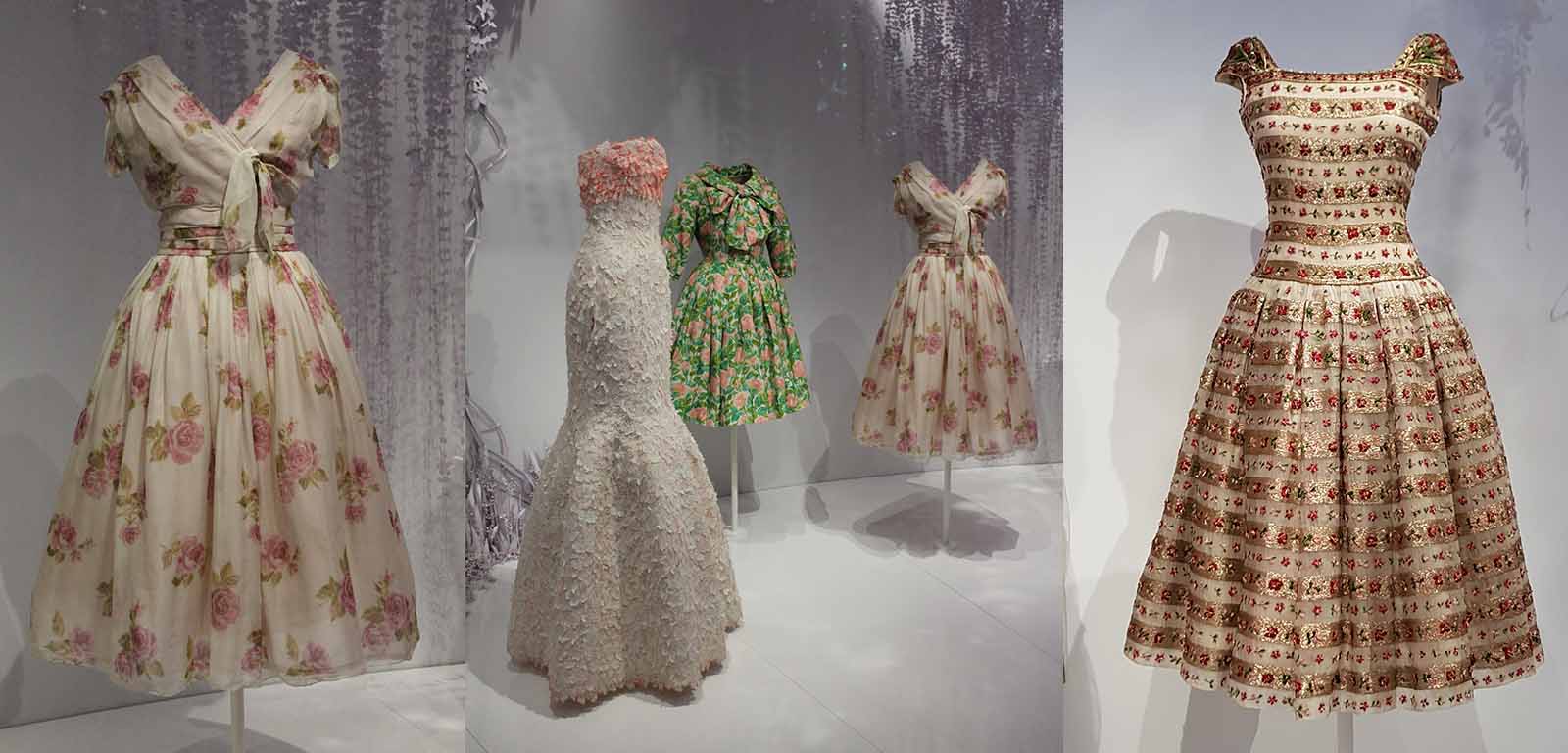
The frieze above is 'bookended' by two of my personal favourite pieces from the collection. I'd happily take them out for a day or evening in the sunshine and I think many other people visiting the exhibition would feel the same. The Rose was at the heart of the story for Dior and the dress above to the left with it's masterpiece-perfect painting and soft carefree use of fabric tied around the waist to create a soft belt with a sash at the neckline. To the right an evening dress with the Red and Green metric of the Rose is sewn with Golden bands of cloth interspersed with sheer Blush tulle. It's a subtle but striking piece that will quietly make an entrance and play with the reflections of light in a beautiful way, either natural sunlight, illumination or moonlight. Centre above a raised surface of a White floor length dress adds a contemporary take of 3D texture to high fashion piece. Swathed in Pink Petals at the bodice it's softly flared skirt creates a contemporary fashion meets art statement. Another expression of the Rose bed at the back in a Green dress with large bow tie makes a bold colour statement that would have made the wearer stand out at a garden party or reception.
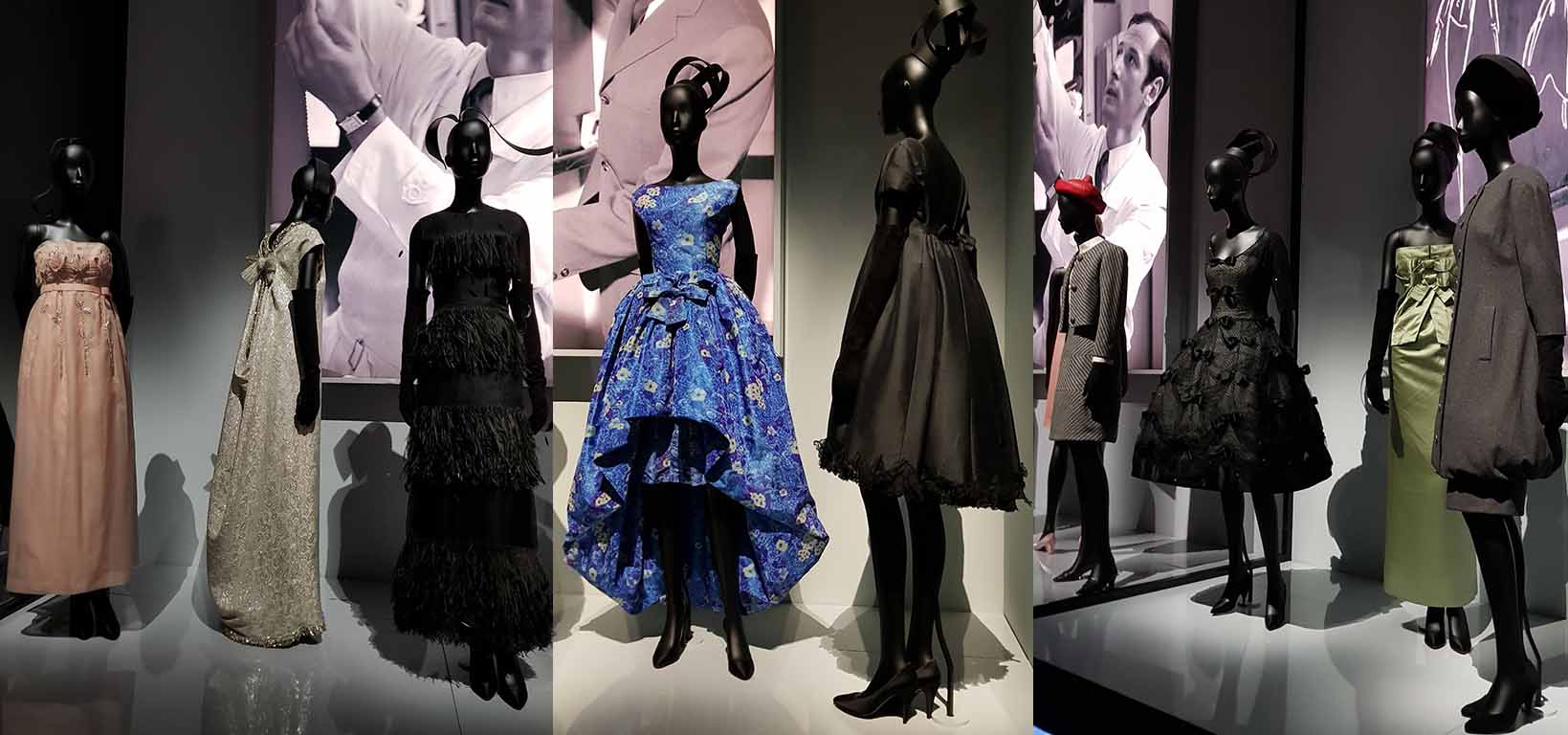
Evening dresses, cocktail dresses a profusion to meet your fantasies, this is what Dior has done best to the greatest acclaim since the House was founded. Since the passing of Dior himself this House has arguably chosen successors to date (with perhaps only one exception) who have carried the torch of the founder far into the future. This in itself is a feat that not many fashion Houses manage as the day an originator departs a Maison, the challenge begins. Do you stay still, do you innovate, if so, then by how much. Should you wave the White flag and close when clients become bewildered or hire a new creative director to turn the tide and re-capture the commercial and spiritual savoir faire that made the House so strong in the first place. These questions that are often thought of as artistic whims and fancies cut to the heart of the balance sheet of giant global fashion empires and sometimes, in my humble opinion, the eye for the balance sheet dominates rather than the pure channelling of creativity which, I believe in fact take you back to pure profit. It's a complex path to navigate, but Dior generally has through the 1980's, 90's and successfully through to early 2010's.
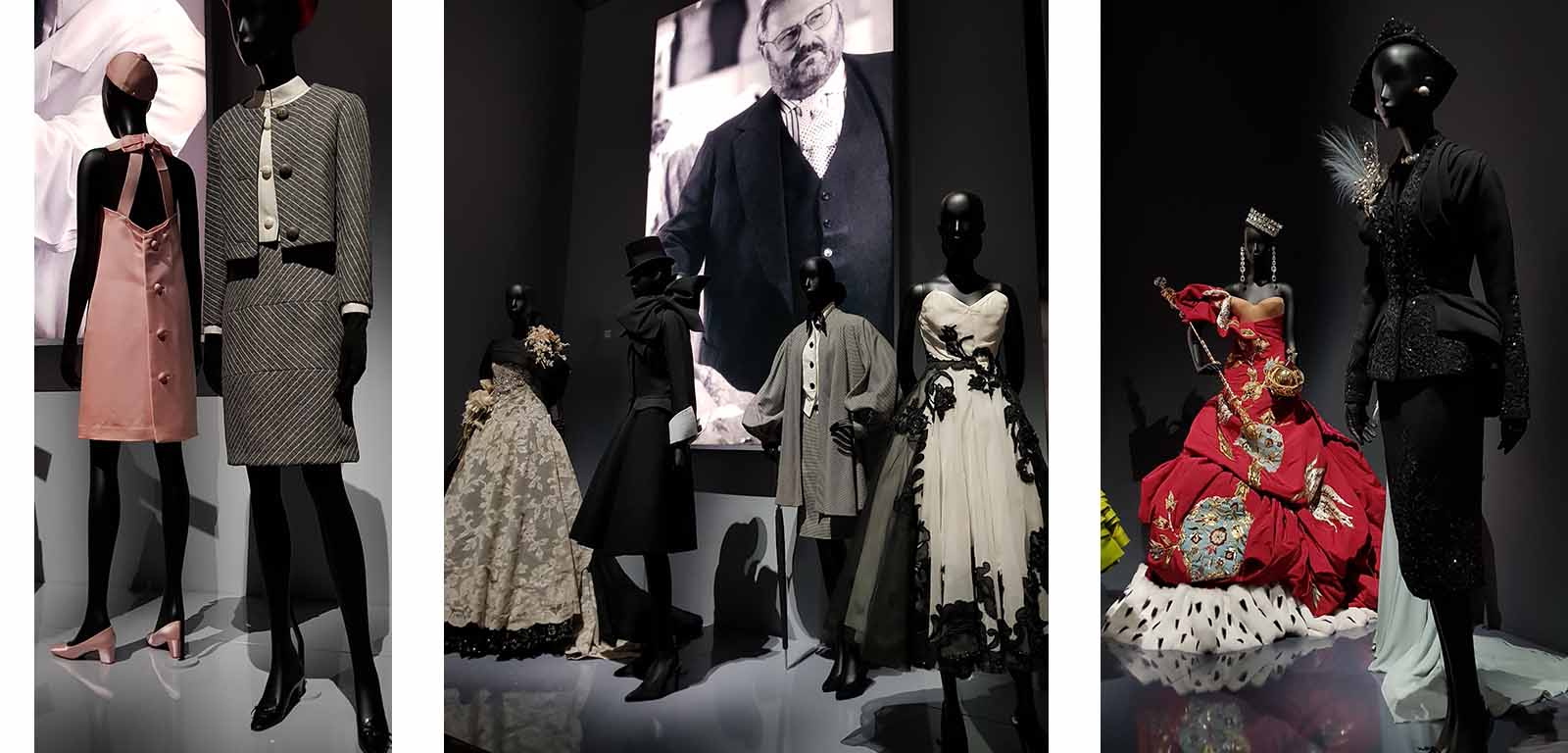
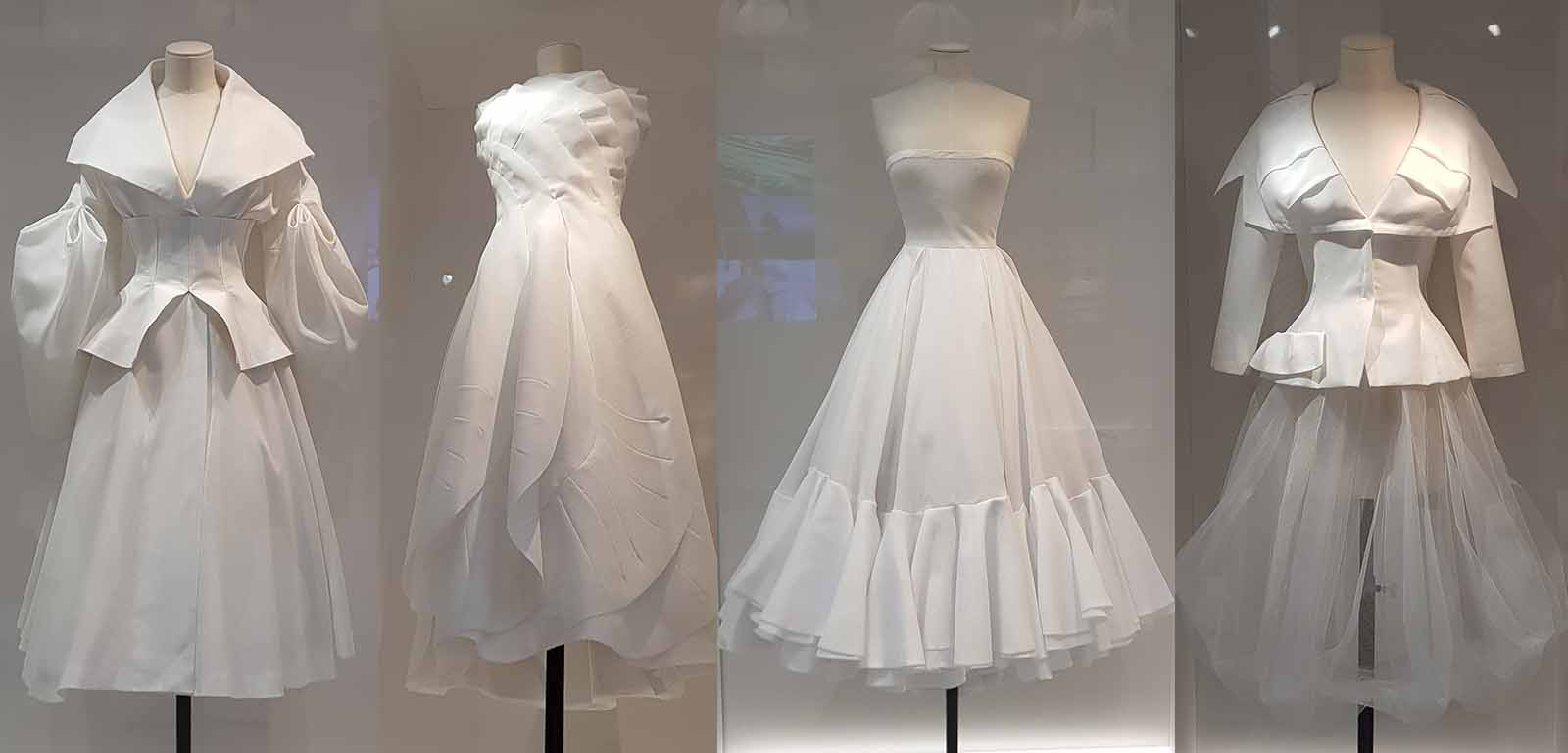
I'm sure I'm far from the only person fascinated by toilles and their allure promising future creation. Likes the ghosts of things to come they waft mysteriously through atelier across Paris, London and around the world. The spiritual doubles of the couture clients to whom they have been fitted have an extremley important role in helping to create the dreams and desires of both clients and designers come true. They are also, I believe, collectable items in their own write. Above left a suit is in fact an almost complete template with a obe tie at the jacket waist balanced by puff gathered sleeve arms. A flattened broad collar matches the fit and flare mould of the classic Dior contrasts. To it's right a dress with the undulating ripples of petal folds encircles a future client in a Thumbelina flower girl style. She becomes the stem itself and the starting point of new life. A broad skirted cocktail dress heralds the rock and roll meets 1980's look in a chic circular cut dress with raised hem that could be at home in any era. A half complete look shows a jacket and sheer under skirt waiting for the pocket bag and outer skirt to join the assembled layers.
The vaulted gallery leading ever upward displays toilles of jackets and dresses in various stages of construction from the barely there to the almost complete. It's not only the toilles that are crucial. A, Haute Couture client will have pieces fitted to a model padded to reflect her exact measurements that can be padded and slimmed just as she changes shape with the seasons. In a world where frankly women have been put under tremendous emotional and psychological pressure for the past few generation to change their bodies to look like a designers archtype, this is a welcome breath of fresh air. And back before the age of mass produced clothing, it was how all women dress. To the left below two toilles look ready to be worn by their owners as perfect light Summer pieces.
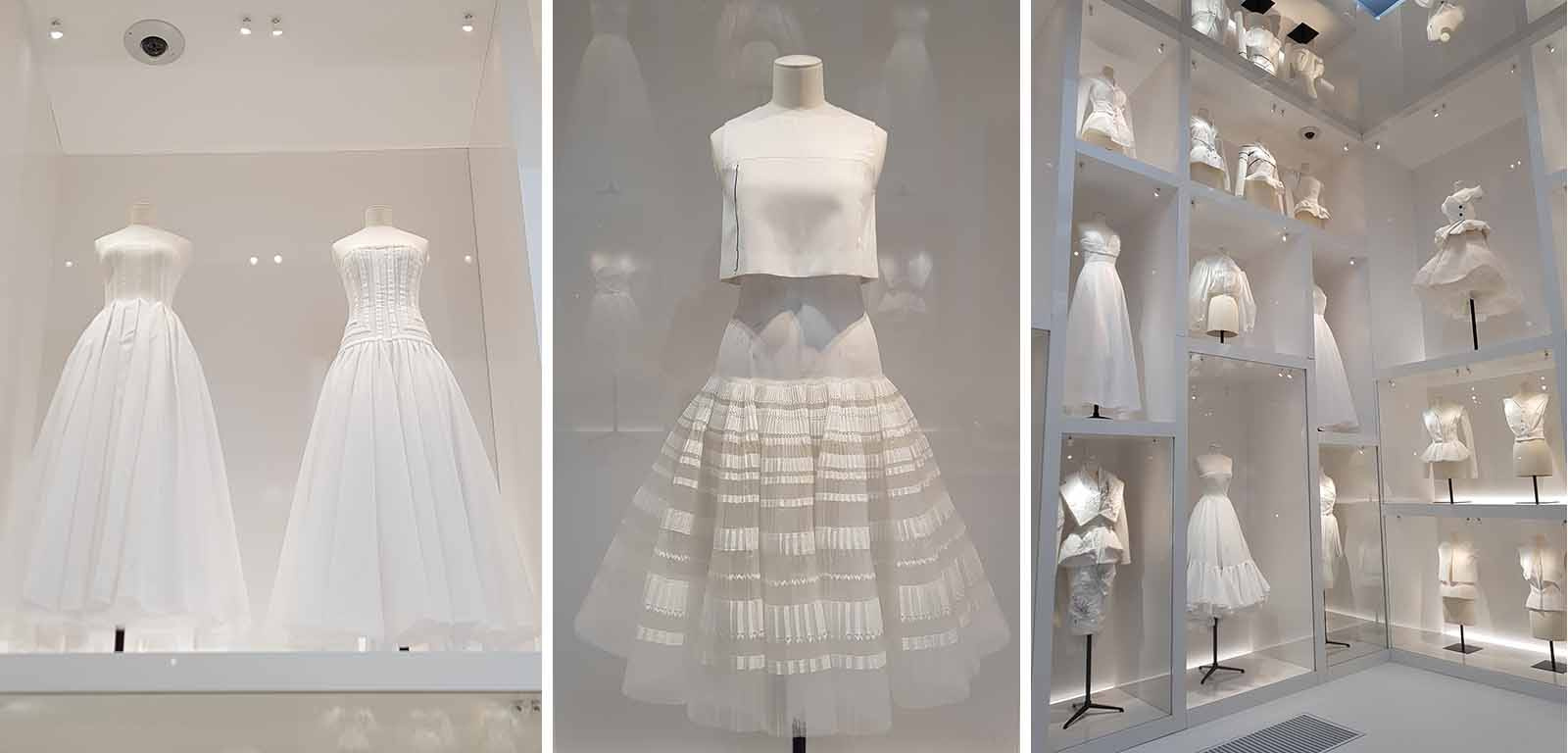
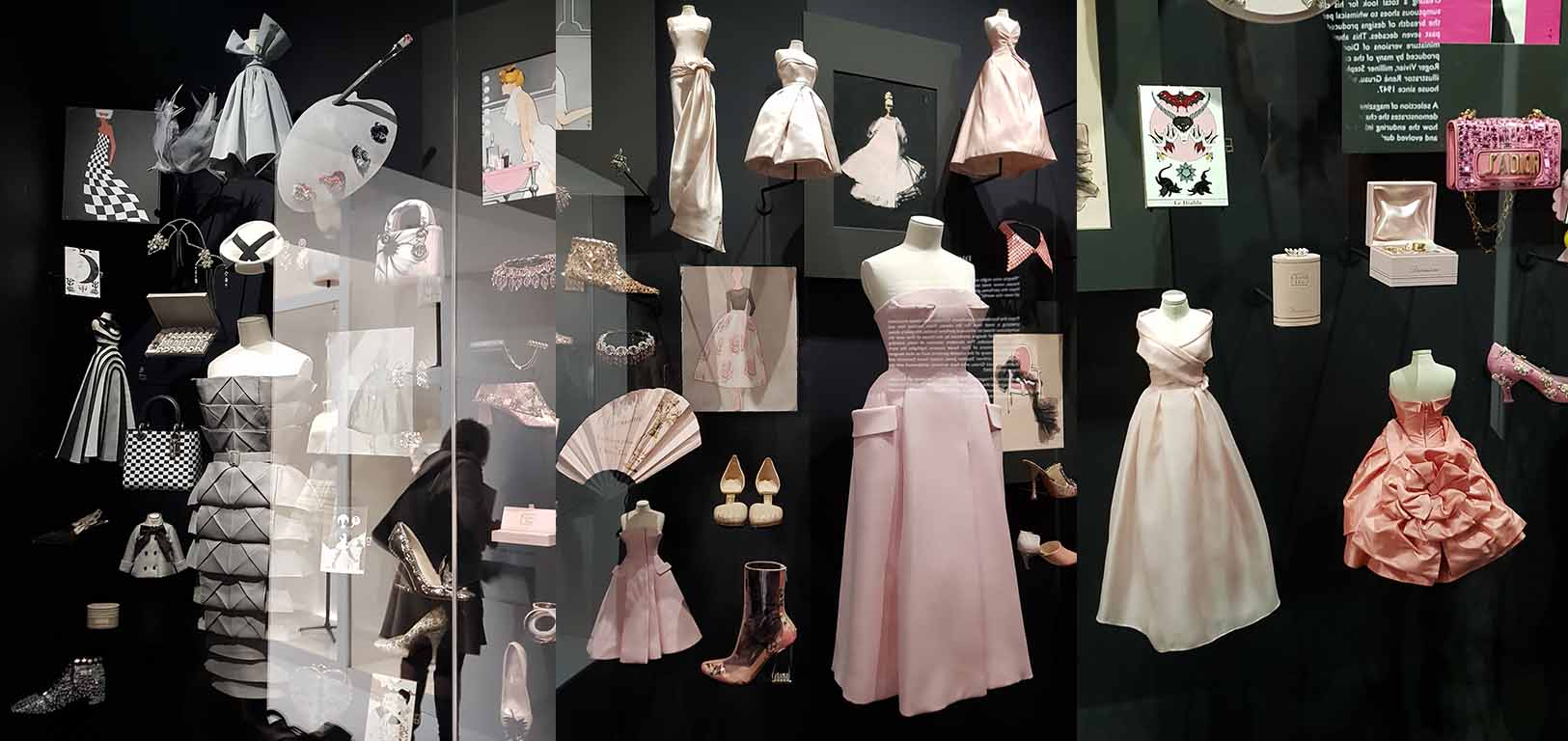
The coloured cabinets, as I called them after seeing the Paris exhibition, returned once again in a skilfully edited down version for the London show. This was one of my favourite parts of the original exhibition as it shows the purity of both style and colour in one simple flowing movement. For me to see this from a designers atelier is the ultimate palette and mood board. The constraints of space allowed a sharper editing eye to do it's thing. The purity of the colours and the mini and 2/3 sized dress are probably my favourite part of looking through the panels. Opening in Dior Grey and then warming to a Baby Rose, through Peach, Tangerine, hot Pink and Magenta. Blush gives way to Saffron then Green and Blues through to Midnight. In the first cabinet a Grey dress stands motionless close to a hat formed of paint palette heralding the start of the range of coloured garments from the atelier archive.
Even when working through one simple genre such as shoes the myriad of different styles concocted is fascinating. Moving to the centre image above a fan is finely pleated with intricate detail to add the final touch to a look. A truly fascinating series of mini dresses in the lightest baby Rose offer tantalising style ideas that Dior wanted to give to his clients. The three broader skirted looks would suit most figures and to the lower front of the cabinet you can see the same outfit worn by a doll made up into a 3/4 sized garment to give the atelier team and the client a clear idea of how the fabric will fall on the figure. Behind a guache painting is a beautiful piece of art in it's own right and can give inspiration perhaps to pick up your colours and design. To the right, two dolls wear the simply draped styles that made Christian Dior so renown. A sash crossing the bodice, a rosette skirt cross from baby Rose into Peach in formal dresses that you could still rock to a gala or ball this year or next. I defy anyone who wouldn't want to wear vintage Dior brought back to life and suspect it could be a great favourite with current clients.
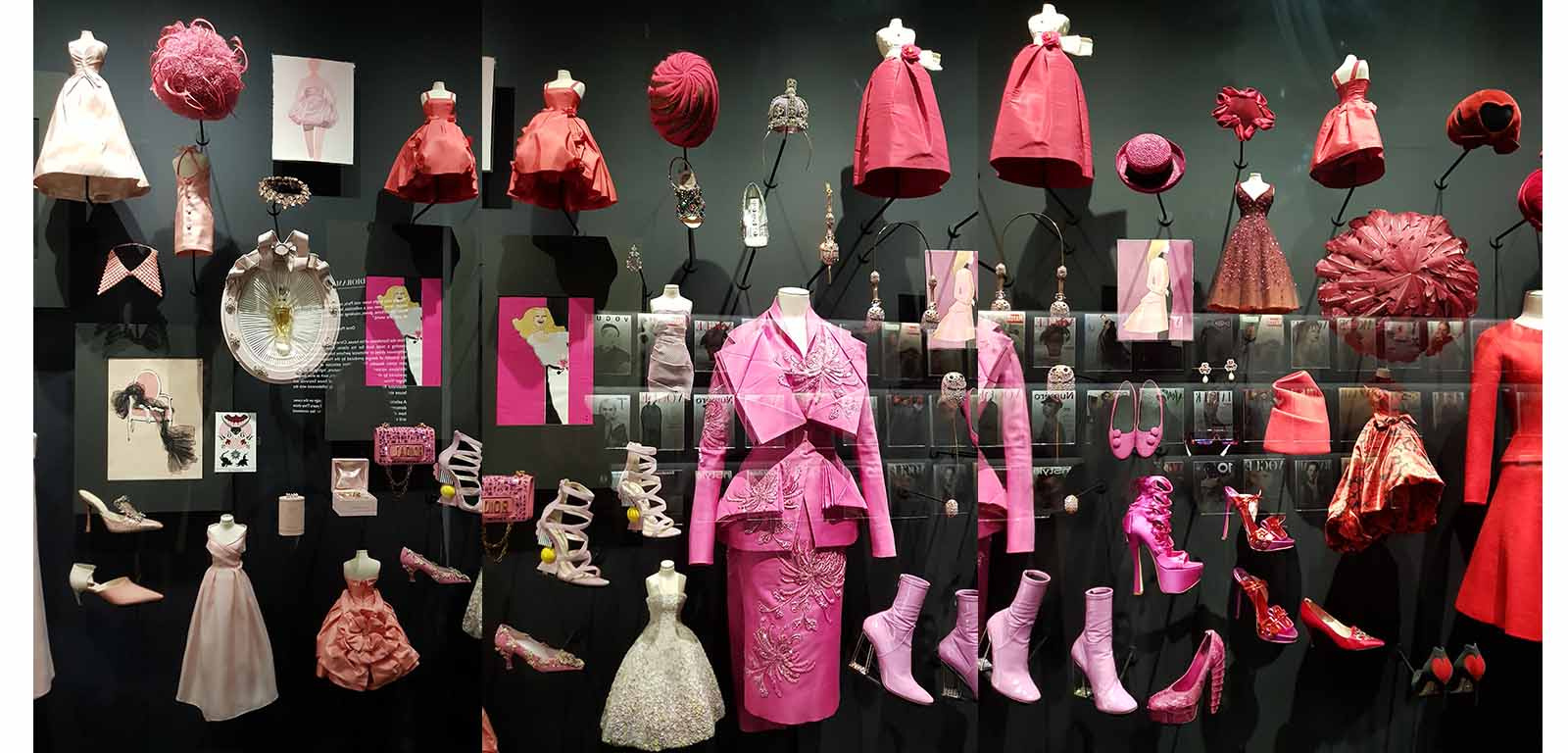
Despite the styles looking very classical, there isn't as much conformity as you may imagine and many of these designs where fresh challenging ideas in their time. It's true that some of Dior's women can begin to look like ornamental flowers to our eyes now but in the mid twentieth century the daring cuts of the dresses and fine styling spoke of a desire to be different. Daring to use colour after years when fabric and dyes where rationed and cutting women suits with a boldness to match anything of the carefree 1920's and early 1930's. Magenta heads towards Scarlet with a colour crush whirlwind of pieces that give the Dior shoe a focus. It's part of Dior's repertoire that isn't so well known today but an area where he justly created some really interesting pieces.
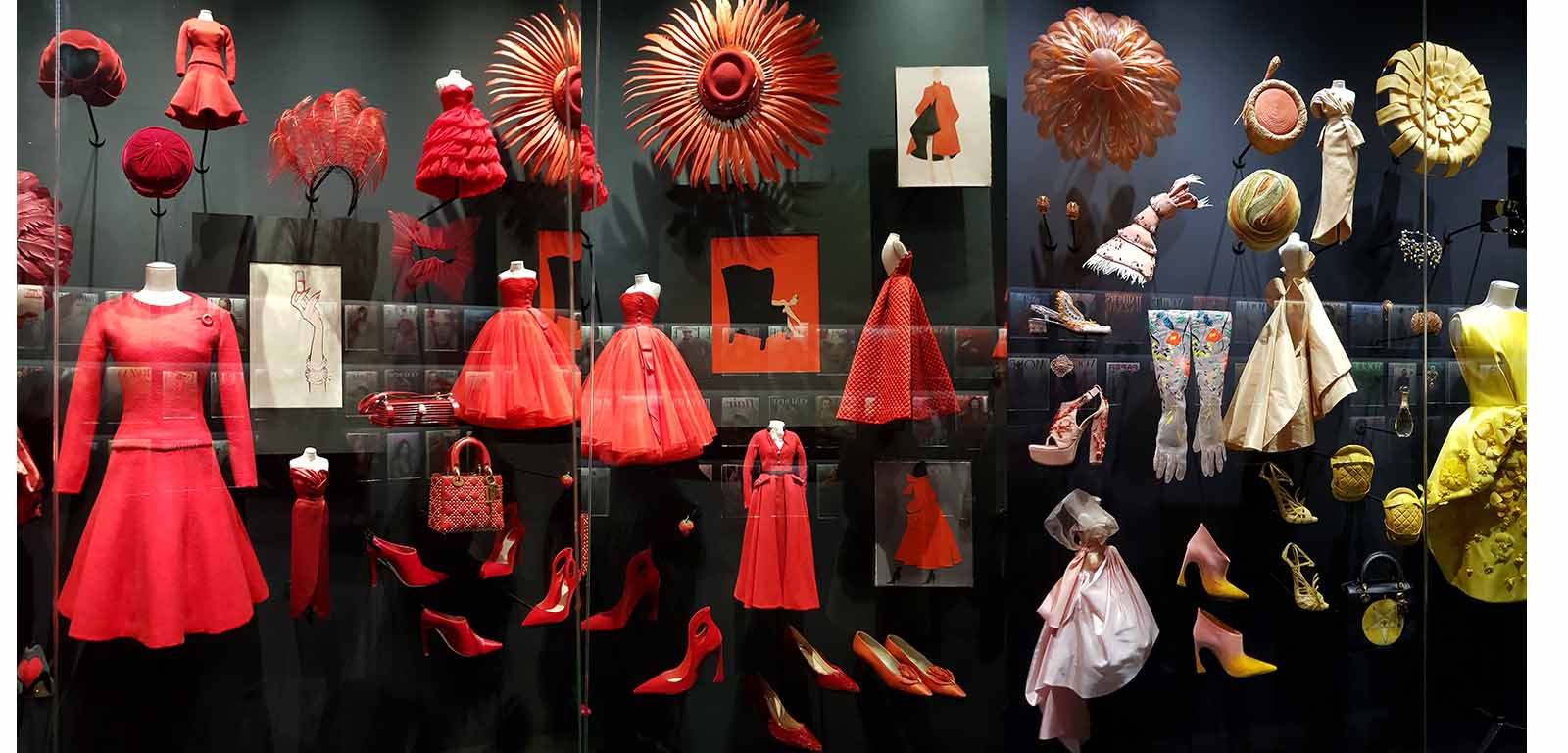
A Scarlet satin suit is positioned beneath it's doll counterpart with garments and accessories in mirroring colours positioned all around it. A plumed hairband and, quilted Dior hand bag and midi-length organza tulle doll dresses offer scope between the classic wide styled flared skirts and the long wrap-over designs. Slippers walk the viewer through the collection towards a Lemon Yellow that glides into Saffron. Soft hats and caps bring a floral touch evoking the to the gardens of Granville in the client's wardrobe.
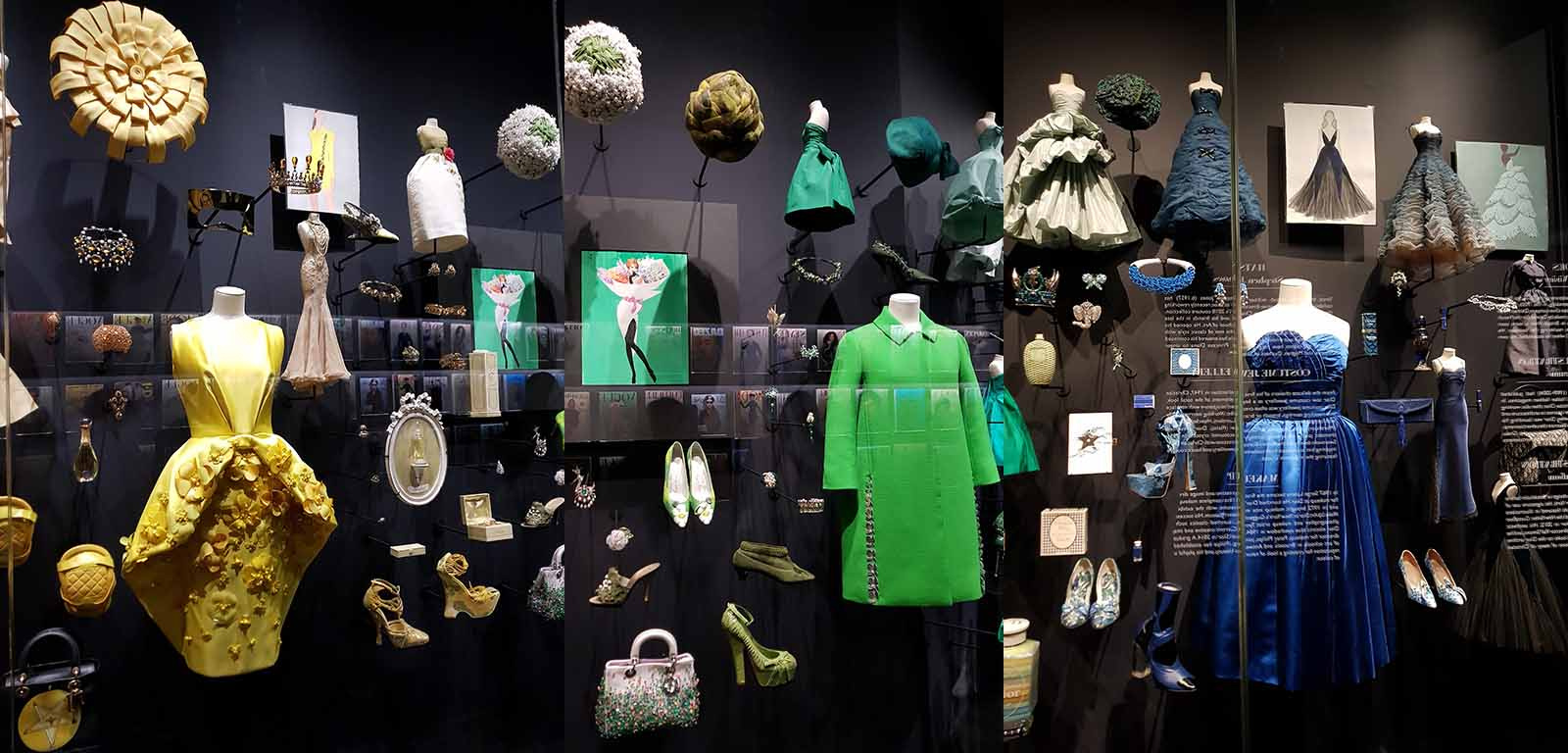
This part of the frieze features exquisitely embroidered gloves and a dress sewn with beautiful flowers running across the surface. Side sashes echoing the traditional Mantua form are still in use today by Houses such as Catherine Walker to give a stylish edge to formal wear pieces. Even the perfume bottles is in their own frames like a work of art to be viewed and admired before embracing the sensory pleasure. Costume jewellery was also supplied to clients in the past and easy to travel with compared to it's more luxuriant counterpart that Dior now specialises in. Green isn't an easy colour for many but it's now back in Vogue and Dior here shows the mid 20th century below-the-knee length dresses with the enduring allure of the beautiful satin gown. To the right above Green has cooled to icey hues and the turned to Blue amongst a delicious sea of dolls and 3/4 sized dresses that run through to midnight Blue and Black. As I've already mentioned in this piece, I think it's difficult to imagine that there are not Dior clients present and future who would not wish to commission some of the dresses shown in miniature above and below. The 3/4 sized Lapis Blue dress in particular looks like it would prefer to walk out of the cabinet and attend one of the numerous galas held at the museum.
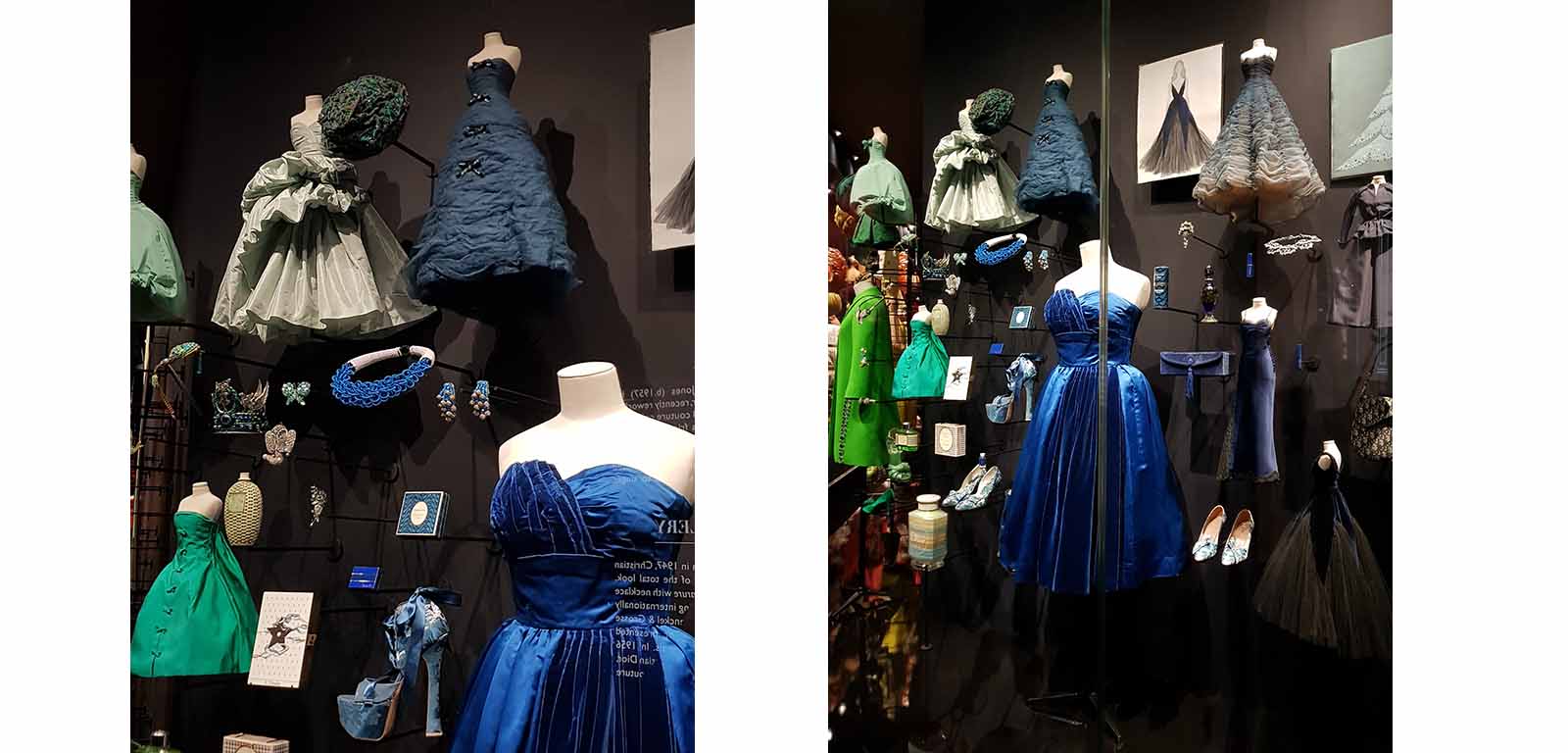
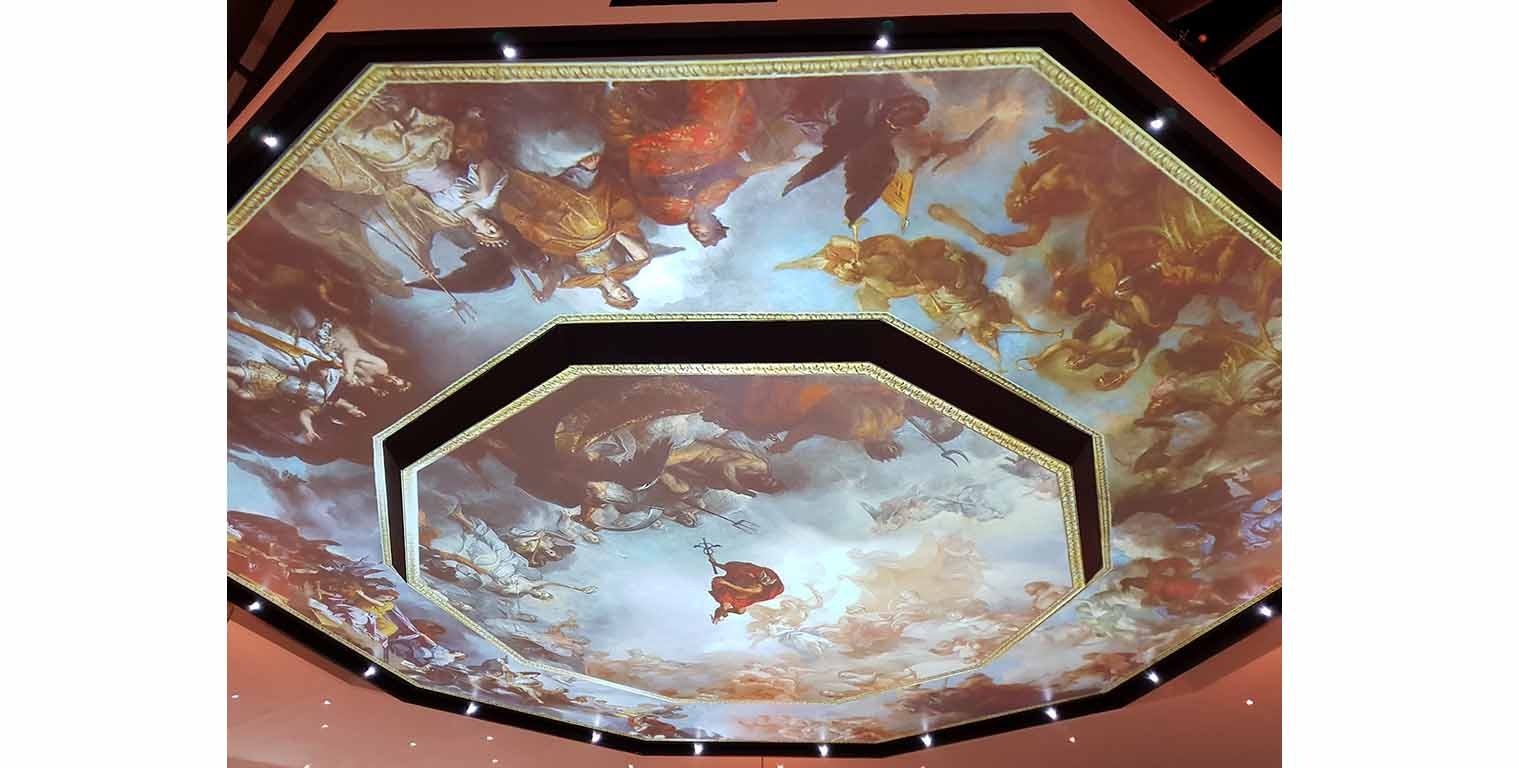
And into the wonderous ball room for a spectacle of day followed by night, followed by day. A journey through the ancient cosmos and a tremendous feeling of time passing beneath the planets and the stars. The scenes from ancient mythology that where so popular in the Renaissance and Baroque eras fade in and our across the ceiling and made me long for another visit to Italy, where like France, a tiny part of me feels at home. The vibrant colours of the regal painting give way to the brightness of the sun and the cool of the evening stars. I also felt that there was a resonance to Ancient Greece.
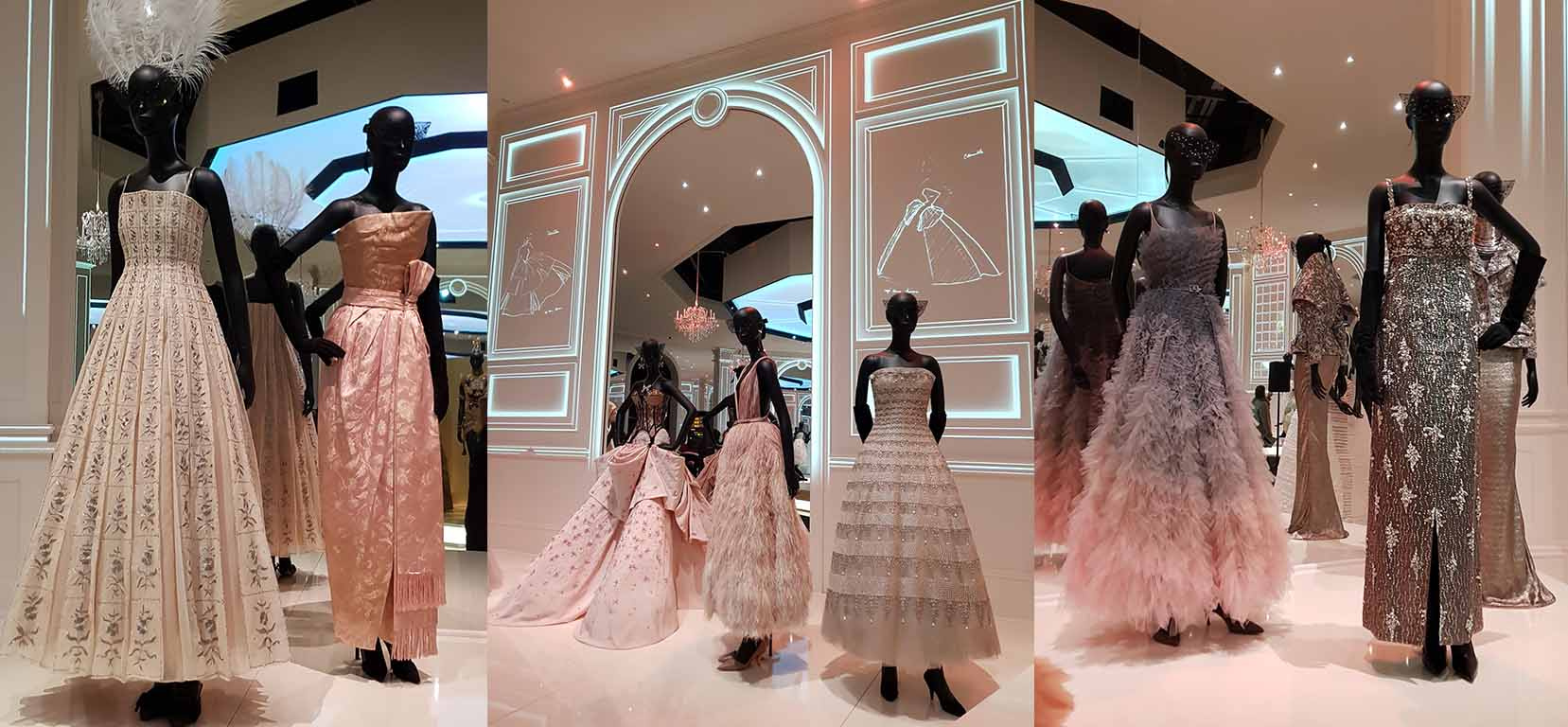
The dresses in the ball room looked extraordinary. The depth and diversity of the designs was as astonishing as you could wish to see as the models appeared to be speaking to each other or waiting for a performance to begin around the central plinth. To the left a dress composed of pleats and floral print panels slowly broadens out through the lengths from the bodice to the above ankle skirt. The fine detail of the flowers is painted with as exacting clarity at the bodice as the in the larger skirt lengths. If you look carefully, you can see that beyond the waist-line area of the dress, each row of these pretty illustrations has a slightly increased size. It's details like this that captivate many people in the magical spell of Haute Couture. To it's right a dress in Blush Pink printed silk uses one fabric in contrasting approach. A firm bodice shaped like a cone around the figure descends to a wrap around skirt tied with side sash and fringe tassels. It's a comfortable evening dress to slip on and party in.
Feathers are a timeless staple of design and when dyed in degrede colours, they create a subtle illusion that looks beautiful under all lights. Tiers are a style theme that Dior have often used to define the long lengths of a garment. The wearers height can be emphasised or diminished by depending on how the look is styled. A dusky Violet descends to a budding Rose colour through layers of gathered frothy tulle in a dress above to the right. It has several close counterparts through the room and again shows the expert skill the House has always maintained since the days of the founder. To the right, the stars of the night sky sparkle in crystal under the sky canopy with an ethereal shimmer working through the lengths of a column lined cocktail dress.
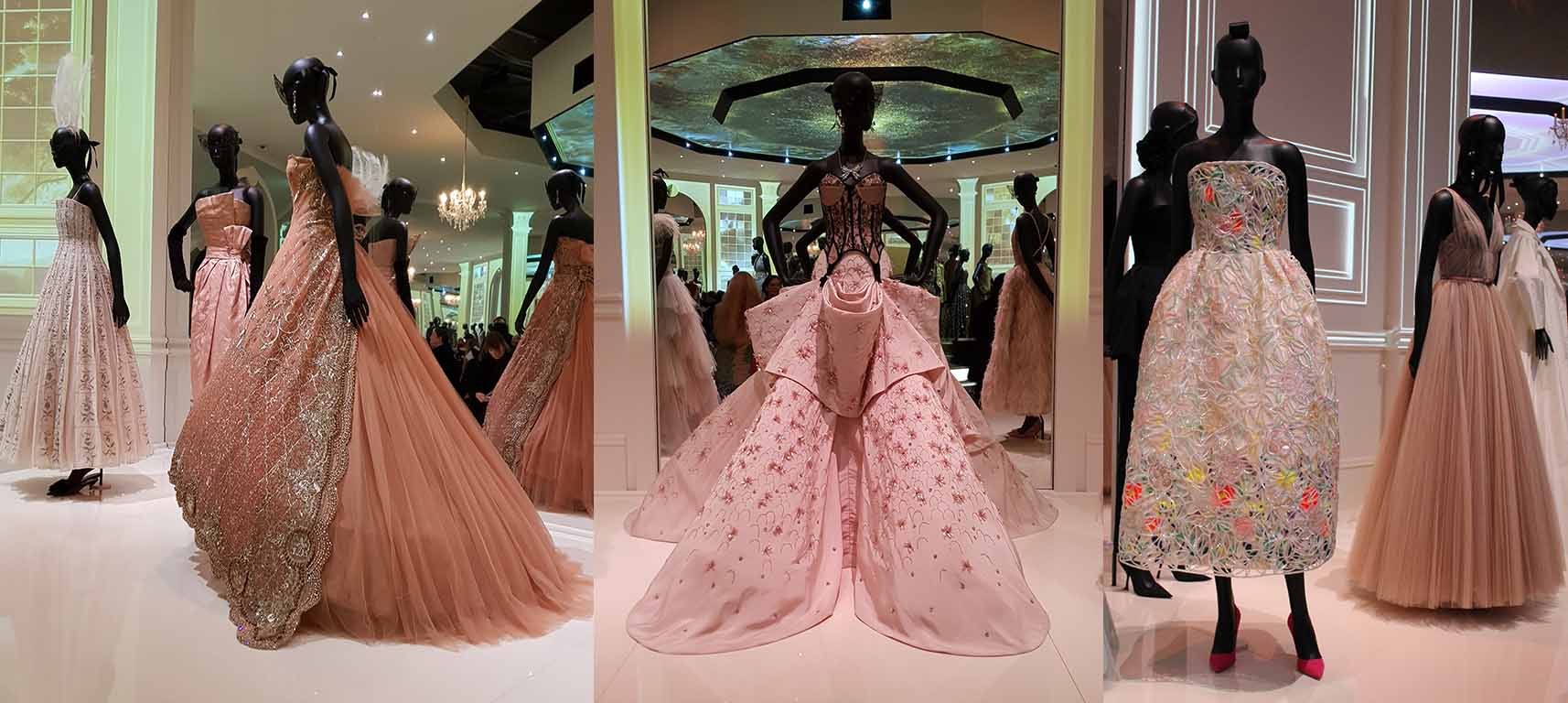
A fascinating dress in Salmon pink above combines and apron sewn with Silver thread in an intricate design, resplendent of Indian fabric with carefree layers of gazaar silk in the lengths of the dress. The gown flows behind the wearer in a circular style reminiscent of the Victorian and 19th century era with the subtle contrast between the fabrics giving the look an opulent dynamism. It's a jewel of a dress in it's own right and one that many clients would relish the prospect of wearing to memorable occasions. The hall of mirrors setting that echoed the ball rooms of Europe and the Americas over the centuries was the perfect setting to show the 360 degree view of the garments. Every inch of the dresses must be perfect to pass the approval of the hawkish eyes of the atelier. Centre above, one of my favourite looks that shows how Dior can create conceptualist fashion as well as classic glamour.
A dress is created using parts of the traditional Rose flower shape. Fabric is gathered around the waist in layers and a dress skirt is banded in four voluminous lengths sewn with crystals across the surface. In contrast a corset dress bodice cinches the waist in and defines the upper figure in hints of evening wear whilst the skirt lengths recall the floral colours of daytime. To the right a lattice floral design is semi-sheer with cut-away segments allowing some air to flow through the dress on warm evenings. Cut in the classic style of the post-war era, the contemporary exploration of colour and nods to a re-fresh of the spirit of the garment. To the far right the simplest fit and flare style in Blush tulle is gathered across the wearer and is flattering in it's simplicity. It would be a super choice for those very hot nights of Summer whilst could also shield against breezes with a wrap or jacket.
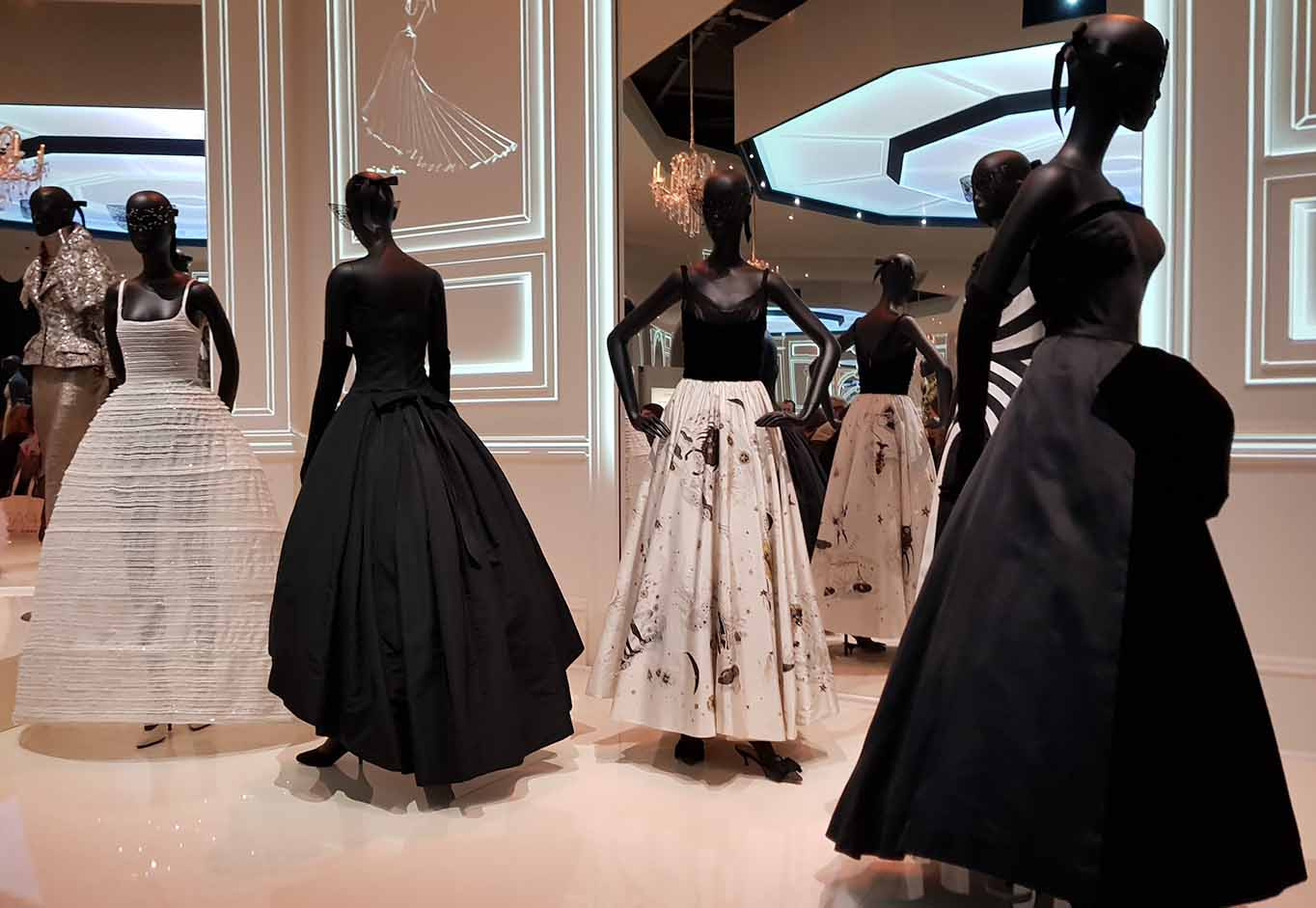
For me the above panel speaks so clearly of the elegance that Dior have created for generations of women through their Haute Couture atelier. In the warmth of the light of the sunset segment of the 'heavenly wheel' of the day you can see behind this series of looks, designs appearing across the panelled walls of the ball room as if drawn freehand by Monsieur or one of his successors. The flourish of the hand bringing creations to life all around as you walk and turn to look at the multitude of gowns units the dawn of the creative process with the finished piece of society elegance. This series of looks captures the essential elegance of the Black and White style. It's a timeless classic code that still offers designers and clients who wear the garments huge scope to come up with original and beautiful pieces to add to their wardrobes. A sheer circular cut hemlined dress from a more contemporary collection marks a bold juxtaposition to a classic Black satin silk cocktail dress with a bow tie at the back and flowing petit bustle lines. A fitted bodice allows freedom to move whilst dancing or moving through a party and although refined to precision, this is a light look to wear through the duration of an evening. A White silk skirt patterned with illustrations counterbalances the Black velvet bodice in a classic look. Front and right an off the shoulder Black dress would be a staple in any season and a particularly suitable piece for a Black and White or New Year's ball. A cross gain band of silk at the neckline and a bow tied at the left hip give a style flourish.
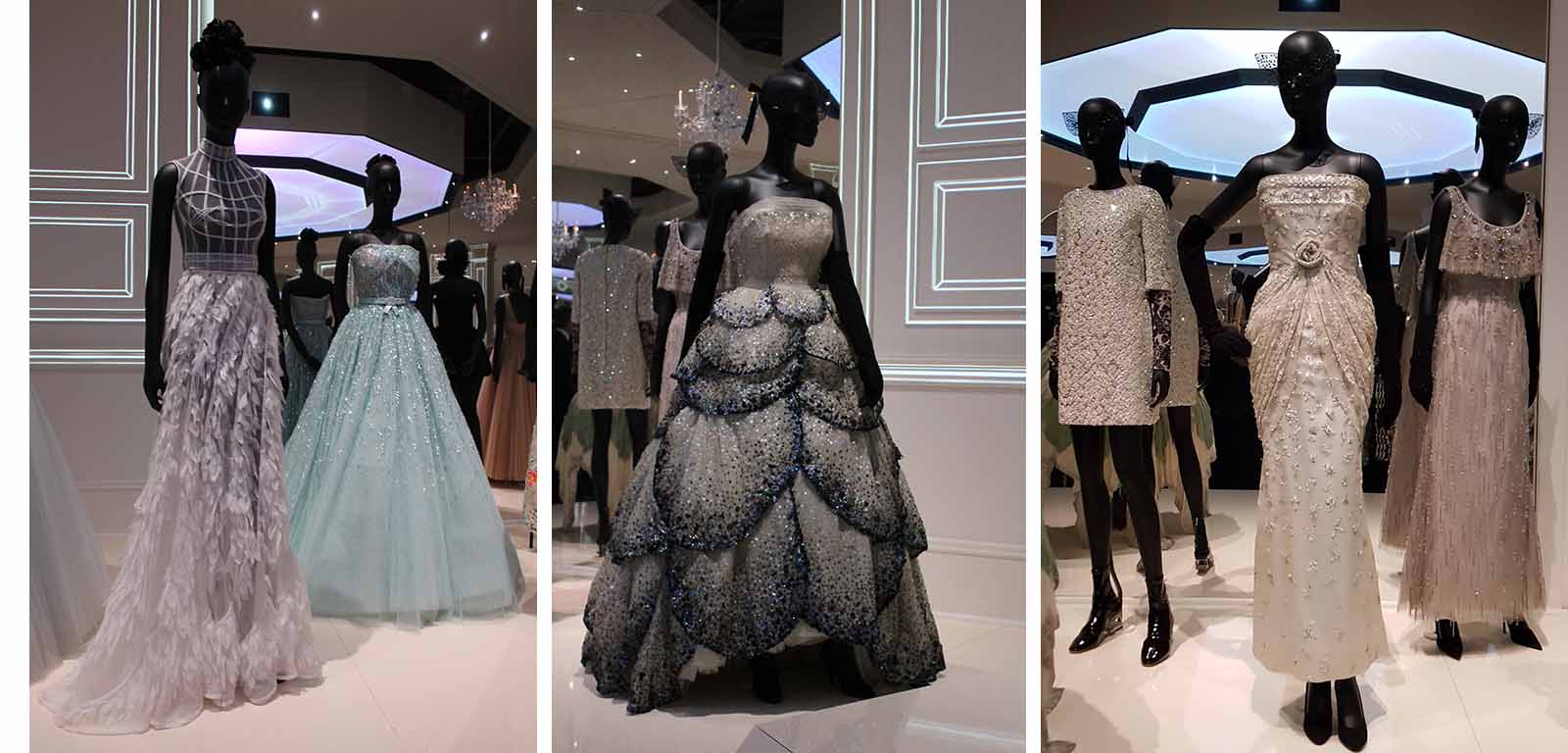
The dresses shown in the ball room cross a broad colour palette that often leans towards iced and metallic tones. There is regal, glamourous, demure and cool minimalism. Maximalism, as always in Haute Couture is there to be found in plenty. Many clients came and still come to Dior in their droves to create a fantasia dress or garment, something that may follow the seasons suggested styles as brought out or something completely different. What is interesting to me amongst the large number of dream Haute Couture pieces is that although trends and styles change with time, the majority of dress are between ankle and floor length. The long formal dress has a strong lasting appeal of it's own that doesn't diminish with the passing of time.
A sheer waterfall of feathers fall in alignment on a bias cut of a sheer skirt. A Baby Blue floor length dress banded at the waist with a slender belt makes the simplest fit and flare style of evening dress to be worn to a glittering event in high Summer. Again, like all of the dresses assembled, it isn't a piece from the current season but with it's simple cross over bodice and crystals scattered across the length of the fabric, it's a look that could be worn by clients across generations. Centre above a Silver dress composed of overlayered ovals bordered in Navy Blue takes on the appearance of fish scales. Perhaps a perfect dress for a mermaid going to a ball onshore. To the right a crystal encrusted mini dress glimmers underneath the lights before heading off to dance. This cut recalls the 1960's but it's a universally adaptable piece to give to clients. To the right a Silver-White dress with a lose overlaid bodice channels the 1920's with a look that clearly nods to the formal style of the 1920's whilst again managing to be a fitting look for clients aged 19 to 95. Front and centre in this image is one of the gems of the whole exhibition in my opinion. A Silver-White dress with a rose flower created from the textile of the gown sewn into the bodice is pure Haute Couture. Heavily beaded this look bodice is defined to perfection with linear streams of crystals reaching up from the hips to the heart core of the central sternum. The Rose appears hear at the spiritual centre of the woman's figure showing the natural perfect alignment of the female form and will adapt to styling on different shapes of figure. It's an ode to women and a pure joy to see.
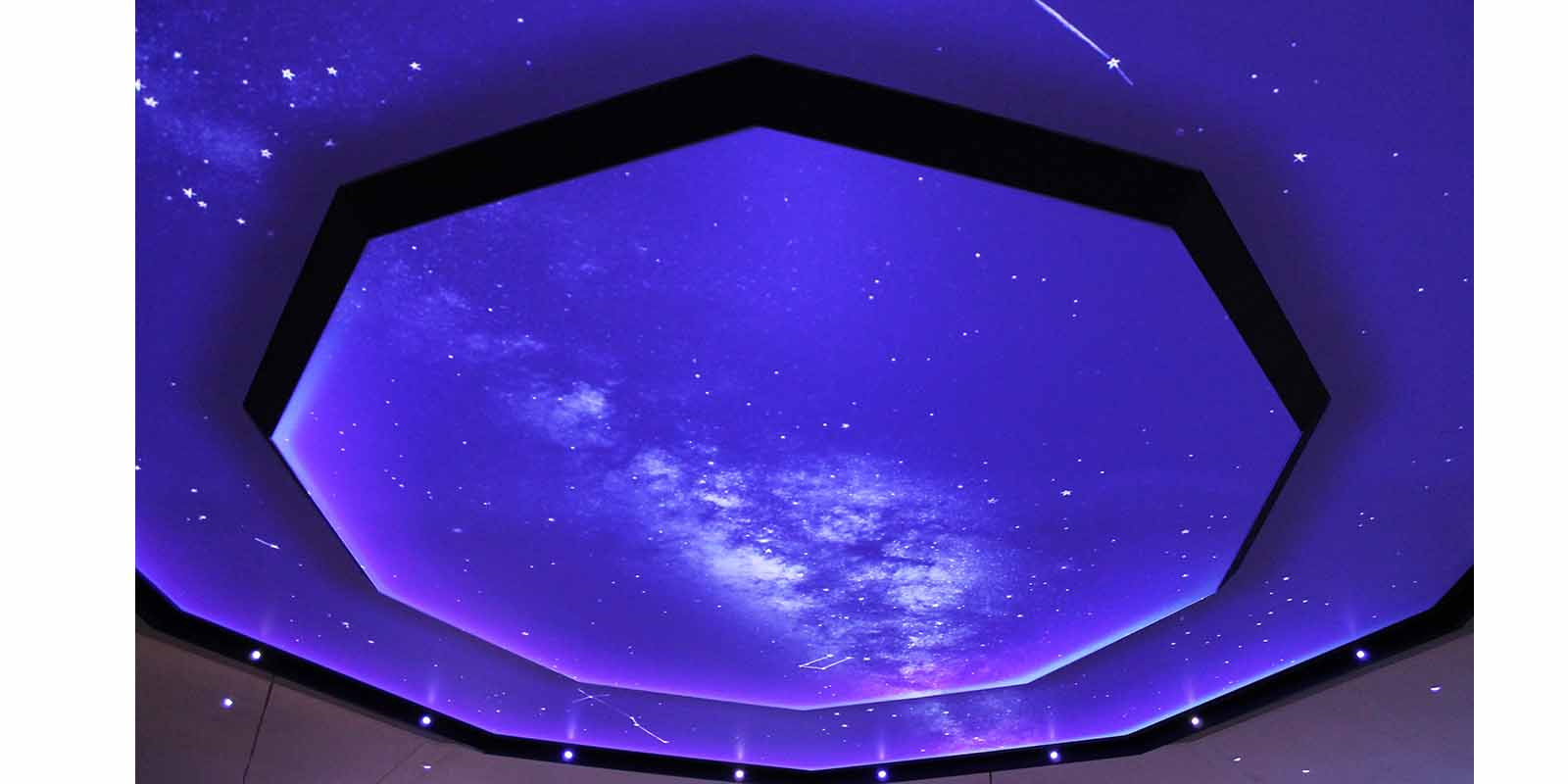
So then night descends. A thousand stars swirl above the dresses that have danced through many parties around the world. This sounds quite romantic but honestly, when I look at Haute Couture I wonder where the pieces have been, what they've seen, how their wearers felt. These dresses have lives and some of them could speak volumes. Again looking up at the stars reminded me of the ancient world and the fascination that it held for the denizens of the 18th century in Paris, London, Rome and beyond, the era that Dior and many of his contemporaries themselves looked back to when looking for style and signs of meaning from the past.
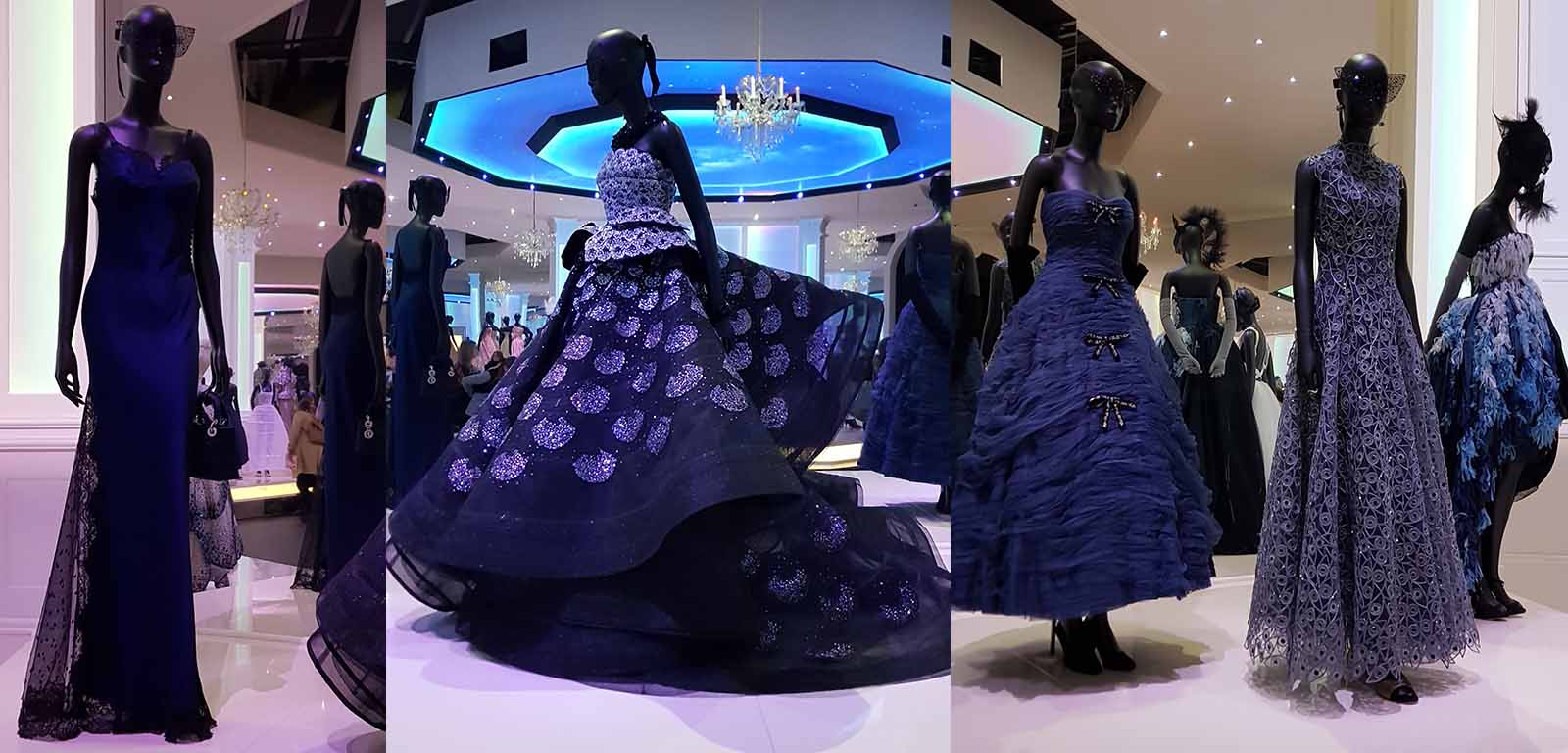
Midnight Blue, one of my most favourite colour palette choices and a universally flattering tone, forms a perfect series of looks. From left to right above five dresses offer very different styling options for clients and a feast for admirers of Haute Couture. Firstly to the left above one of the most beautiful slip dress designs that will ever be seen on any red carpet or catwalk. The whisper thin silk bordered in Black lace at the neckline and with a sheer thigh high split makes an instant design classic. Seeing this piece in person, in a tiny sample size 6-8 in UK sizes the astonishing proportions of tiny waist, hips and height add to the glamazon wow factor. Complete with a Miss Dior purse that looks as though it could have been created specifically for the wearer, it's a piece that would enchant it's audience.
Centre above wheels upon wheels of fabric encircle the wearer with Silver sewn discs overlaid in fish-scale like form encircling the wearer at the bodice above a skirt of semi-sheer gazar silk embroidered with similar shapes. The movement of this piece when worn is pretty remarkable and again, as with all haute couture, it's lightly made garment that appears to float around the wearer. To the right Midnight Blue tulle is ruched to perfection following a style shown on a doll in the preceding room. Sewn with four jewel embroidered bows running down the front of the dress, it has a look of simple uniformity that speaks to the codes of easy elegance. To it's right a laser cut embroidered dress recalls the eyes of the peacock feather and it's slightly uneven hemline enhances the mood of playing with conformity. A festoon of feathers rippling across the length of a dress from Ice Blue to deepest Midnight also channels a spirit for play and adventure.
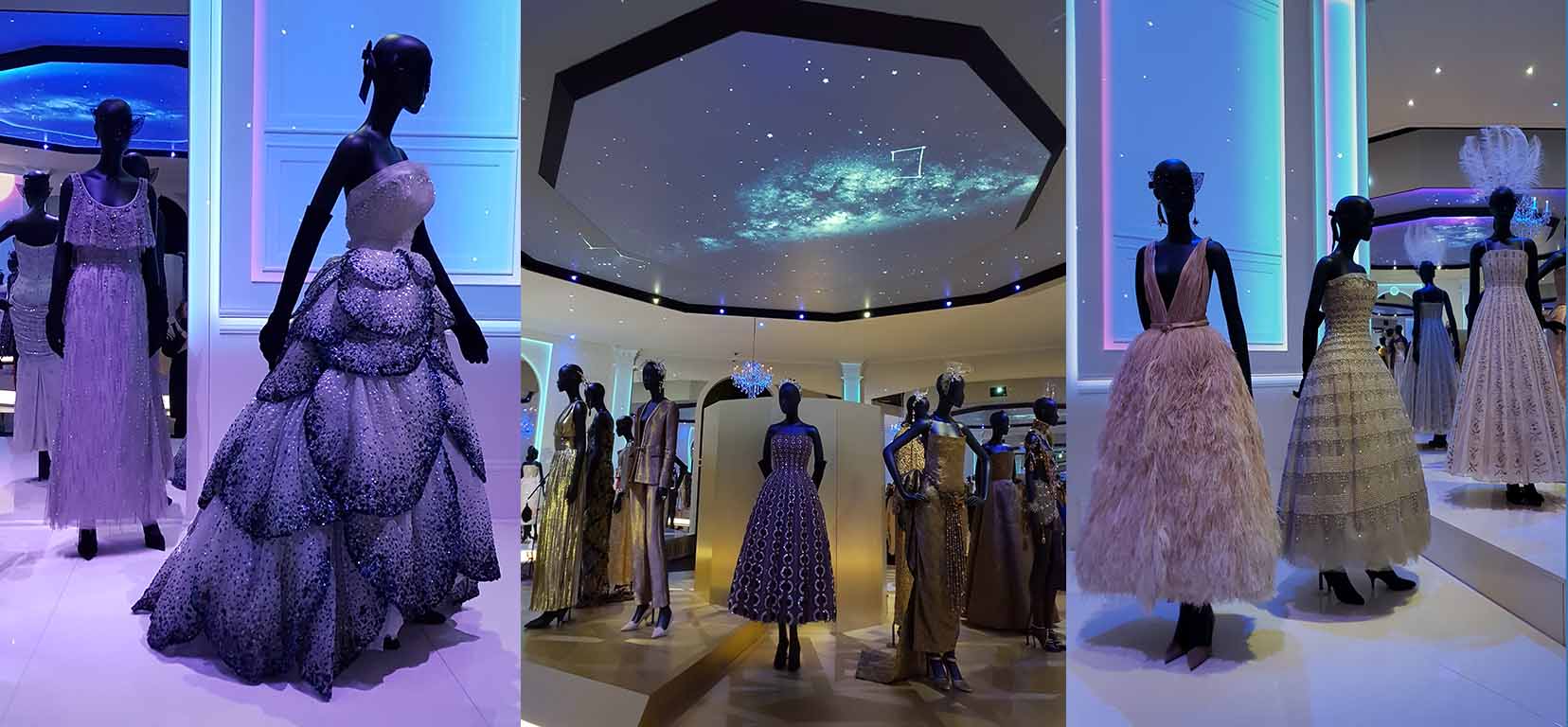
What is fascinating about the collection of dresses assembled is that when the tones of light change, the dresses themselves appear to change in colour also. In the twilight they appear to take on an ethereal feel themselves and here, a number of dresses shown above appear to take on a different identity under the Blue haze of Dior's night sky. It's magical but also very real as these creations have been cherished by clients across the world. Centre above a series of dresses from the central round of the room stand beneath the cosmos drawing shapes from mythology across the night sky. Golden glittering stars fall to earth in a heavenly shower and the room is bathed with a magical shimmer of light as the first hints of rays peak at the edges of the night sky. That ancient moment when the world turns and a new day begins.
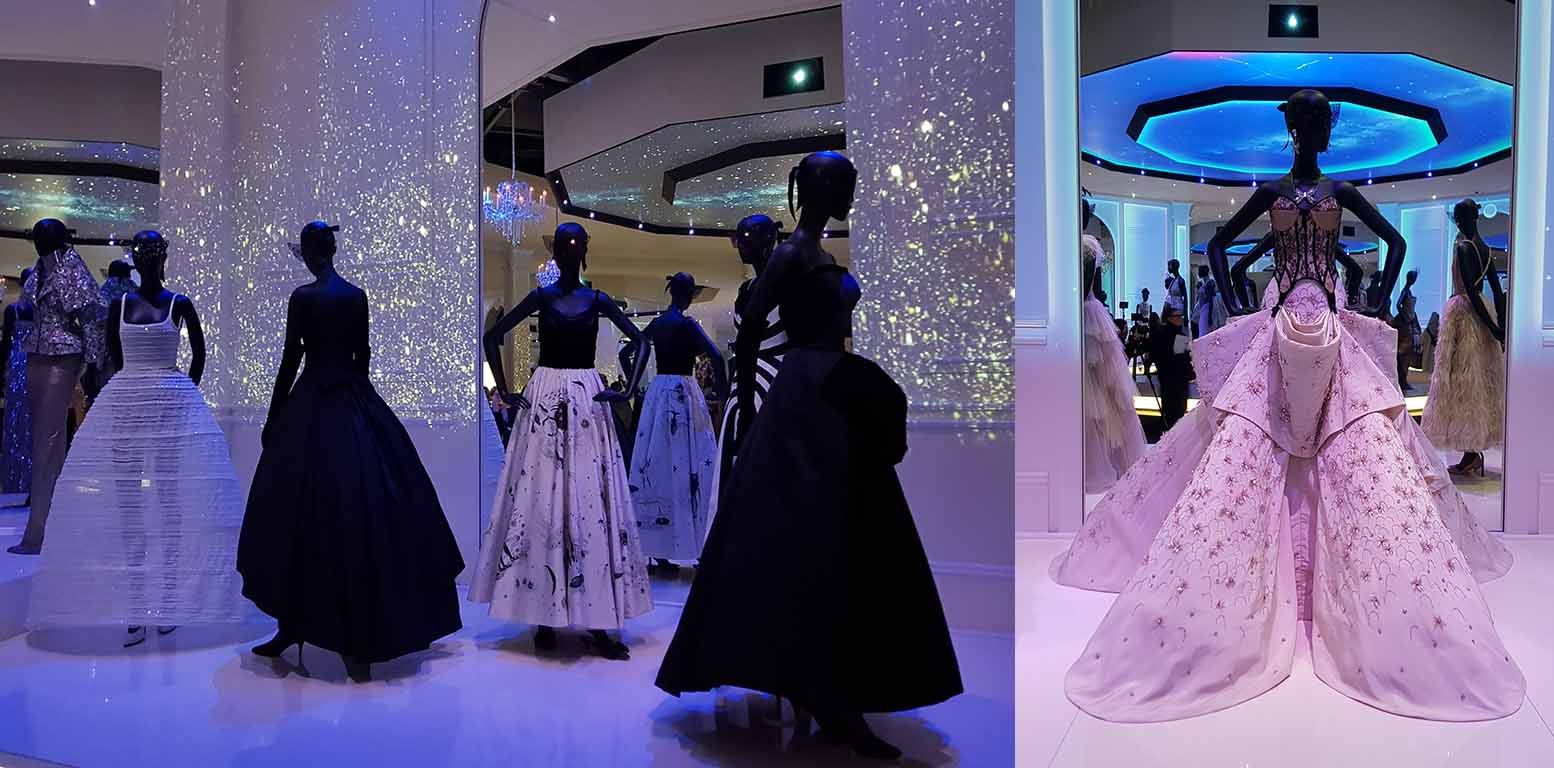
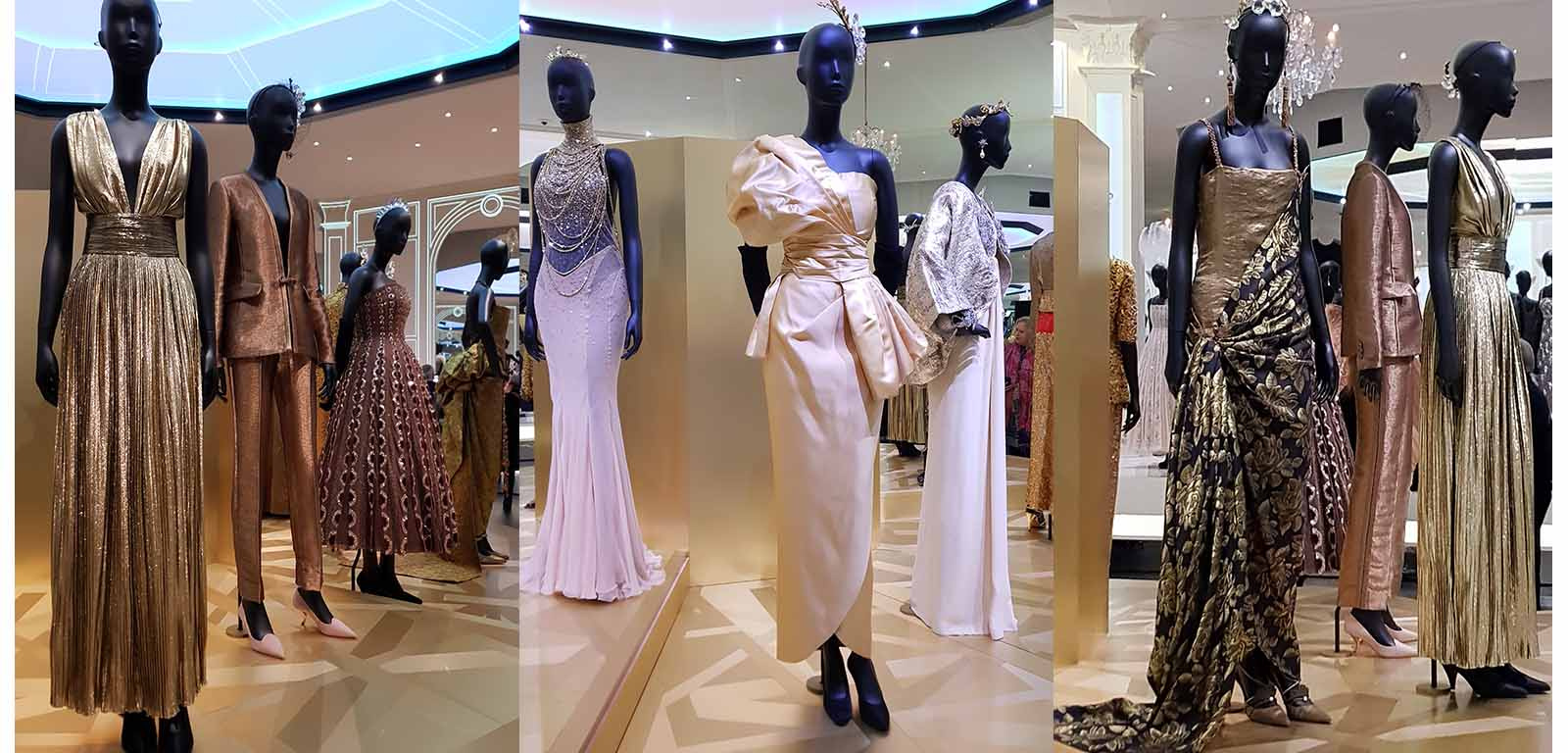
The inky Midnight Blue gives way to the burst of the aurora of Golden hour of dawn. Gold moves through the Ballroom and in the glow of it's pure light the metallic dresses of the centre round are brought to life. The dresses and suits above are all strong statement pieces from the Dior armory. A tunic dress in resplendent Gold gently enhances the curves of the figure with a central broad waistband and the finest pin-tuck pleats increase the volume around the wearer as she walks. A Bronze Suit also catches the rays of light in the room and would make a perfect outfit to wear around sunset for drinks parties. The joy of draping is barely concealed anywhere in this collection and the Cream satin dress with a flourish crossing the shoulders produced from a wide wrapped belt. The main body of the dress itself is composed of Cream silk wrapped around the figure like a petal. An intricate Golden thread embroidered flower bed weaves across the surface of a dual layered dress. With a slip under-layer of Golden silk combined with matching shoes, it's a twist on the conventional Black tie form that would have greatly enhanced the collection of the owner.
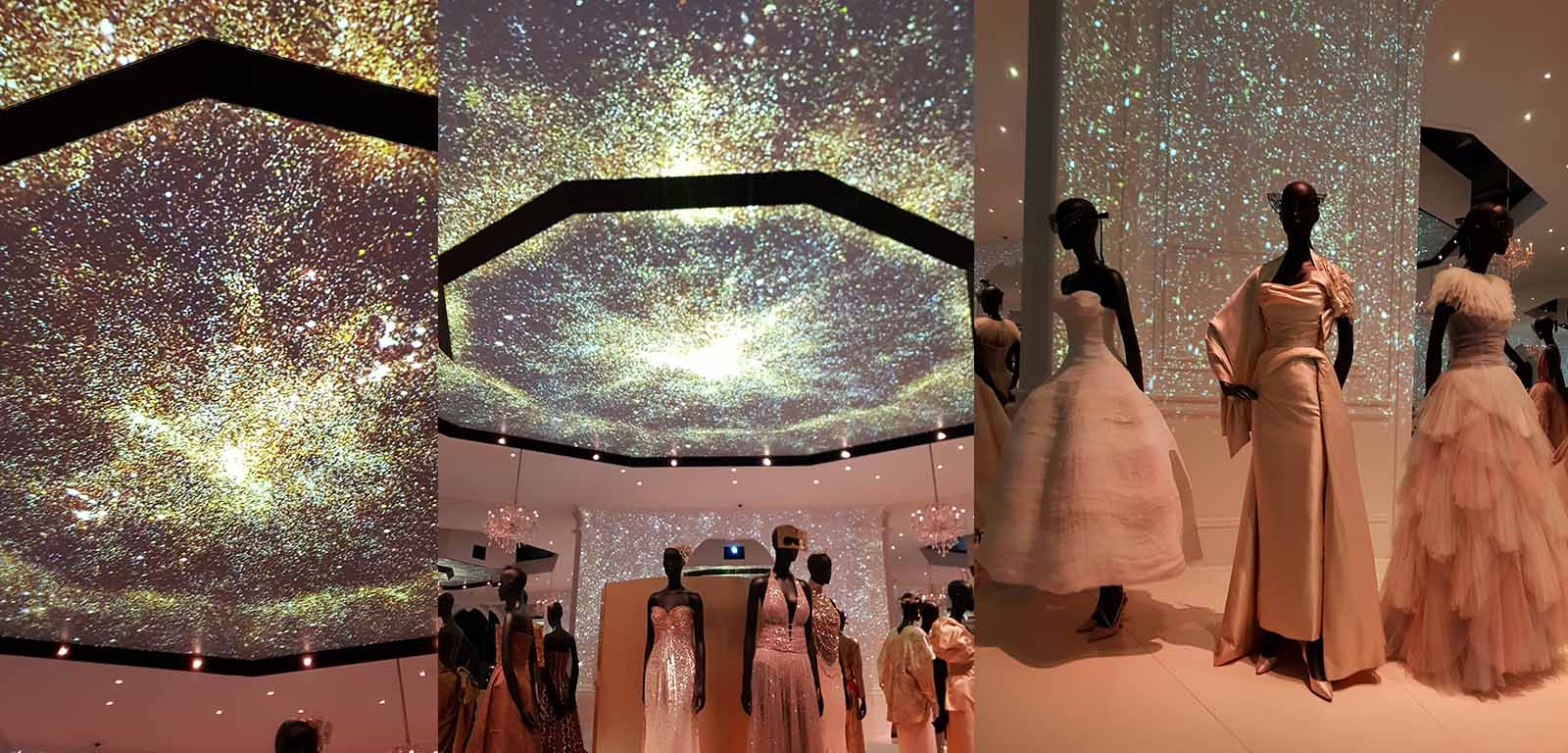
Radiant shimmers lit up the night sky as light slowly returned to the room. As the light came up it breathed a warm life into the garments decked around the Ballroom. They looked like they where waiting, to see a familiar face and have a conversation or deigning to dance after surveying the room. The fish scale like layering is something that appeared through several looks and can be seen again to the far right here. As I watched the sequence of night following day through several cycles, I was mesmerised time and again by the ability of the dresses to change their appearance of colour depending on the light in the room. I had no idea that this optical dimension could produce such as striking filter in the fabric.
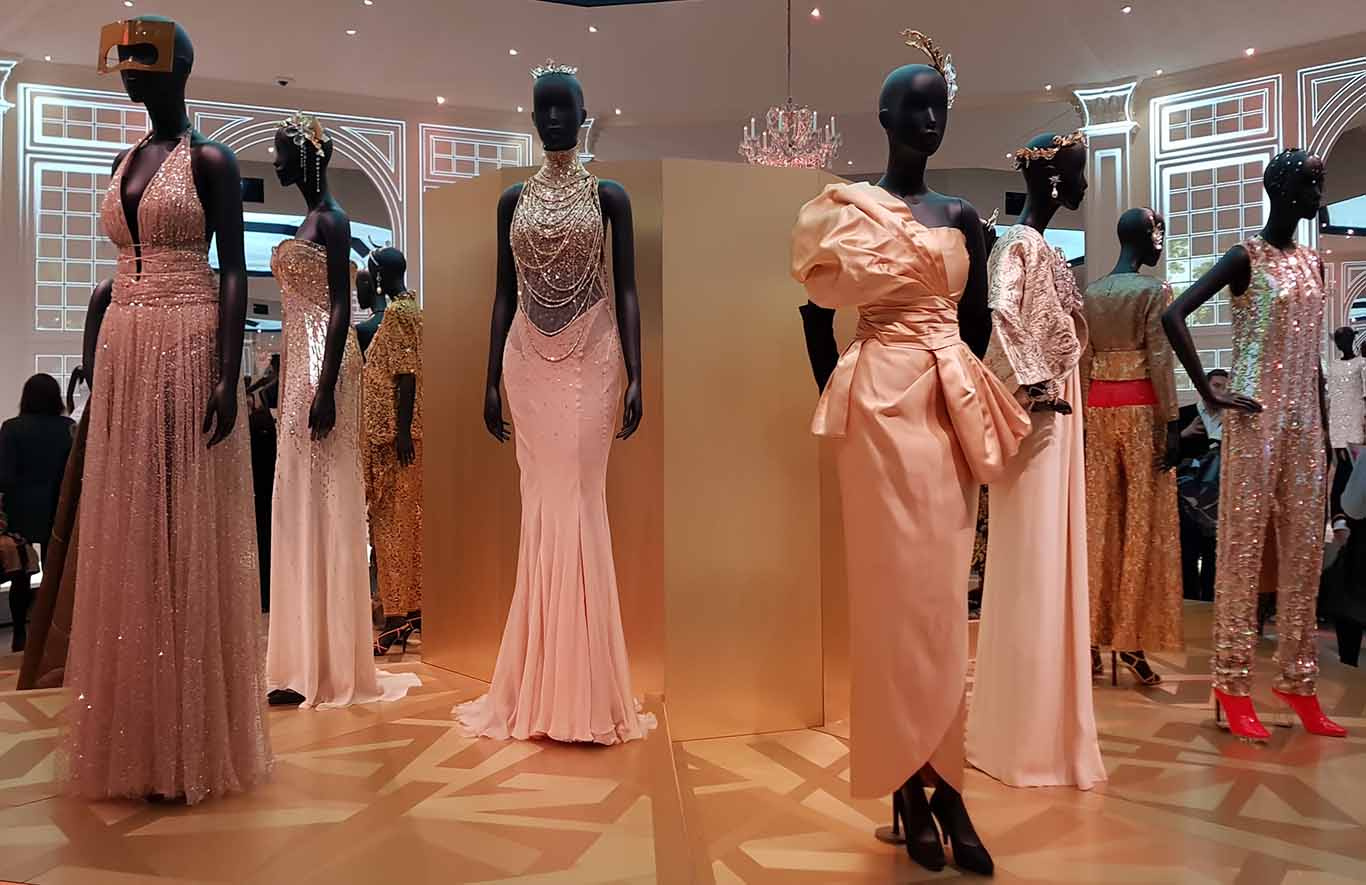
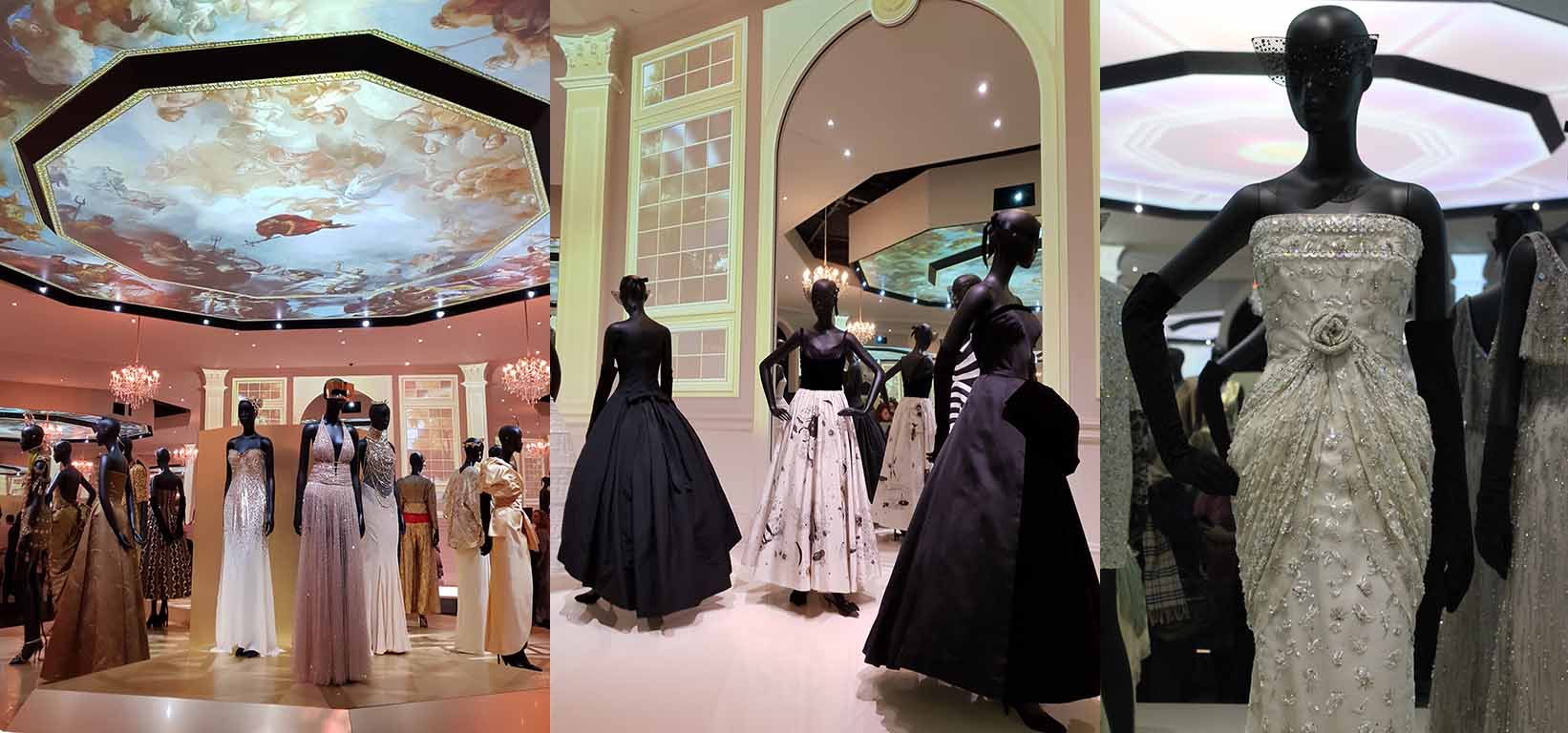
The collection closed with an incredible dress from the Dior archive that was amplified in the most profound way by the alignment of infinity mirrors. A winged tissue thin dress cape was itself echoed in the paper light Dior fan held by the model and the name of the House of Dior rippled across the fabric in a literal display of the designer's collection. The Blush tone accentuates a healthy natural complexion of any wearer and tonight somewhere in the world, as on every night, someone will be wearing Dior Haute Couture to create their own fashion history. I think he was a businessman, a shrewd self-marketer, trained as an architect who grew up around the haute Bourgeois who frequented Parisian ateliers but; he did give women something that lasted and he was adored.
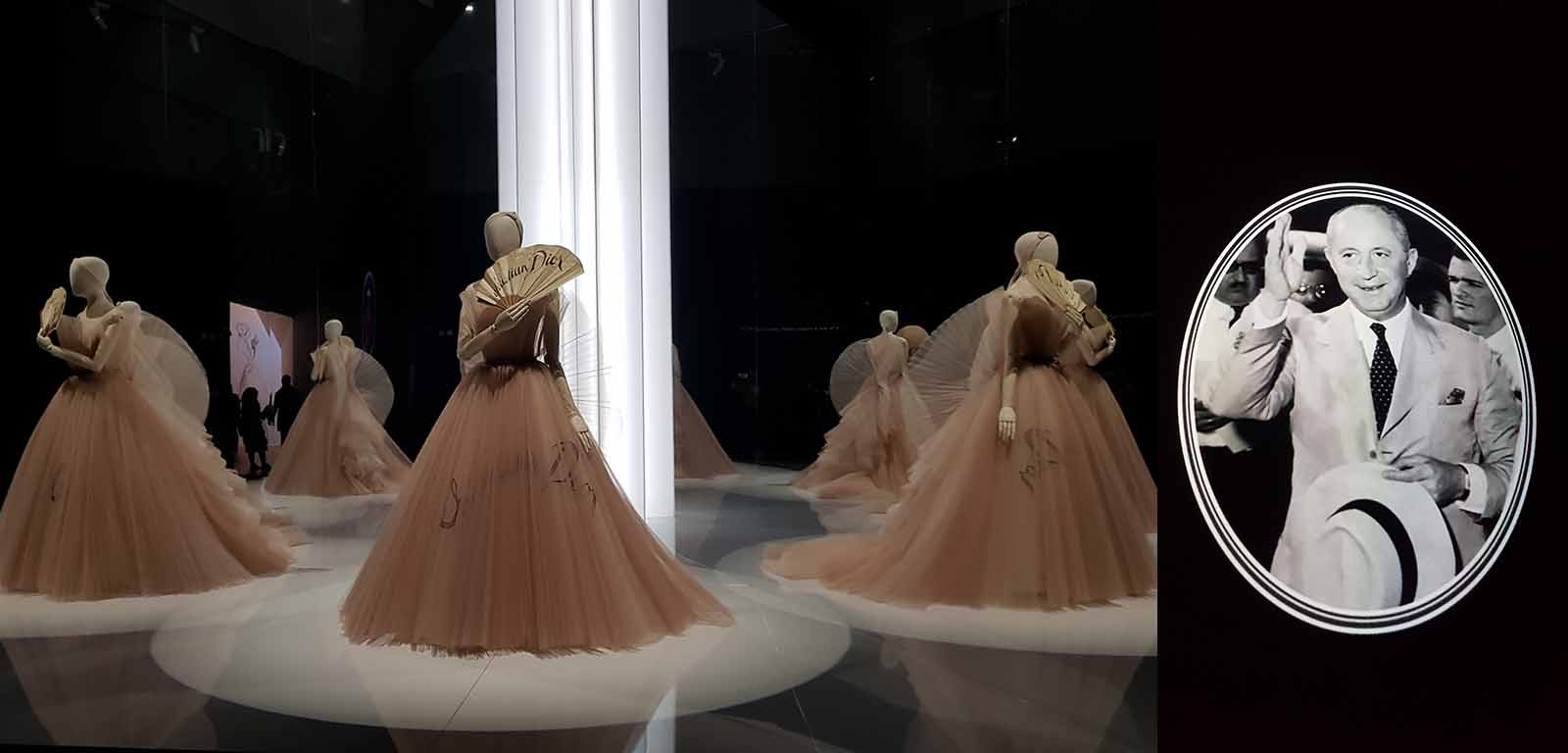
A visit to a V&A fashion exhibition wouldn't be complete without a choice selection of treats and I think the canvas grab bags (priced from £5 to £20) and the coffee table books where amongst the most interesting and good value I've seen.
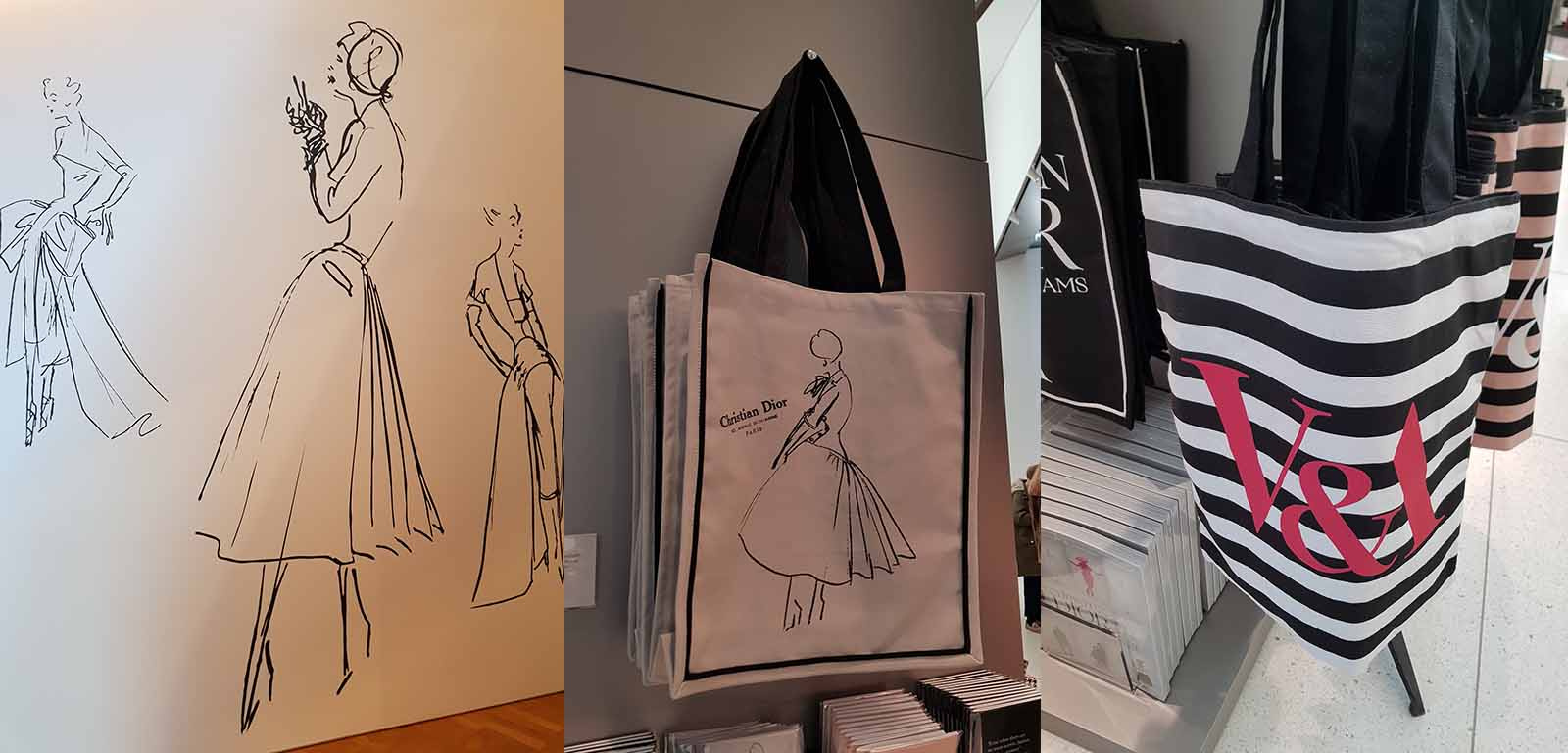
Russia and it's Tsars visit Buckingham Palace
After several centuries of groundbreaking frontier diplomacy the British Royal family eventually became very close their Russian counterparts in the second family to rule the Russia's. Complex and multiple family ties wove the two Houses together and formed bonds of friendship that lasted across lifetimes.
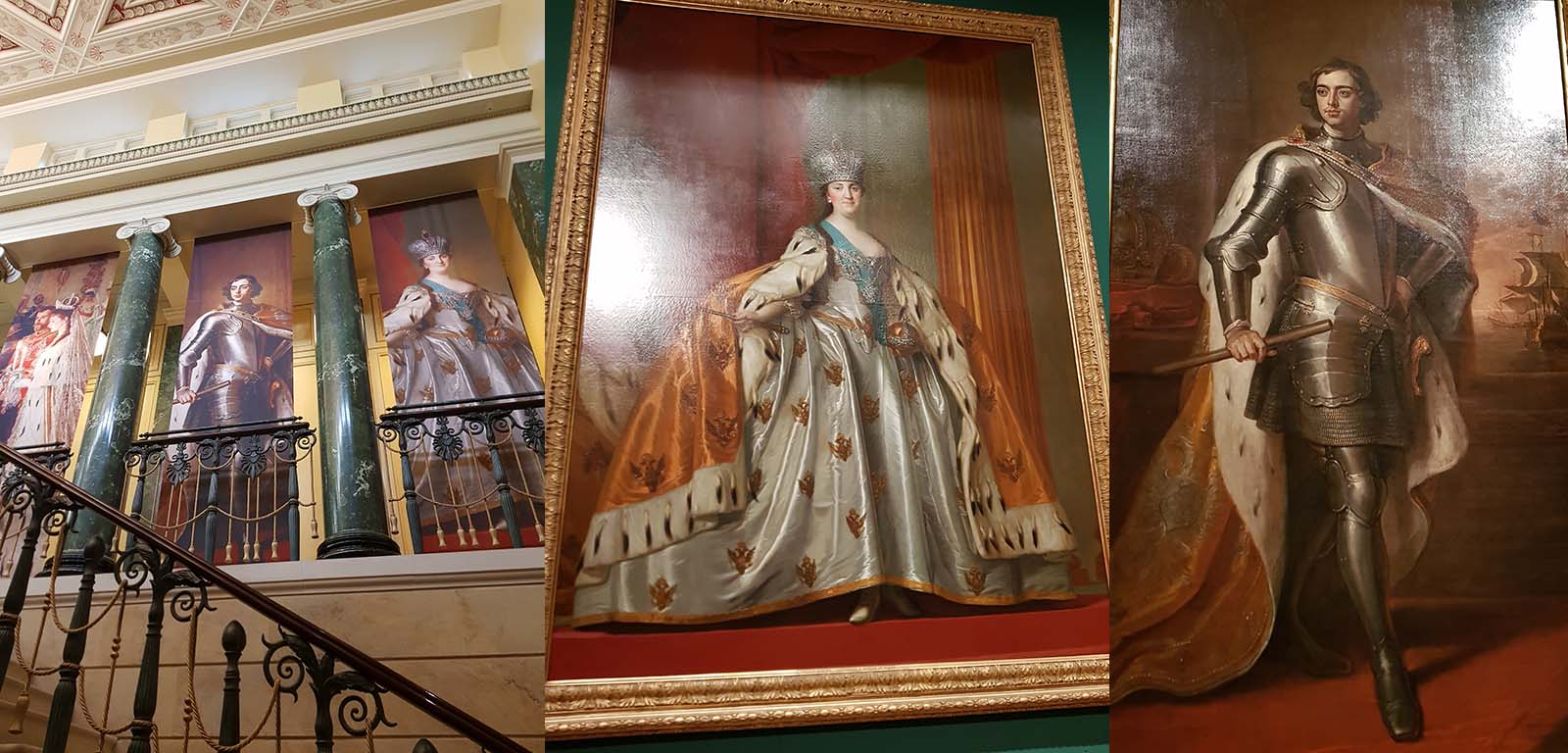
In the entrance halls of the Queens Gallery visitors where greeted with banners of some of the most recognisable members of the Russian Royal family across the 300 year reign of the Romanov family. Two figures who loom large are aptly placed at the start of the ascent, Catherine the Great and and Peter the Great. Greatness itself is something that Russia and it's vastness promises in the imagination and for Catherine and Peter, they both seemed to embody this in larger than life personalities that where determined to make a large lasting impression and change through their own country and beyond.
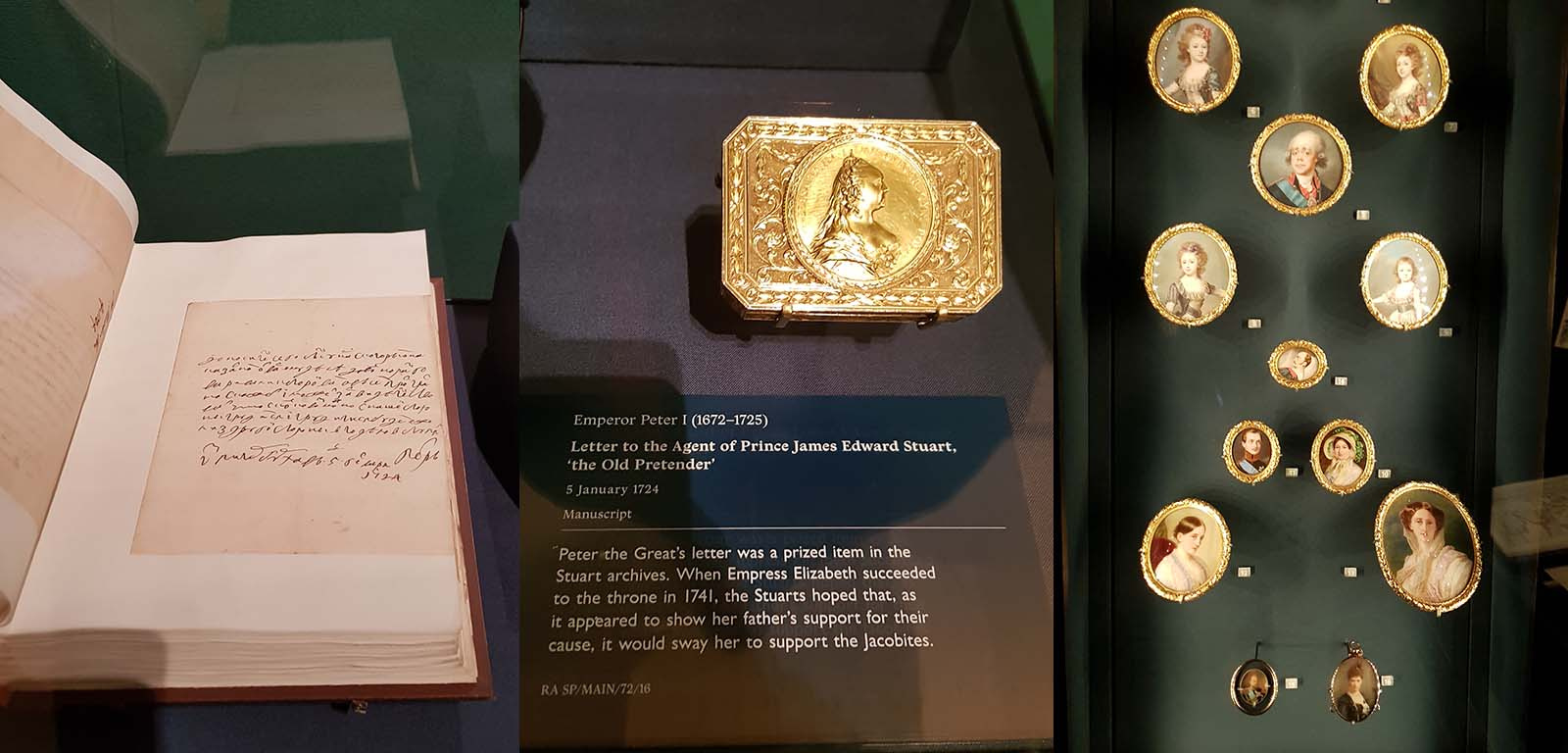
Royal friendships have been important since very ancient times and help to seal the bonds of understanding and trade across countries and continents. This is true of both reigning and non-reigning families and none were more ameniable and respected than the exiled Stuart cousins of the British Royal family. Living a pared-down life in Europe spending their days patronising artists and famous musicians in their early careers, such as Handel before he came to England, they hoped to maintain the friendship and understanding of other European families. Above, a letter from Peter the Great to the exiled Stuarts was a prized part of their collection of papers. Imagery and representation where just as important as today and instead of social media and camera film, miniature portraits and very special jewels carrying a likeness of a Royal person where one of the most treasured gifts that another Head of State could receive. For the Stuarts in exile and their descendants and supporters images where very important to keep hopes alive. In a time when long distance travel was rarer and difficult, these images would be kept safe and looked at from time to time, perhaps when people wrote to the subject of the picture when thinking of them.
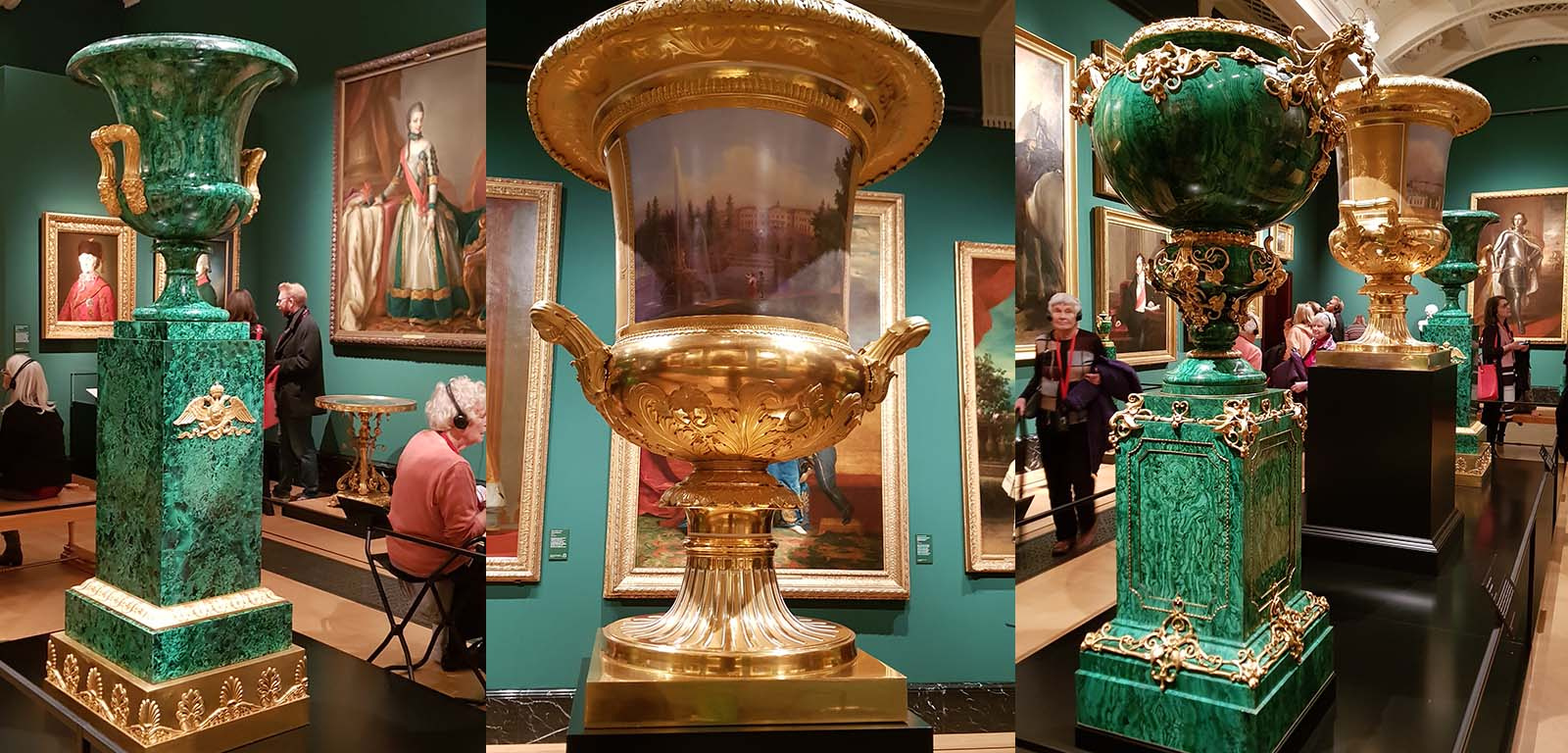
Hoping to keep up, if not surpass, the Royal neighbours across Europe, a competitive streak meant that the Empress Elizabeth wanted to produce porcelain just like her counterparts in the west and later male descendants enlarged and expanded the operations of Russian porcelain factories. The Green of these two large vases is extraordinarily vivid to look at. It has a radiant luminous light of it's own and the signature style of classical antiquity looks as fresh and crisp as if the pieces were carved and guilded in recent days. Centre above, one of the most famous vases of the collection gifted to Queen Victoria. The Imperial presentation vase was a diplomatic gift from Tsar Nicholas I to Queen Victoria. Paintings that illustrate the Royal homes Tsarkoe Selo and the Peterhof Palace wrap around the central body of the vase hand painted by Nikolai Kornilov highlight the advanced technique of the Russian artisans renown across the world.
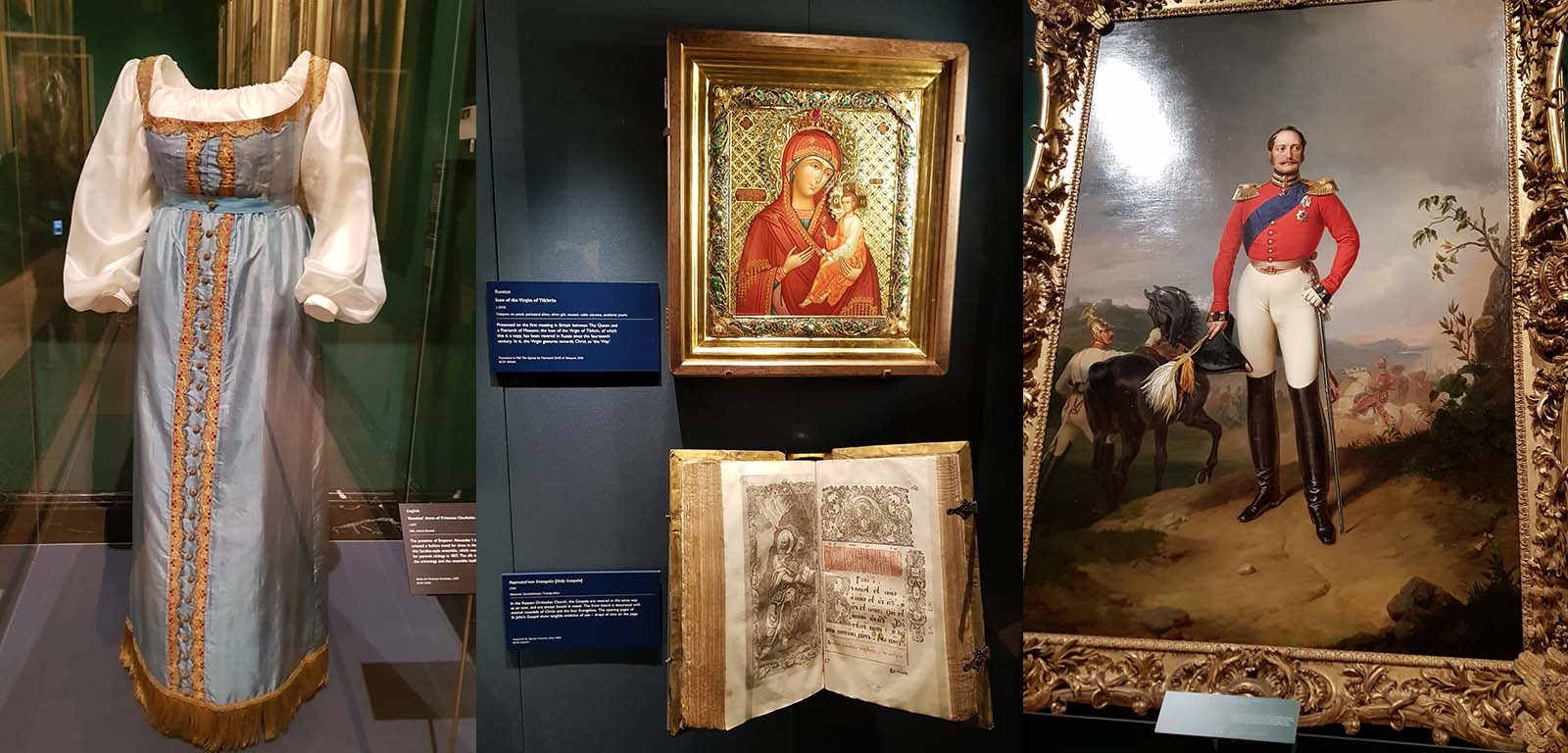
When Tsar Alexander I came to the United Kingdom in 1814 he generated a fascination for all things Russian in Regency era society. Above to the left is a dress that was designed for Princess Charlotte the daughter of the Prince Regent who was expected to become the Queen one day and be the next head of the Hanover family in the UK. Sadly she died at the birth of her own child as many women at the time did but this princess who is little known today was obviously keen to adopt the styles of the time. I was astounded by seeing this dress in the cabinet that looked as fresh as the day it was created. This garment was designed with simple attire, not high court style in mind. The lives of people stretching across the vast Russian lands into Asia fascinated the Regency mind. The proportions and length seemed to match me, a person of average height today so she must not have been very small as we sometimes think people from the past where. The silk of the blouse still looks freshly woven and the cornflower Blue and Gold thread make a perfect combination. What was striking also to me was how comfortable this outfit looks compared to later tightly corsetted garments of the mid-nineteenth century.
Space was given through the exhibition to showing religious icons and books that demonstrate the power and importance that the church had in the minds of Russian people across many generations. The richly guilded icons contrasting with the very humble circumstances of the people living across the country. To the right a painting of Tsar Nicholas I in British uniform and wearing a badge of the order of the Garter is actually a smaller copy of an original painting created in the same year, 1848 in Russia and send to London in 1850. It was produced by an enameler and painter William Corden who was commissioned often by the Queen including being sent abroad to Coburg to produce family portraits as well as producing copies from the Royal collection to give as gifts.
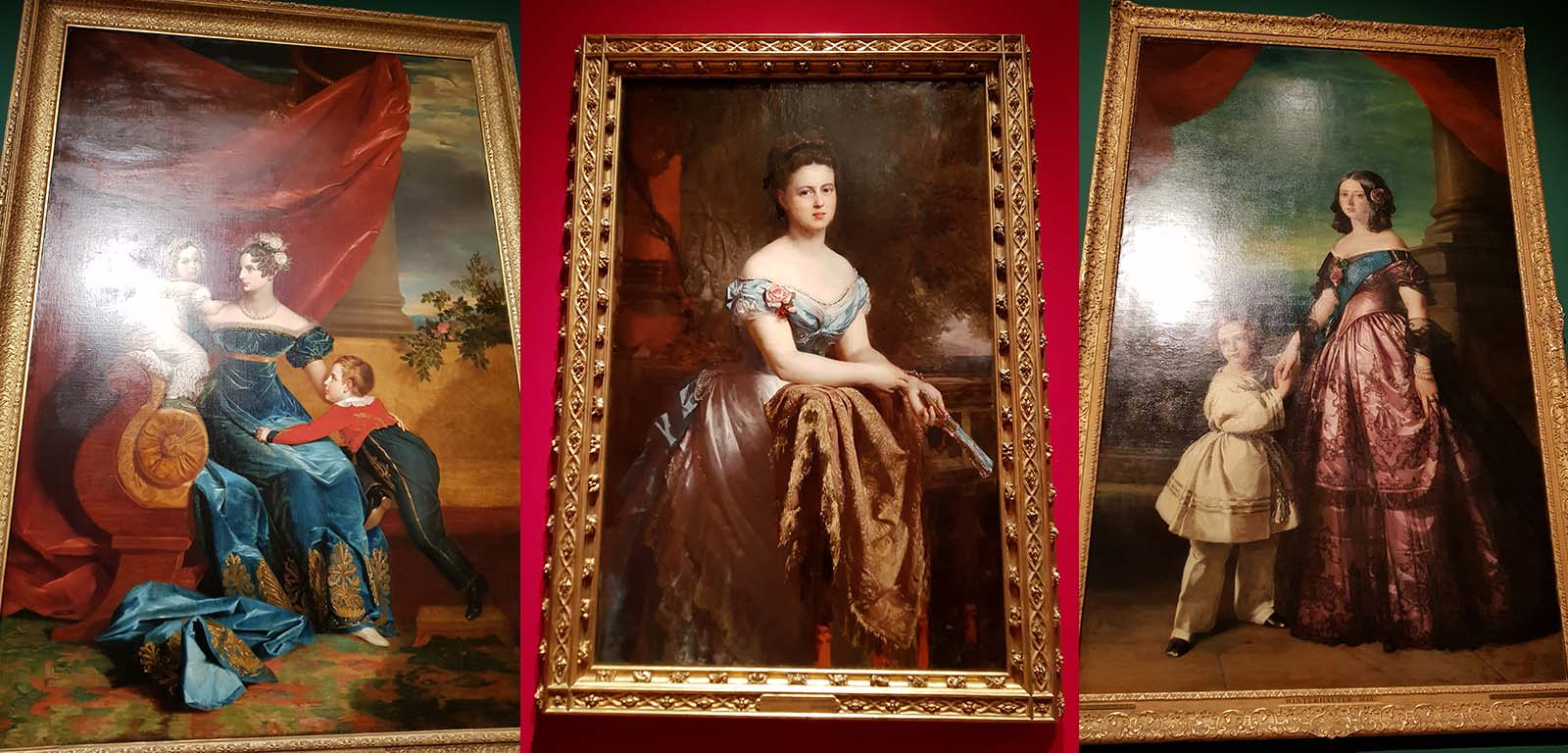
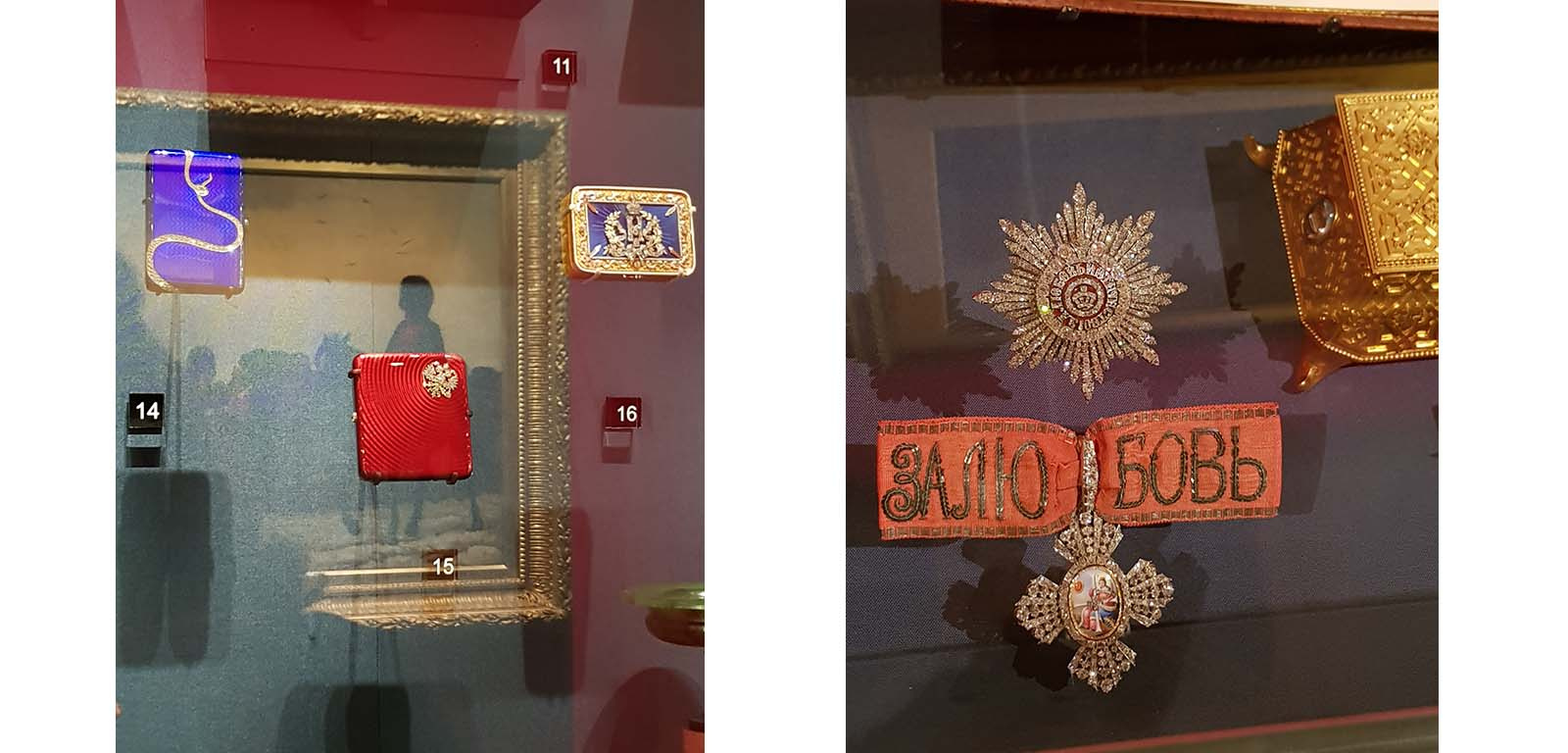
Above, slightly standing apart from other things some exceptional objects. Easy to recognise for many, these Faberge cases to the left above show the excellence of enamel work brought from France to Russia by the Faberge family and taken to a new level of creative expertise. The brilliant colours set with diamonds will always captivate people for centuries to come. To the right, two orders of insignia worn by members of the Russian court sparkle with diamonds in an astonishing display of wealth. These show the sheer vast scale of access to jewels that the Imperial family and their courtiers had and expression of preciousness that they wanted to illustrate through using them in design.
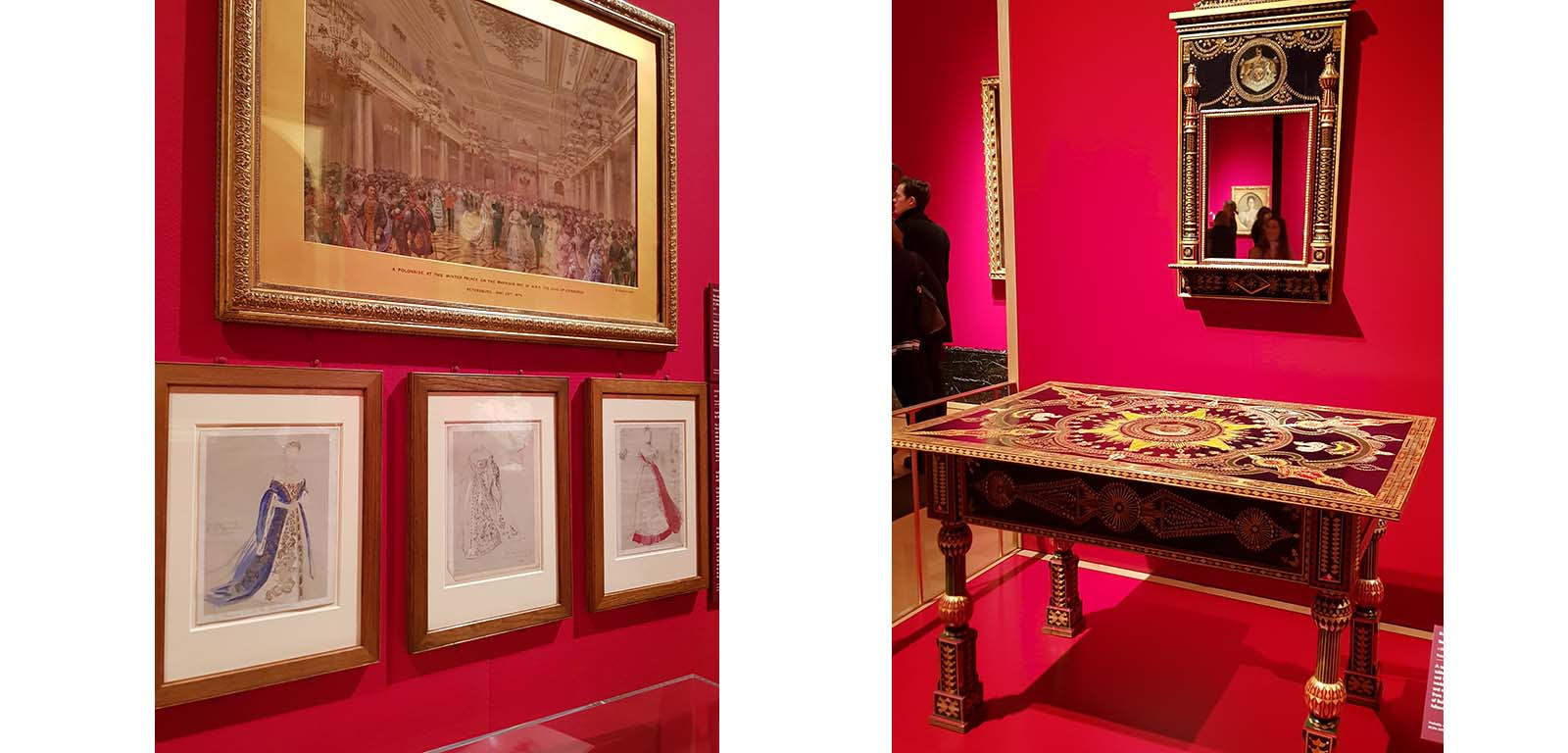
Life at the Imperial Court is difficult to imagine compared to life to today. In many ways it would have followed the patterns of past centuries with diplomatic and governmental work running alongside seasons of balls and banquets in the evenings. These would also have a political and diplomatic function aside from all the finery and jewels, many serious conversations and meetings happened. Also key to life in the Russian court, as with other Royal families, was celebrating milestones of members of this vast family including engagements, marriages and court presentations. The Royal court spawned industry from highly skilled craftsmanship, covering furniture making and jewellery to, an area that is less often spoken about, Russian-made haute couture. I believe that the Romanov women and countless hundreds, if not thousands of courtiers, would have bought some clothes from Paris but many garments where produced in Russia and the Romanov's where one of the few Royal dynasties that incorporated emblems of traditional national dress, dating from the medieval era, into high court fashion into the twentieth century.
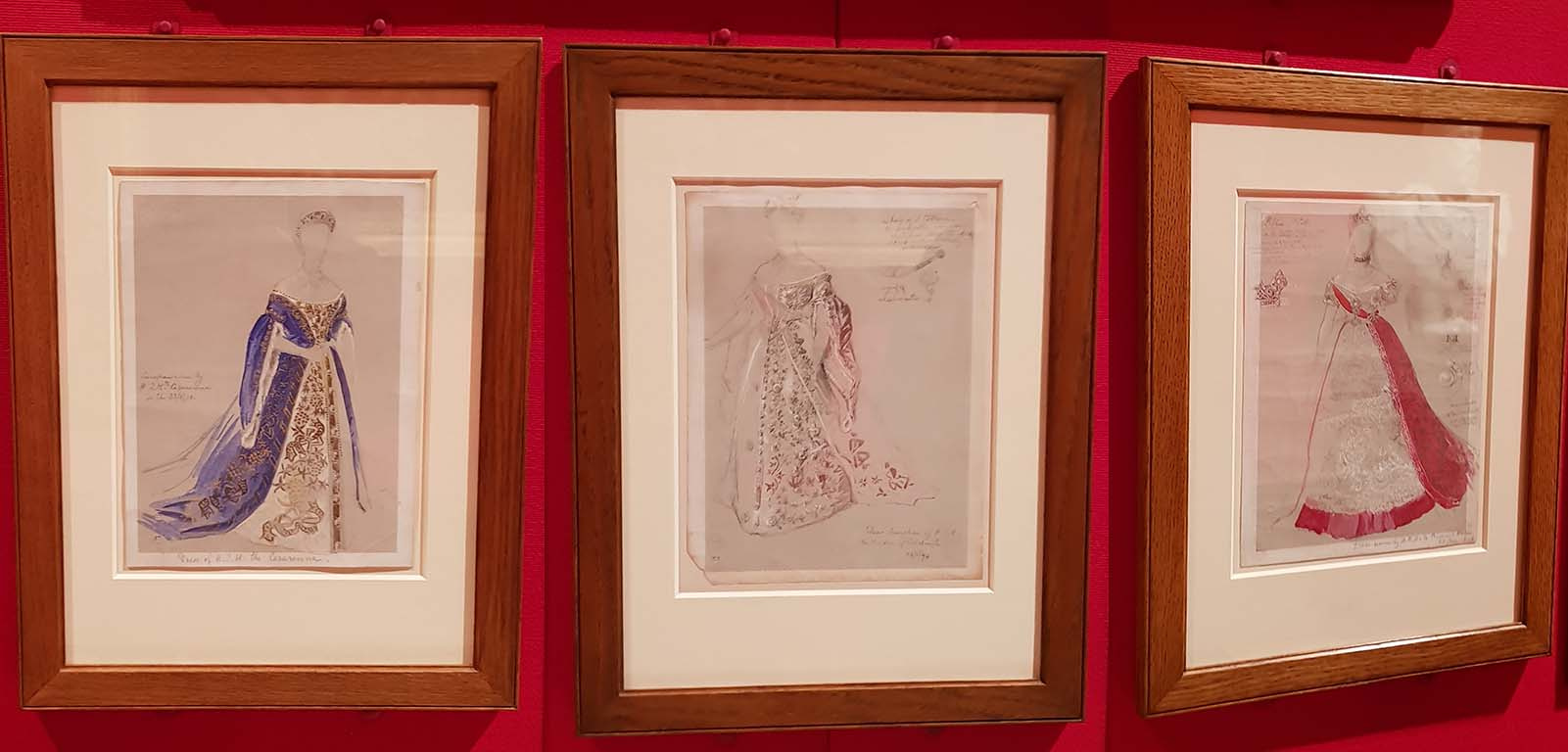
One of my favourite things in fashion is to look at the gouches of garments. These beautiful delicate illustrations show a link between the hand of the designer and their thought process. These illustrations would often be shown to clients for their approval, or in the case of some ladies of the Imperial family, it may have been senior ladies in waiting who knew the clients taste that would be able to give the go-ahead for a piece. Although these are meant to be casual sketches, I think they are a beautiful art form in their own right and worthy of being collectors items.
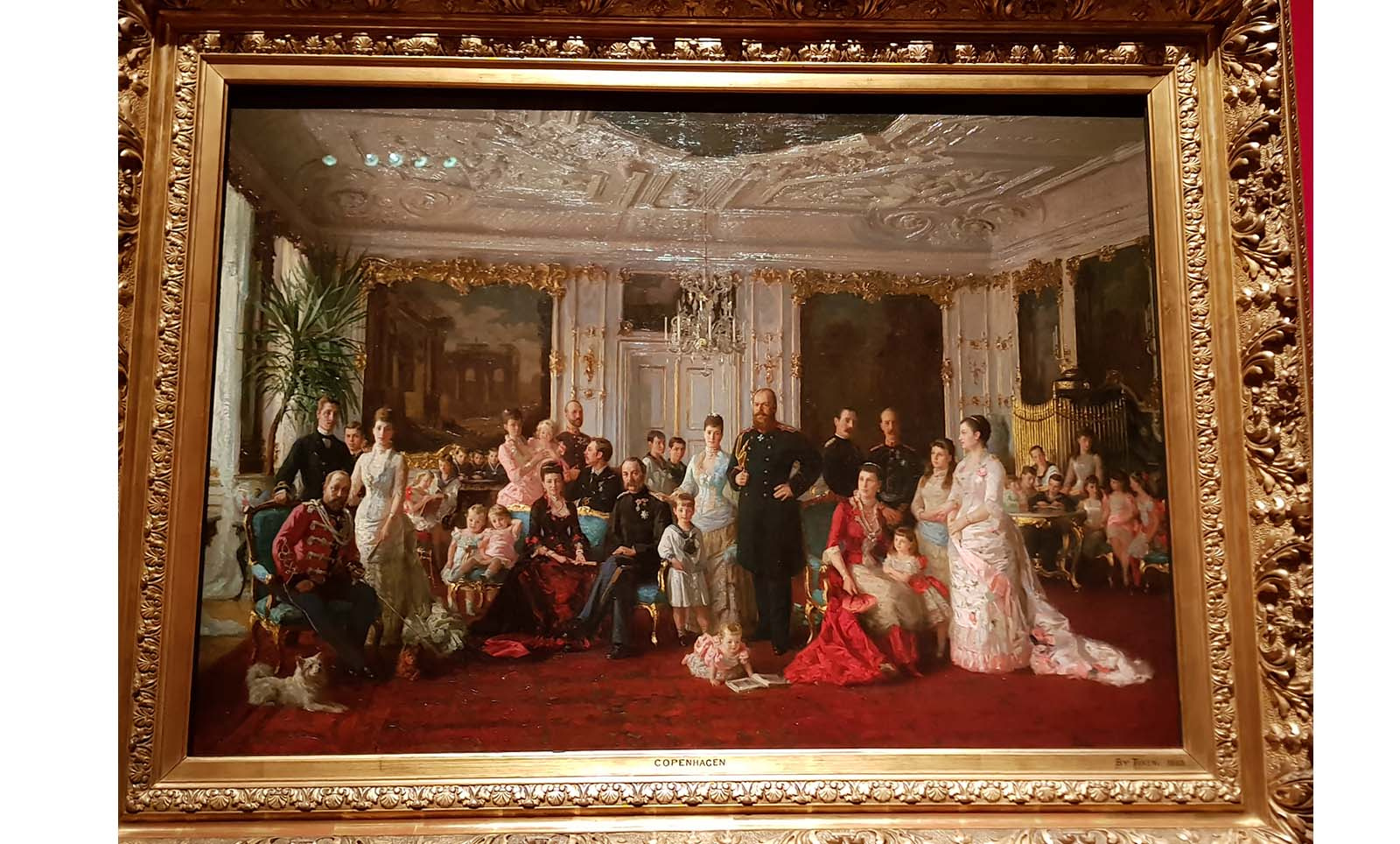
Family and family ties were very important and by the late 19th century the Russian, Danish and British Royal families where all interrelated in marriage through numerous different ties beyond the most high profile of the sets of current and future reigning monarchs. Geographically Denmark provided a very handy place for people to 'meet in the middle' with the King and Queen of Denmark surrounded by many children and grandchildren. Being Royal meant you where travelling, very often to see relatives, keepping your languages in practise and witnessing the changes taking place in the countries across the world to keep up your intel' of what was going on politically. It may seem glamorous but living out a suitcase has it's own challenges. Looking at this painting, the vibrancy of the colours comes across and the huge numbers of children, probably all speaking to each other in different languages.
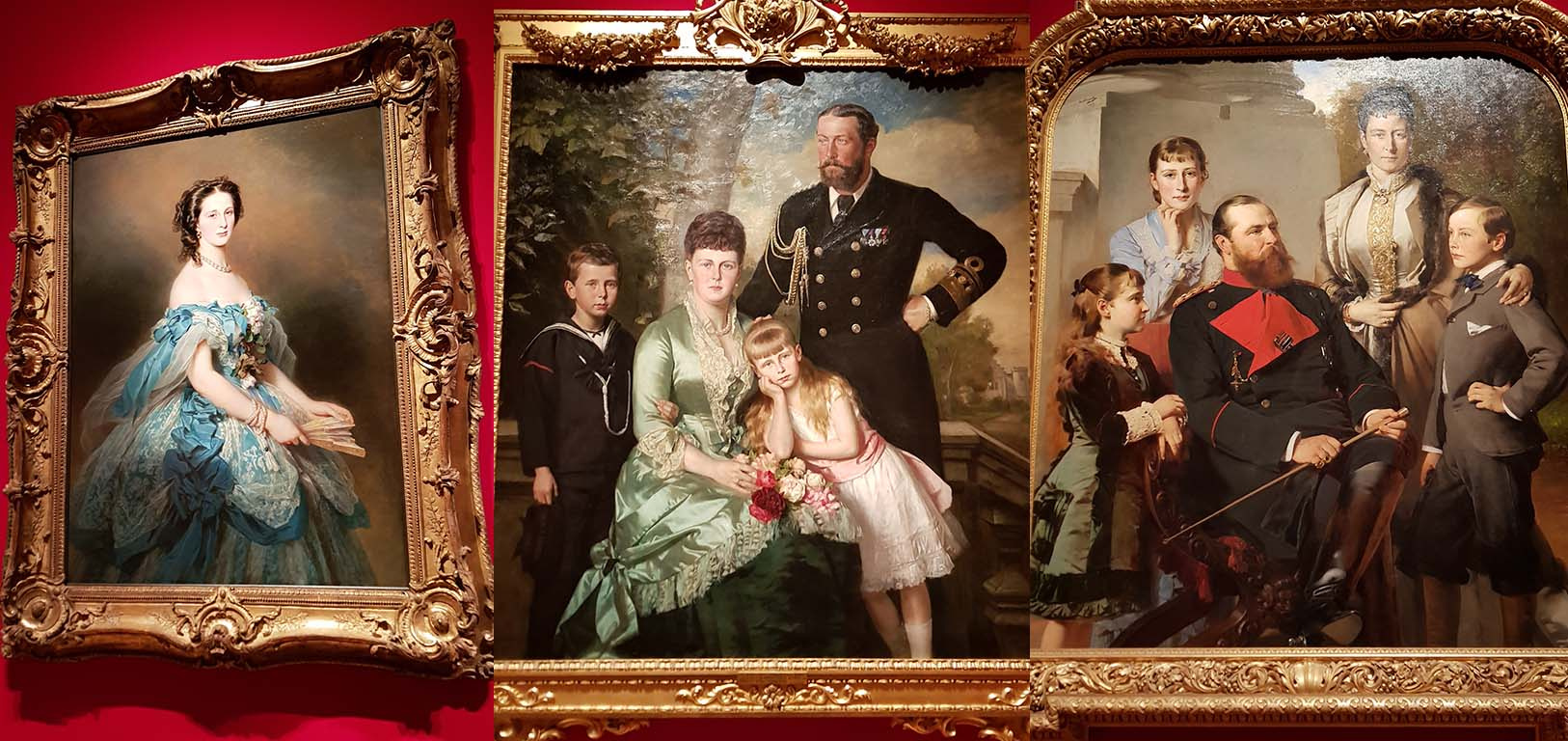
A large gallery was filled with family portraits of members if the extended British, Russian, German and Danish Royal family, which was in a sense actually all one family just living in different countries. I think it's easier to see it that way and three to four centirues after intrepid fur traders and emmisaries had made their way to London on behalf of the Tsar of Muscovy, the family web highlighted how Russia had arrived firmly on the map of British travellers and merchants. Above to the left, one of my favourite paintings of the collection shows a German and Russian princess Alexandra Iosifovna in a beautiful light Blue dress who's daughter became the Queen of Greece in the mid-nineteeth century. She lived a long life and apparently knew Queen Elizabeth the Queen Mother in the early twentieth century. I love this blue colour and the detail in her dress. It would be a dream piece for a costume designer to recreate now for a film. Centre and right above two paintings show Royal family members who may have sent them as gifts to relatives abroad.
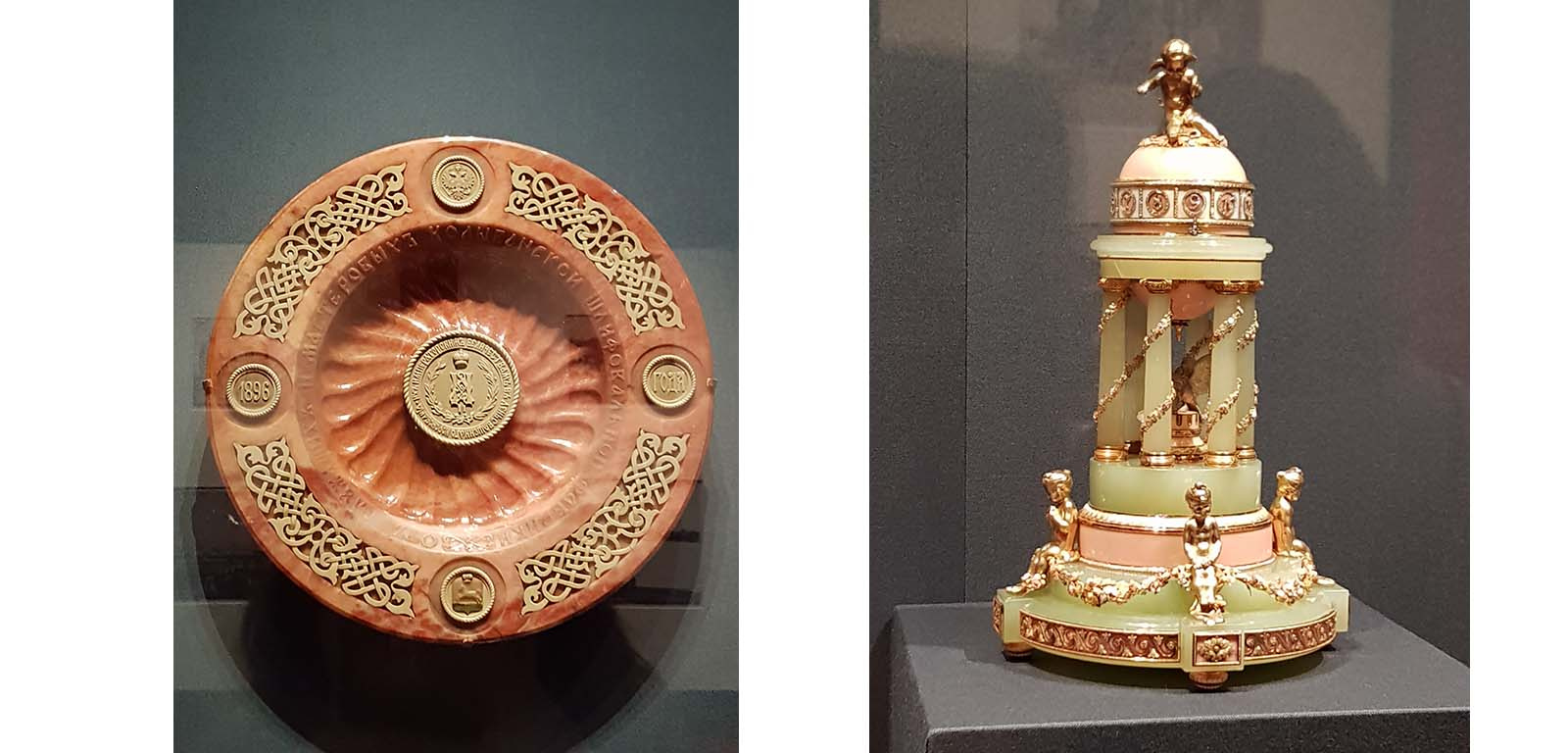
One of the greatest legacies of the late Romanov era was the stunning craft that was produced. The workshops of Faberge and other artisans produced pieces that pushed the boundaries of technology with patient skill and craft and won admiration around the world. As the political climate changed and Russia set on the path to a new future, the industry of providing the furniature and artisan crafts to the world around the royal court fell away. Above two pieces from the era of the last Tsar and Tsarina show a dish to commemorate the coronation of Nicholas II and one the many celebrtated Faberge Easter eggs in light Salmon Pink and Green. Below a painitng of the Tsarina Alexandra shows how tastes in court portraiture had moved into the twentieth century alongside those of other patrons across Europe and north America. Russia was no longer culturally backward in art. To the right below the celebrated Vladimir Tiara, now owned by the Queen formerly from the Russian Royal family collection. It's a majestic piece and something that looks like it should be worn at a present day coronation. Diamonds twinkle and large pearls would move gently as the wearer walks creating an effect of living luminescense.
